Silver City Sojourn + Truth or Consequences Tarry
Background
Since the trip last July, our desire grew to take in other parts of the Land of Enchantment, especially ones off the beaten trail, and to see the state in all seasons. Another motivation for a February trek was to celebrate Linda’s birthday for an age ending in a zero. Since both of us are uninterested in lavish, luxury snow skiing, we narrowed our focus to the state’s southwest corner precisely because of its dearth of such resorts.
Several friends suggested Silver City, where neither of us had ever been. We soon discovered that we already knew people there. Our aim was to investigate the flavor of Silco (the city’s nickname, from silver and copper): What made it unique? What did folks like most about living there? What was the town’s intention? Part of the answer was that Silco isn’t on the way to anywhere except mountains and wilderness, but not totally remote, either. It is its own destination: You have to want to go there to get there. So we did. And since Linda also knew someone in Truth or Consequences, our itinerary practically planned itself.
Start Here
Rolled out of the Austin home base at 6:20 a.m. on Friday, February 11. Took turns driving 100 miles at a time. First stop was Harper, Texas, in honor or our elder granddaughter. Along the way, thanks to Audible, we listened to several chapters of Braiding Sweetgrass by Robin Wall Kimmerer, a Native American botanist, and The World We Used to Live In by Sioux theologian, historian, and activist Vine Deloria Jr. Also while riding, we read aloud to each other from Aldo Leopold’s A Sand County Almanac, which bore importance to the places we were heading. Our music soundtrack was Eliza Gilkyson’s new Songs from the River Wind. Breakfast and lunch were quick snacks that first day. We made excellent time on clear roads.
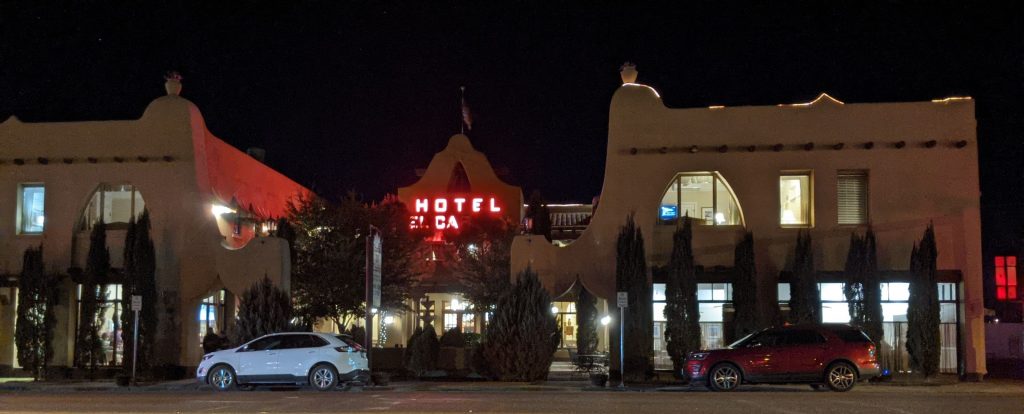
Like in previous trips, Van Horn served as an ideal first-night stopping place for a journey towards the setting sun. Recalling a deep past, the town, seat of Culberson County, was where my family slept after departing from Corpus Christi in the summers of 1965 and 1966 on our way to Arcadia, CA, when our dad worked in the Golden State a couple years. My mom, three sisters, and I accompanied him there for a month at a time. More recently, Linda and I first spent the night there during our 2014 drive to California and Utah.
After 468 miles spread over seven hours that initial day, we were ready to stop. Reservation in hand, we checked into Hotel El Capitan. Built in 1930 and restored in 2007, the style is iconic Pueblo with colonial mission touches. Its original purpose was to provide lodging for folks traveling between Carlsbad Caverns and the national parks of Big Bend and the Guadalupe Mountains. Sister structures include Hotel Paisano in Marfa and the Gage Hotel in Marathon plus others we would discover later. El Capitan’s facade has become Van Horn’s theme, just as the Texas Capitol symbolizes Austin. Two oversize red neon signs on the roof beckon weary travelers such as ourselves to its stylish shelter. We’d be spending two nights in this grand hotel on the journey, coming and going, for a total of three times altogether.
A friend had recommended the hotel’s margaritas, and they proved excellent. Next we gobbled up sumptuous dinners there that evening: veggie burger and pistachio-fried steak. A formal wedding happened across the fountain-centered courtyard while we looked on.

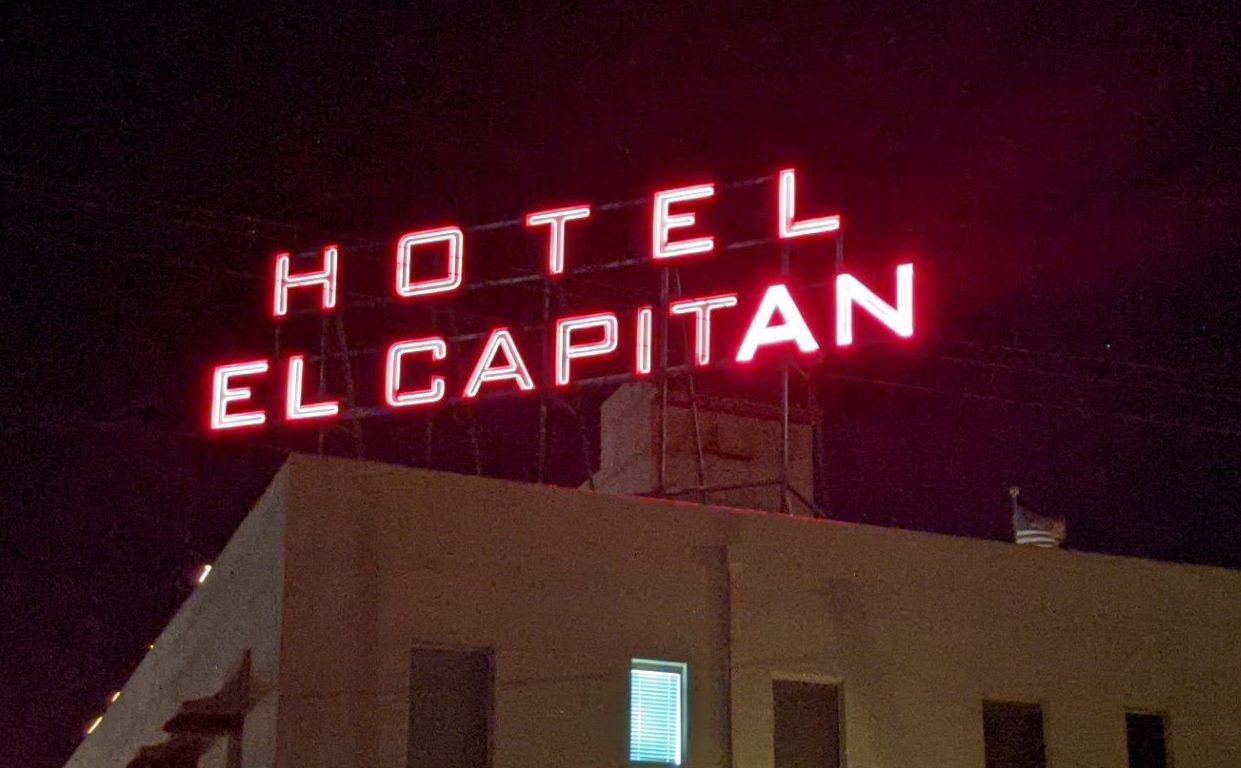
Mountain Standard Time
Early Saturday morning, I traipsed downstairs to the bar-cum-breakfast counter and brought up cups of steaming java. In the room, the corner desk provided an ideal surface to bring my journal and travel log up to date while Linda lounged a-bed. After clearing out, packed, and ready for departure, our free meal consisted of hard-boiled eggs, cheese, cereal, and juice.

After topping off the gas tank at Uncle’s ALON station, we were off again, soon crossing into Mountain Standard Time and gaining an hour. Winds gusted fiercely, slowing our forward progress. Along the way, Sierra Blanca indeed appeared as a white mountain, but not from snow.

We wanted to explore El Paso’s downriver communities. When New Mexican Puebloans revolted against the Spanish in 1680, colonizers and natives loyal to the crown fled south and established settlements in what’s now Texas with names of their former missions. That’s why Texas and New Mexico both sport a Socorro and an Isletta or Ysletta. We made sure to visit these sister communities, beginning with the San Elizario chapel, which served a presidio in 1789. The church there was closed for remodeling, but we lucked into a tour of Los Portales Museum just across the street. This is one of the oldest homes in the El Paso area. There we learned about wedding customs, genealogy research, and the 1877 Salt War, the latter of which figured in our itinerary later.
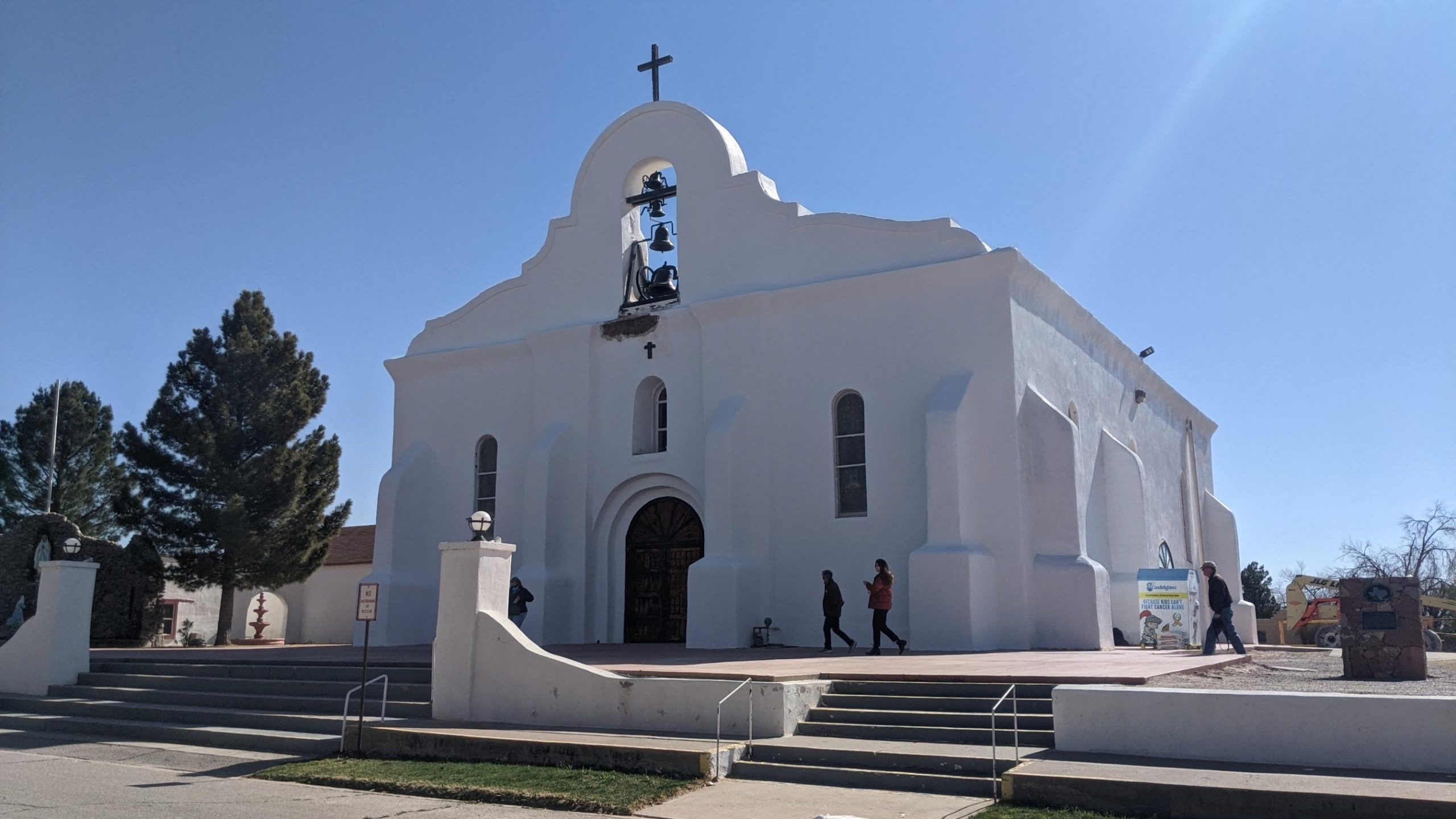
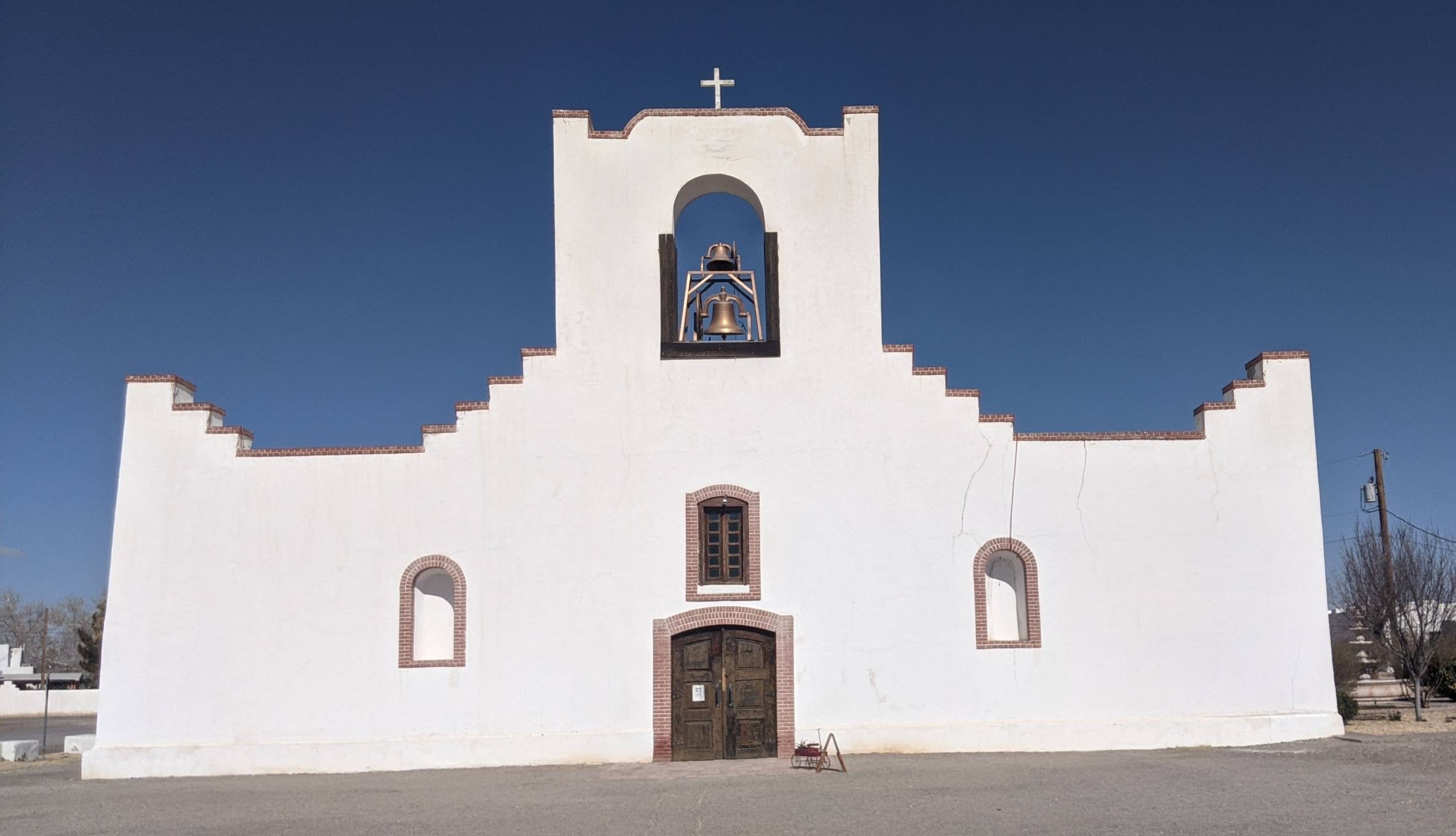
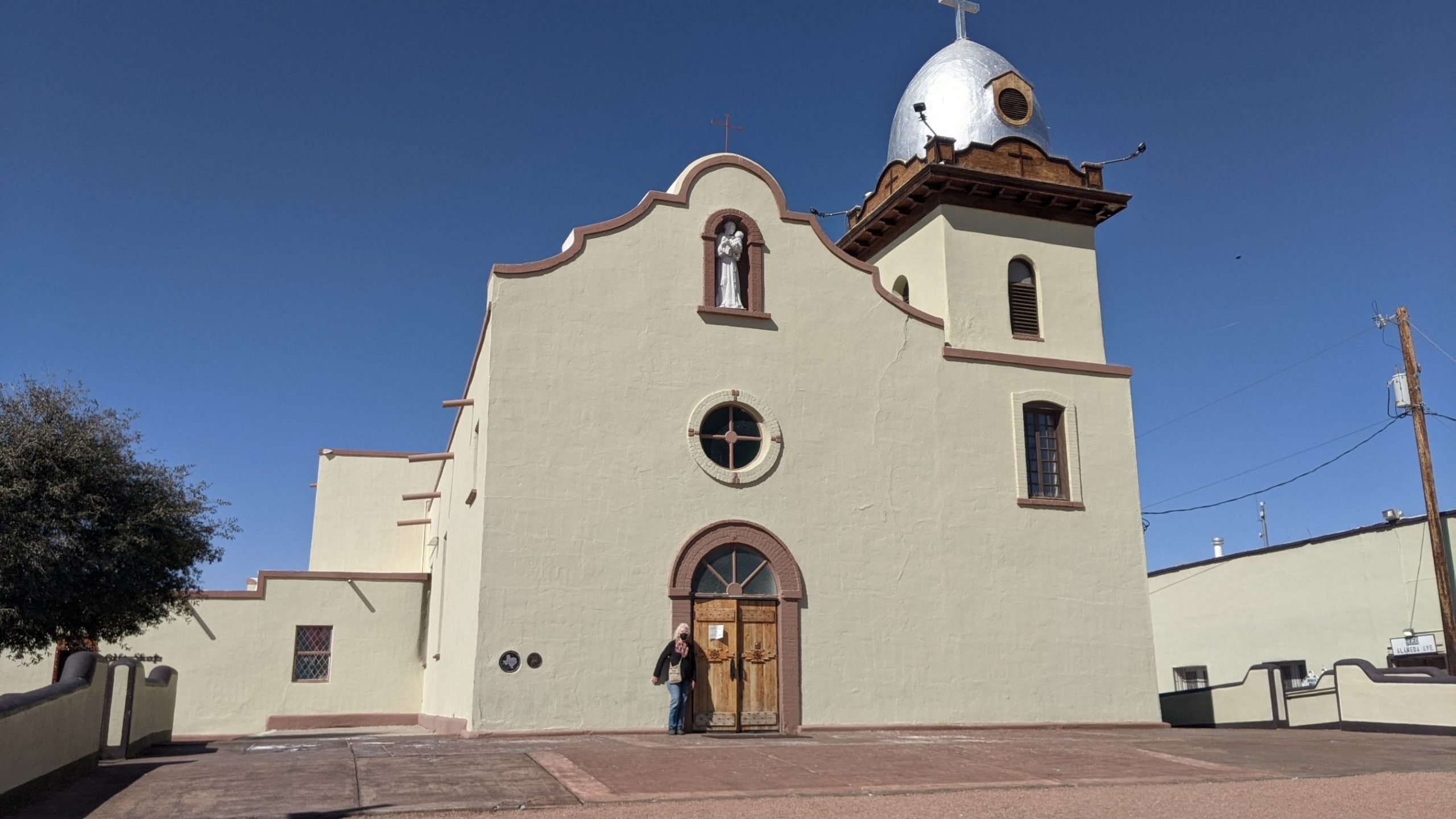
Exploring upstream along the Rio Grande, Socorro came next, followed by Ysletta, where a funeral had just concluded. We stepped inside and marveled at the iconography and sacred arts, including Jesus in the tomb.
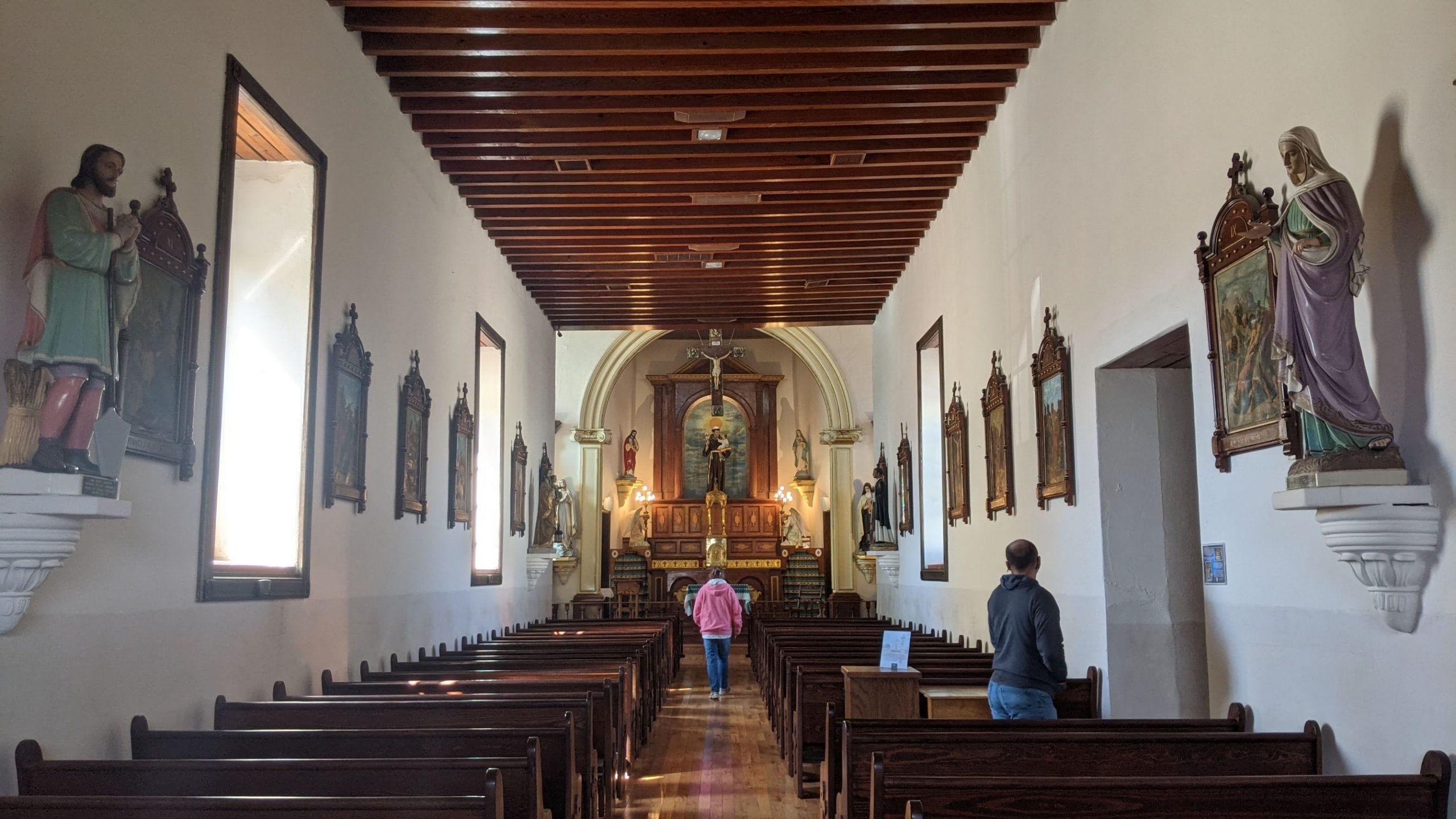
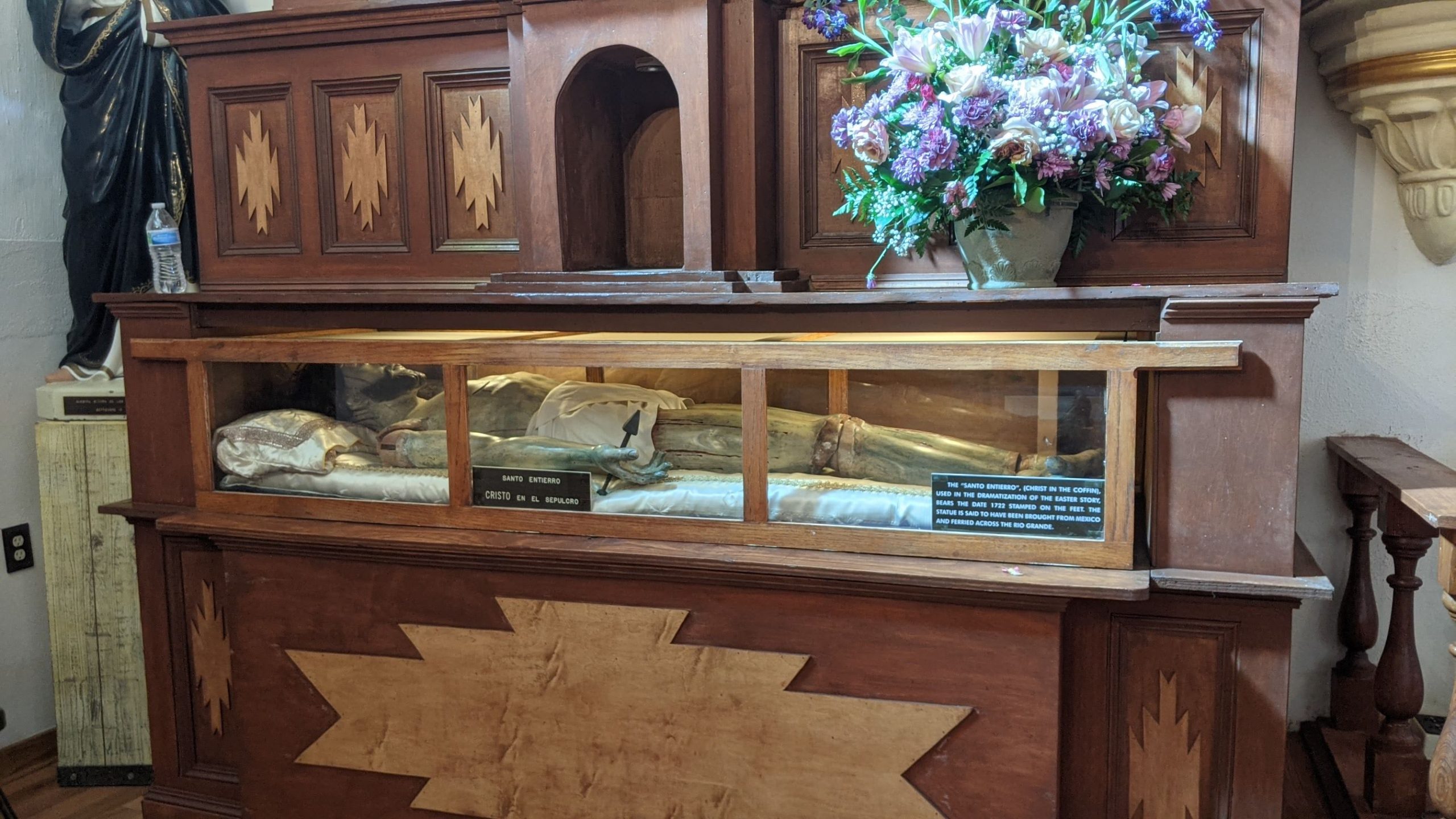
Ex-Texas
Lunch consumed in the parking lot, we pressed on. El Paso traffic daunted. Once through the snarl, we at last passed Mile 0 and welcomed ourselves to New Mexico. Veered west at Las Cruces and found no water in the Rio Grande there.

Few things bespeak kitsch as thoroughly as roadside attractions between Texas and California. Again we stopped at Akala Flats like we did in 2014, but spent no money either time. Florida Mountains loomed over Deming. Travel north and west on US 180 is often slowed by sandstorms, as signs attest. This day for us was clear and calm. You couldn’t ask for a straighter road. We gradually climbed in elevation from Deming’s 4,337Ꞌ towards the Piños Altos Range. Took notice of Howie Morales Stadium at Bayard (he must be a fine fellow) and felt our excitement soaring several notches as we passed Silco’s city limits.
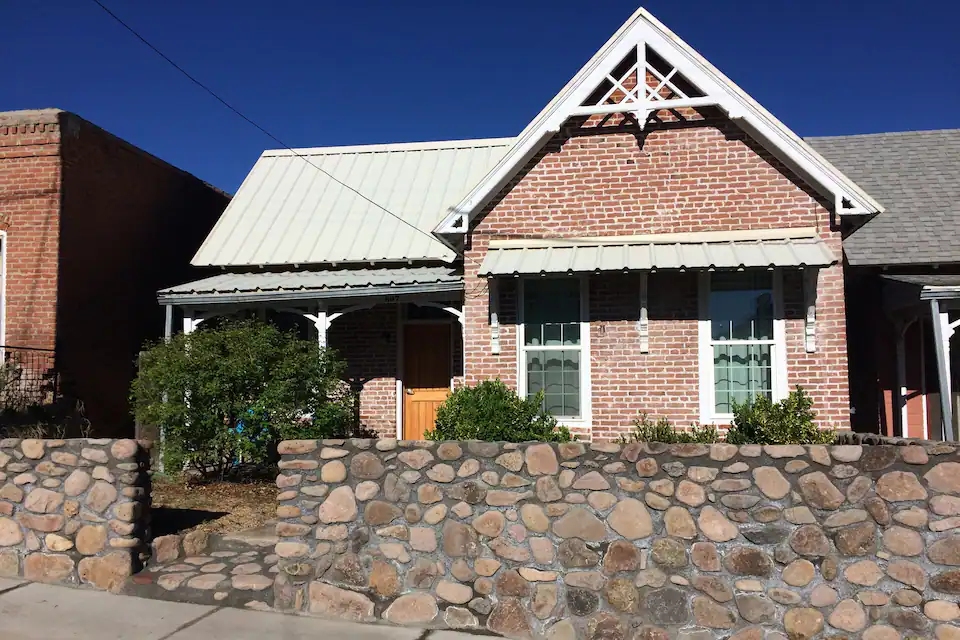
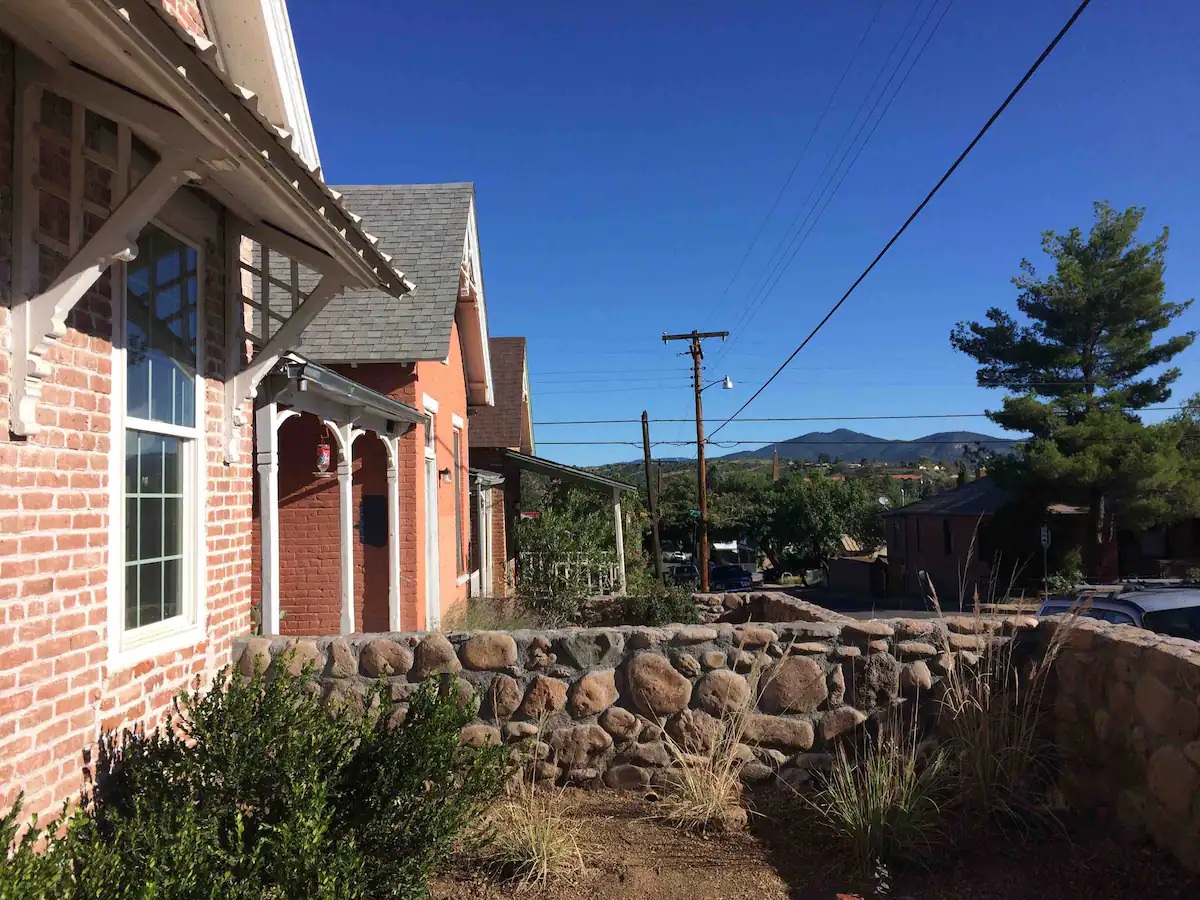
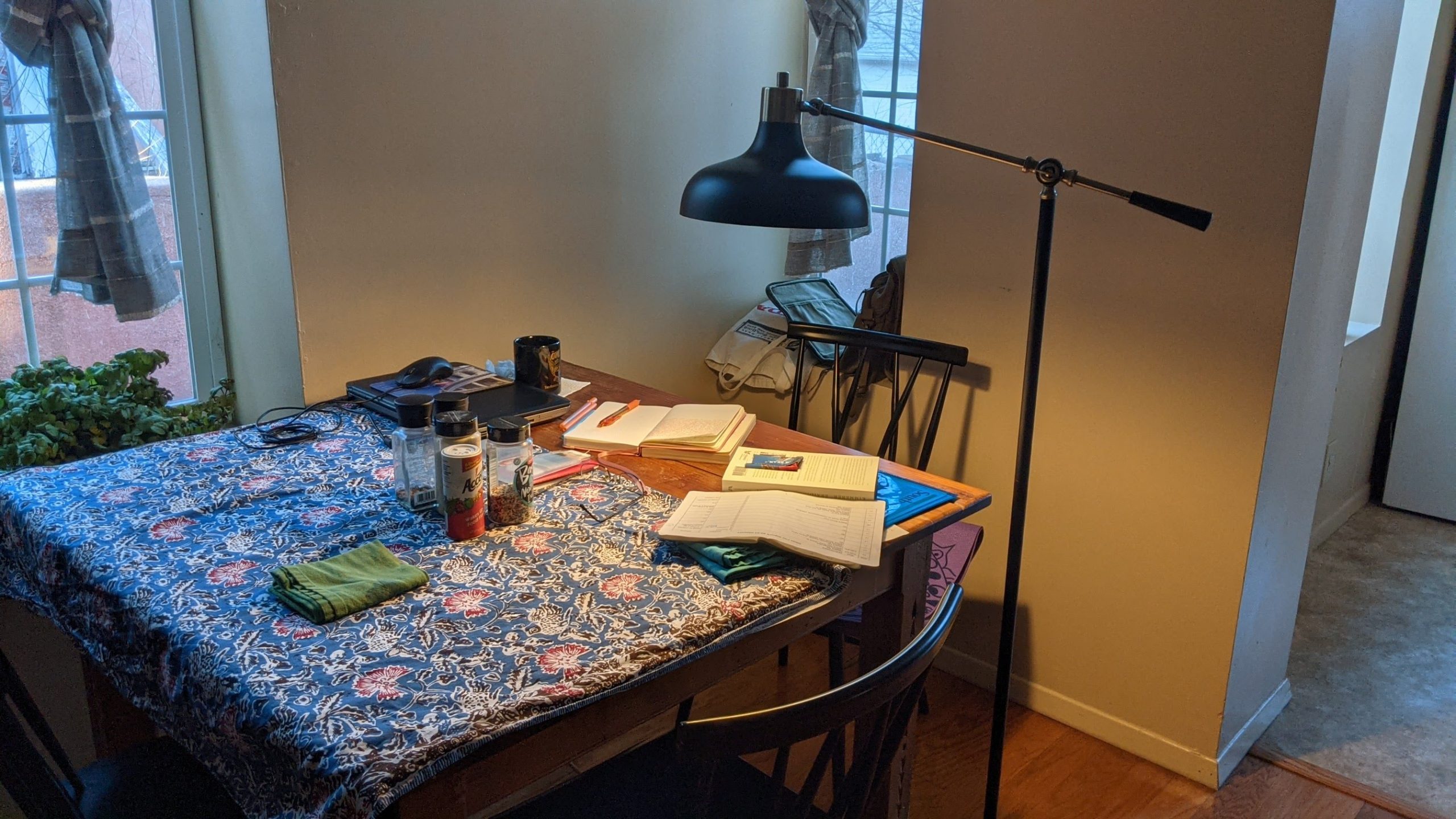
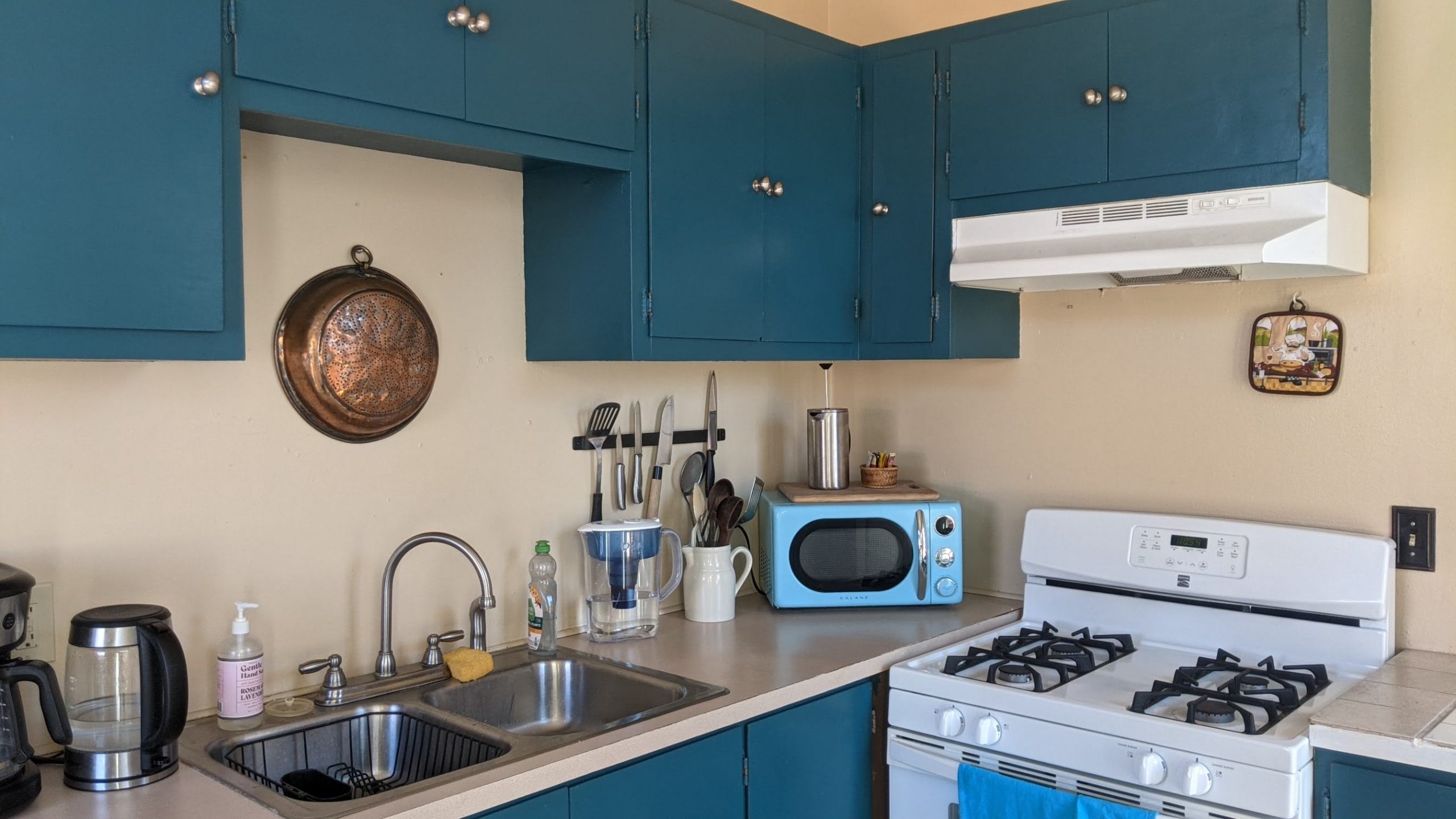
At elevation 5,924Ꞌ and 3:25pm, we parked on Cooper Street in front of Desert Cottage, a two-bedroom rental that would be our base for six nights. Dating from 1884, it and others on the block served as miners’ housing during the city’s mineral booms of the late 19th and early 20th centuries. In we moved, rearranging furniture to our liking. For her art-making, Linda got a small desk by an east-facing window in the front bedroom while I sprawled onto half of the dining room table. Thick brick walls made deep sills. All amenities were new and swanky, delightfully comfortable.
Getting Oriented
Silver City is eminently walkable. Our first stroll took us from the rise on which the cottage sits five blocks to Bullard Street, the main drag through historic downtown. We found old-fashioned, diner-like Nancy’s Silver Café and chose green chile rellenos and green chile stew with meat. Both exceeded our expectations. At Bullard and Broadway stands Little Toad Creek Brewery and Distillery, which immediately became our favorite watering hole. Tried the Pendejo Porter and Grumpy Old Troll IPA, washing them down with shots of TeGila Silver Agave. We thoroughly warmed to the community.
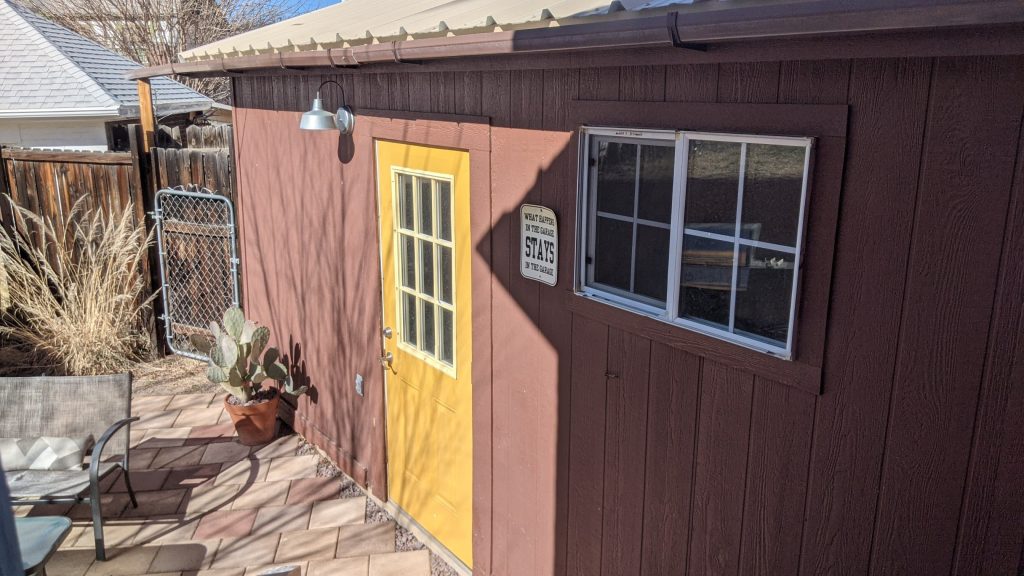
Sunday the 13th dawned clear with 20-mile visibility and 21°F. I made entries in my journal while sitting at the table and peering out a window to my right of the neighboring house’s red-brick wall. A window behind me let in sight of the wee back yard and roofs across the dirt-road alley. We dripped coffee, rustled up some breakfast from our supplies, and planned our first full day.
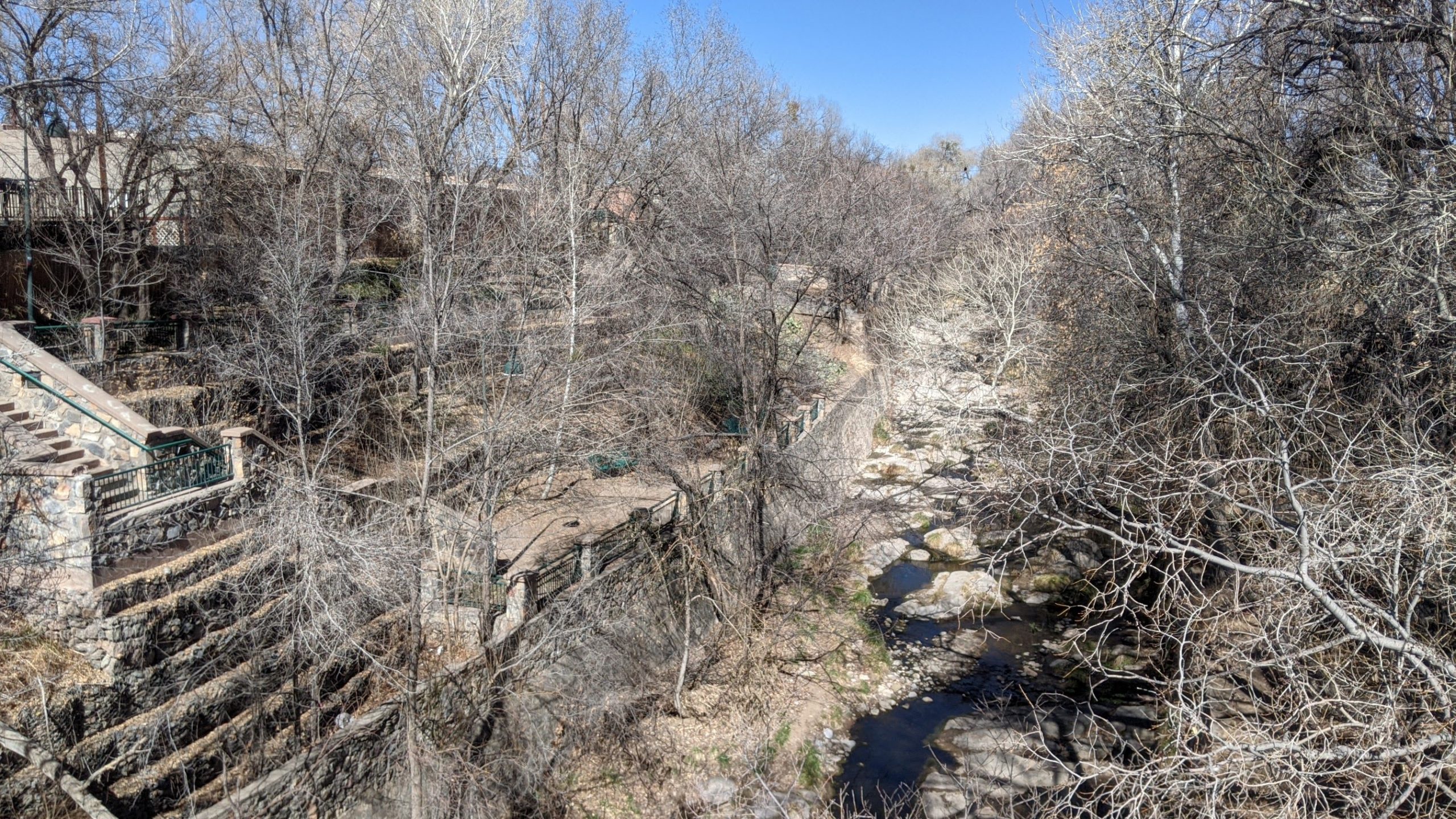
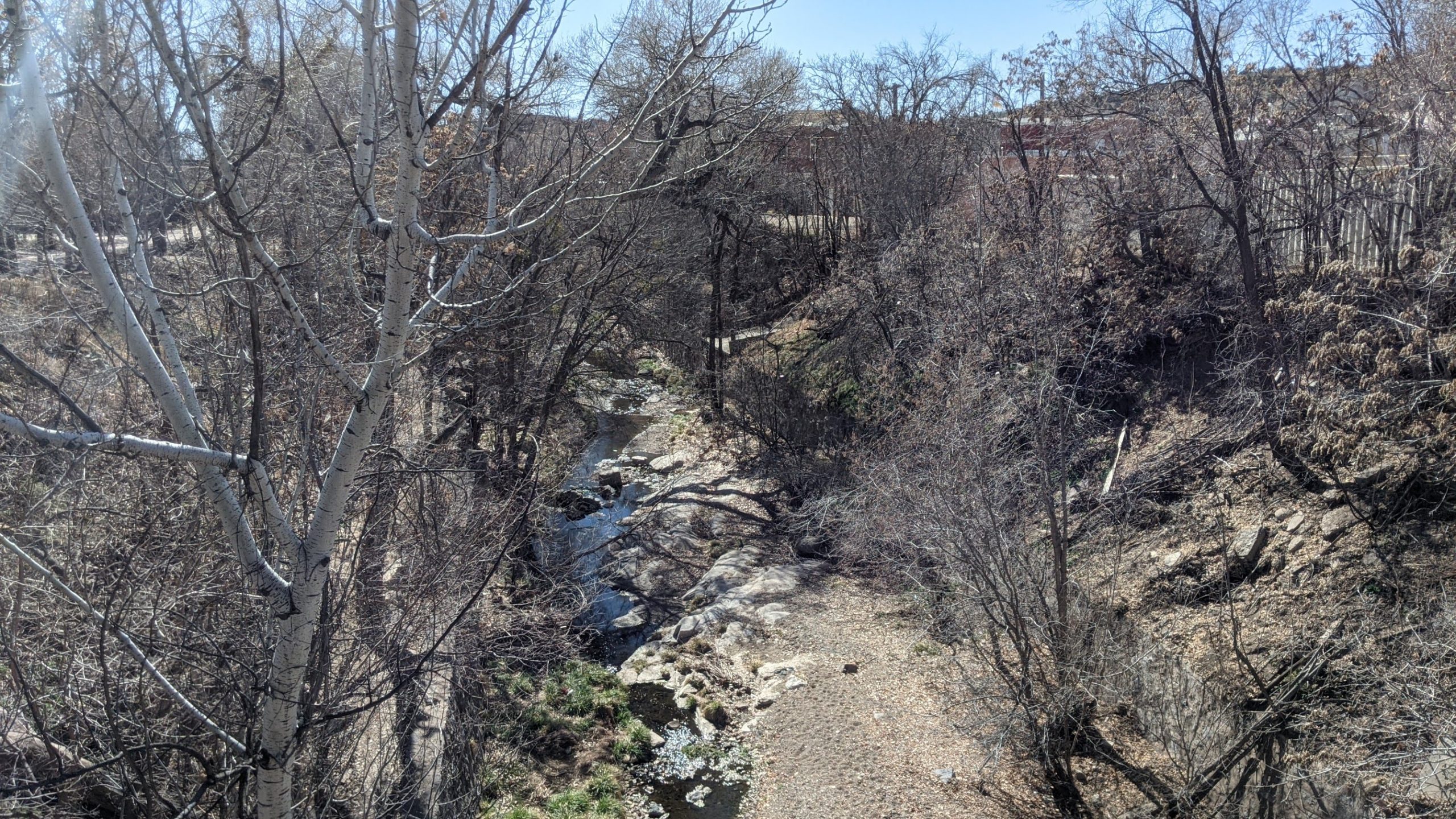
Stepped down to the Visitor Center, where one Janelle, who recently moved here from Texas, remarked that Silco could easily rival Austin in weirdness. Loaded with brochures and maps, we strolled the Big Ditch, a deep scar in the earth along what was planned as Main Street, but resulted from clear-cutting the watershed, which caused major floods between 1895 and 1906. The city converted the eyesore into a greenspace with trails, benches, and bridges. A few blocks away, the Hub used to be a car dealership; now it offers shops, eateries, and a letterpress print shop. We procured sandwiches from Diane’s Bakery and Deli. Catty-corner sits the SC Food Co-Op, which perfectly mirrored Austin’s Wheatsville. We toted a bag full of organic groceries back to the cottage.
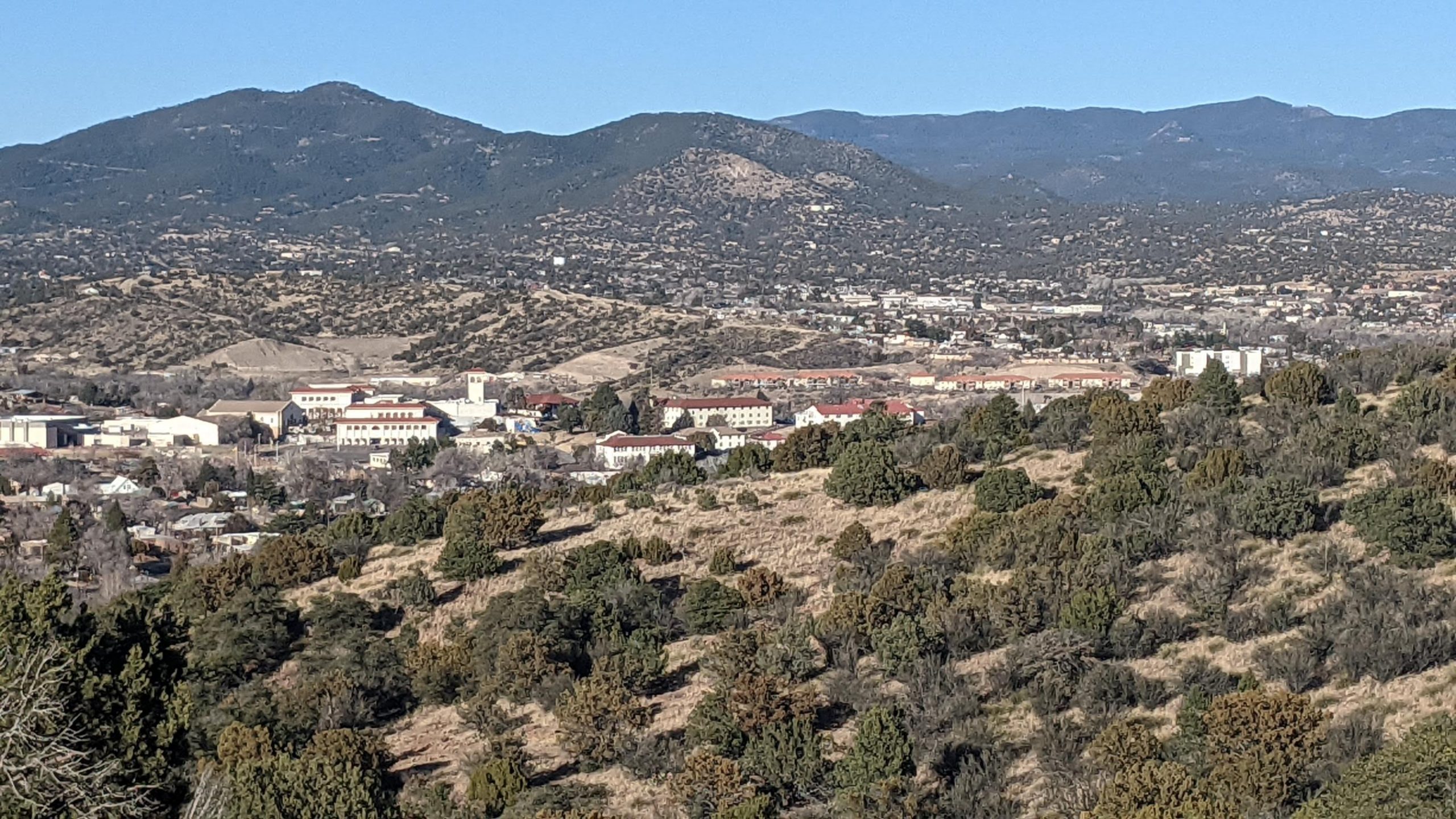

After a brief lie-down, we hiked to Boston Hill, an elevated open space sporting trails and expansive views of the town. Joggers and birdwatchers greeted us. Numerous prospect holes and abandoned big digs attested to the mining that gave birth to this settlement. We tried with limited success to photograph a herd of mule deer. Notable landmarks from the elevation were Western New Mexico University and St. Vincent de Paul Church’s twin steeples. It was a good, long walk.
Returned to The Toad for sips, avoiding most of the Super Bowl brouhaha. Made a mental note to seek green chile vodka. Back at the cottage, we poured over the literature we’d collected. One brochure highlighted all the mining activities nearby. Learned that a movie, Salt of the Earth, had been shot here in the 1950s and gave a fictionalized account of an actual miners’ strike and its aftermath. We viewed that remarkable film after returning to Texas.
Romancing and Roaming
Valentine’s Day meant cards, candies, and kisses. The waxing Snow Moon set behind the garage to our west. First stop that morning was the art-deco Murray Hotel ballroom for a basic Tai Chi class. Unlike the one we attend in Austin geared for seniors, this session was more general and traditional. “Yang-Style Long Form” meant that our movements proceeded slowly. Instructor Anna Dye from Finland leads courses several times a week along with her husband, John. She holds a master’s in ethnology while he professes neurophysiology. He was to teach a course on Tai Chi with weapons later that week. We also met a fellow called Cartston, who recently became a Silco citizen, then saw him everywhere after that.
Two blocks away stood Tranquilbuzz Coffee House, a celebration of handcrafted woodwork, local art, and tasty brews. Mine was espresso. Sitting outside, we met Brigit and Chris, who moved from Montana 14 years ago. Their son attended the Aldo Leopold Charter School (ALCC) here. They gave us lots of tips on day trips to the mountains and other activities. People were mighty friendly here!
SWAG (South West Adolescent Group) operates a thrift store over on Hudson Street. There I procured a booklet about the Mogollon, a prehistoric culture centered in this region. Silco exhibits half a dozen charity shops, each open on a different day. Cartel? From there, we meandered past two closed Mexican restaurants before finding the open Las Consuelas, which consoled us with a bowl of beans and a combo plate built around (you guessed it) green chile.
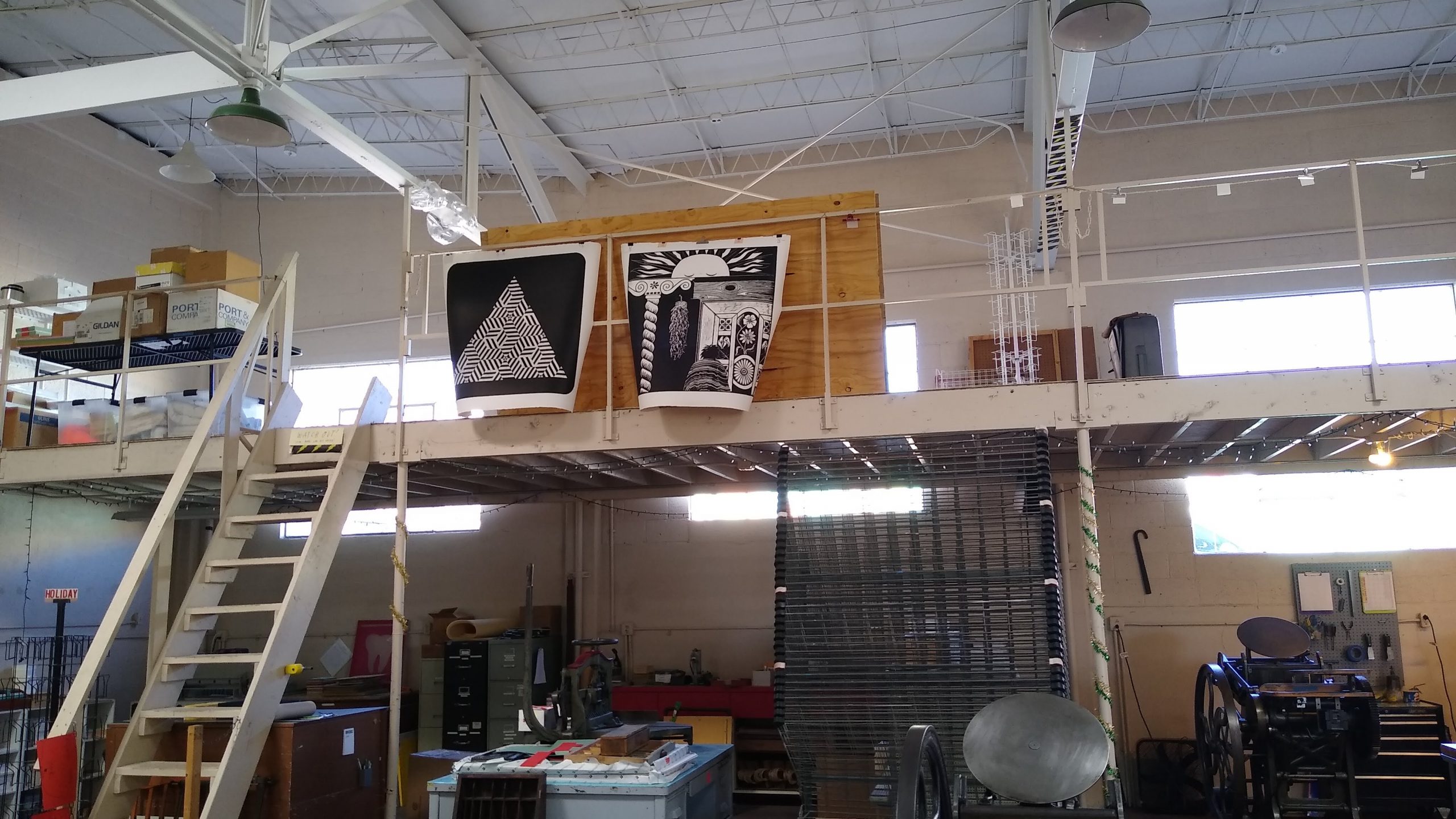

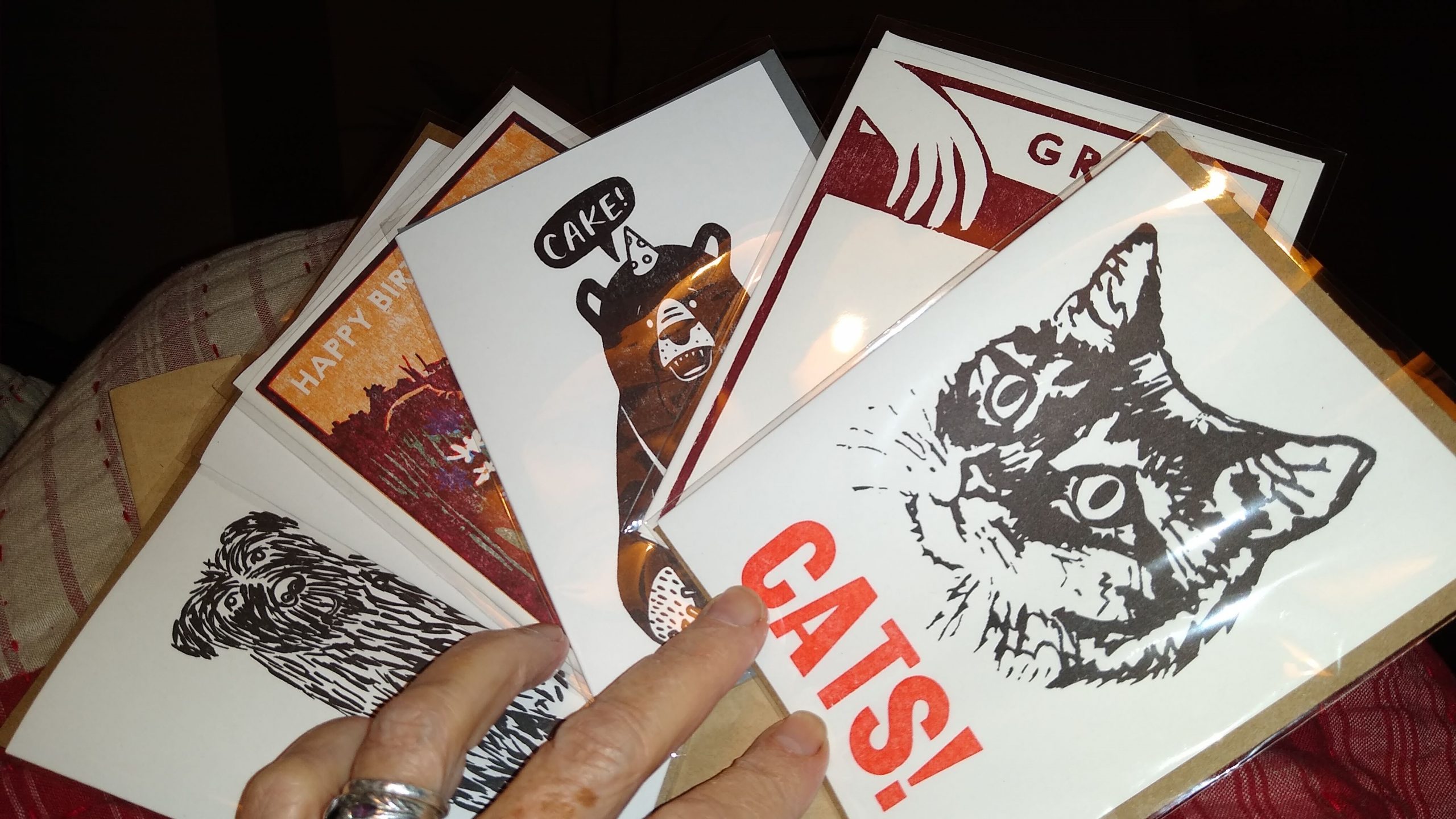
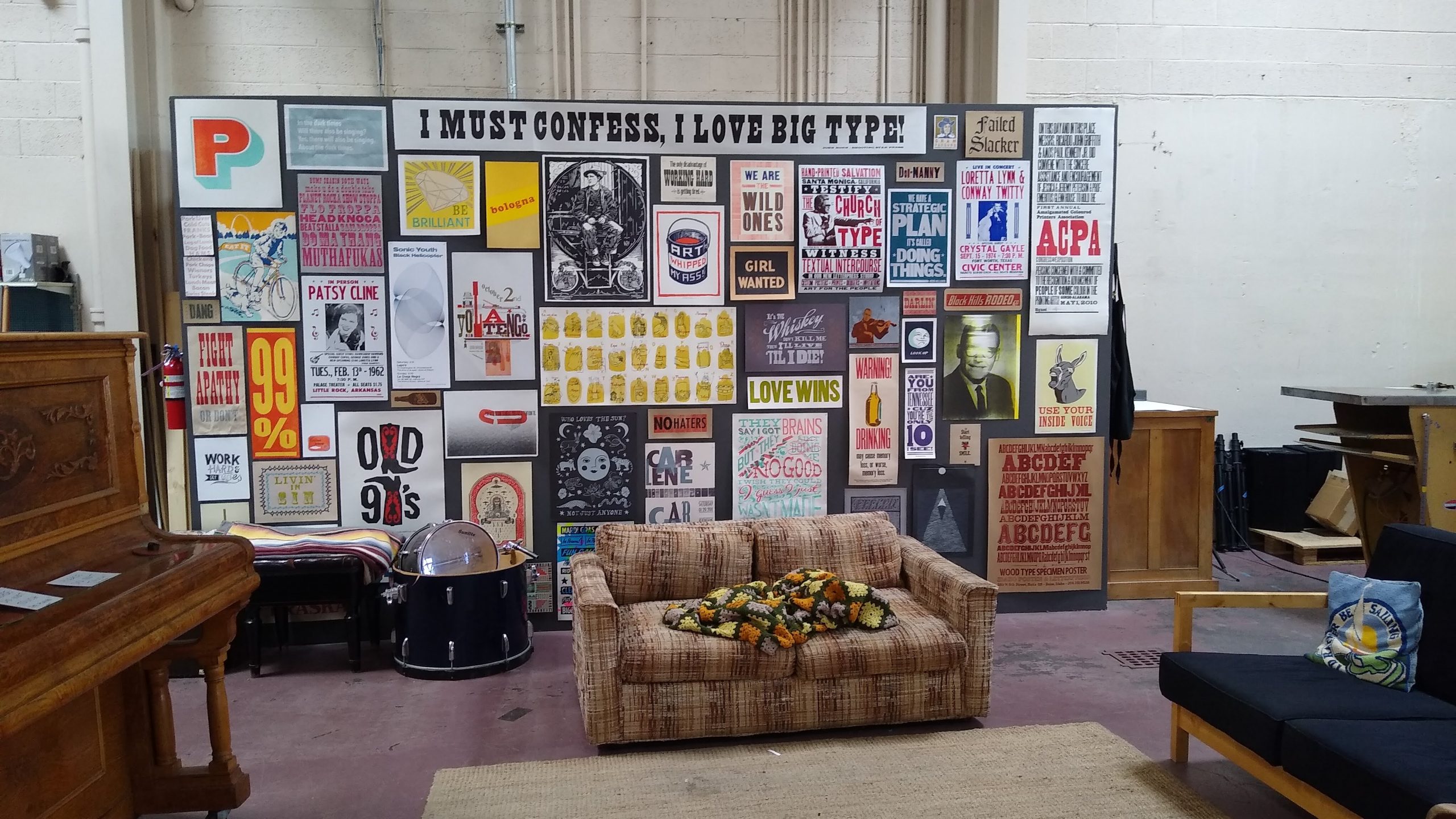
Kyle (last name withheld) runs Power and Light Press from a corner of The Hub and offers hand-cranked letterpress cards and posters. Linda had met the founder of this unique gallery/studio when Kyle toured her wares in a funky refurbished panel truck and made a stop at the Austin Book Arts Center. Inside the space are two Heidelberg Windmill presses and several smaller machines. Aside from paper products, for sale are tote bags, books, and used records.
Once more into the food co-op, I emerged with a box of Barbara’s Morning Oat Crunch because I’d left my breakfast cereal in ATX. Laden with leftovers, souvenirs, and sundries, we returned to our digs and settled in for the evening. The morrow would be a day of travel.
Hitting the Heights
Tuesday the 15th bestowed a meteorological visibility of 34 miles! The Who would be pleased. After acquiring forgotten swimwear at a way-too-big box store, we trended east past the gigantic Santa Rita open-pit copper mine. In operation since 1799, it is was one of the industries that gave rise to this area’s prosperity. We found no adequate observation point for this deep scar, but hurried past its embarrassment. Our society has decided to lay utter waste to certain unlucky places to (in theory) benefit the whole. Some spots on earth are completely destroyed, sacrificed to give us in this restless culture a bit of comfort and convenience. I’m guessing that most of the mine’s wealth left the state.
Our chosen route that day is known as Trail of the Mountain Spirits, an official scenic byway according to the Federal Highway Administration. Past the mine and its guardian Kneeling Nun Mountain, the pavement descends into the valley of the Mimbres River, an endorheic stream that never finds the ocean. Instead, all its moisture spreads out over the desert plain around Deming and disappears. Here, though, after turning north onto NM 35, we saw current, wet places, and greenery. Missed the Mimbres archeological site, which displays characteristic black-on-white pottery crafted by that prehistoric Mogollon pueblo culture.
If this trip had a subtitle, it might be Adventure Along the Great Divide. On the upper reaches of the Mimbres, we crossed the Continental Divide, which snakes a tortuous path through these Gila Mountains. The Continental Divide Trail is a fab way to experience this high ground on foot. A new vista opened for us to the northwest. We could see a snow-capped mountain in the far distance—Whitewater Baldy, perhaps, at 10,899Ꞌ.
Stopped briefly at Lake Roberts for a photo of that wind-swept water. Turned north onto NM 15 and used low gear to navigate the 10- and 15-mph hairpin turns that led us down, down, down into the Gila River basin. Three prongs of this river converge up there and flow west to the Colorado at the California border. Gila Bend, AZ, where we spent the night on our way to the Golden State in 2014, sits on this very stream.
Portal to the Past
The road dead-ends in two forks. The first took us to the visitor center. Signs there noted that no trash cans are available because no waste pickup exists. We’re encouraged to take away anything we bring. On display were artifacts from people who lived here and specimens of endemic biology. The video presented an excellent, moving overview of the ruins we were about to see. Aldo Leopold was honored for his role in preserving this wilderness with quotes inside and a plaque outside. Another monument informed that the great Apache warrior Geronimo was born on the Gila’s headwaters.
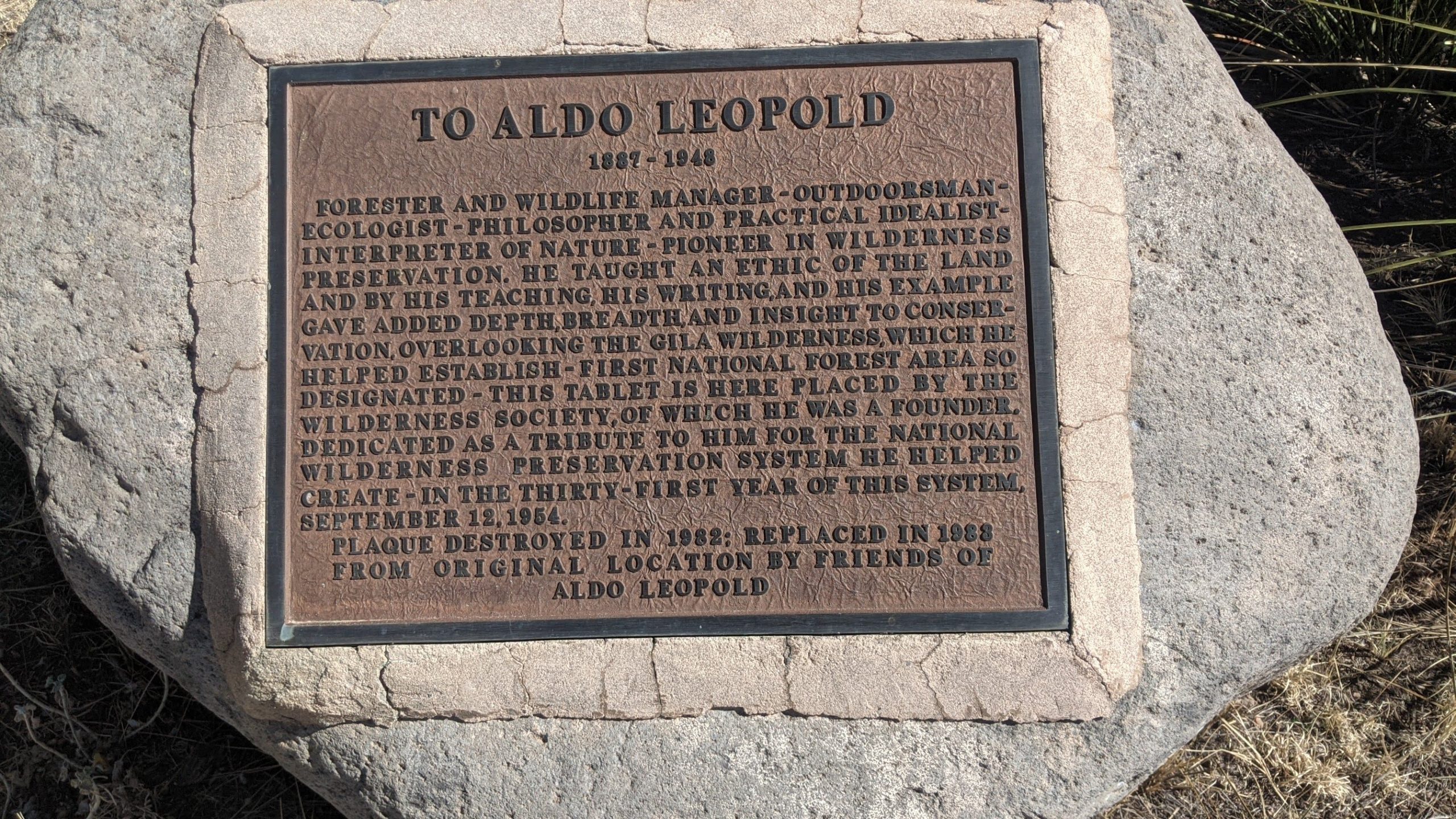
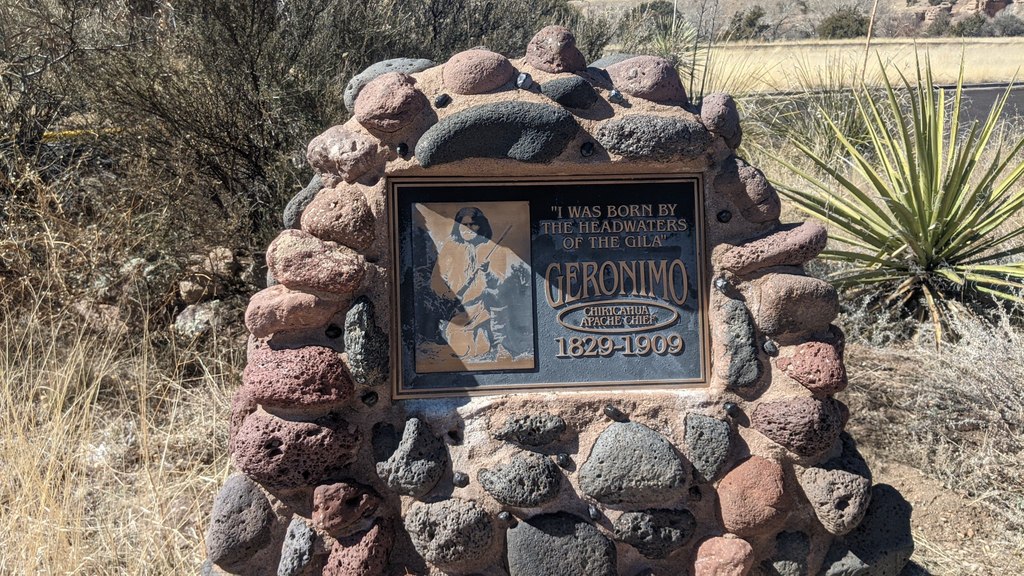
At the terminus of the other fork, we parked next to a ranger station/gift shop, where a uniformed official debriefed us on how to navigate the trail: carry water, bundle up against the wind, stay on the path. A merry creek laughed beneath us as we climbed into the narrow canyon. Suddenly the several substantial caves came into view. Some 40 rooms were built into the five hollows here, accommodating 10 to 15 families. Astounding was that this community stayed here for maybe only 25 years before moving on. The roofs of the chambers are still blackened from fire soot, and 700-year-old corn cobs yet litter some floors. We took in expansive vistas from the thresholds and braved the tall-ladder-climb down one sheer rock face.
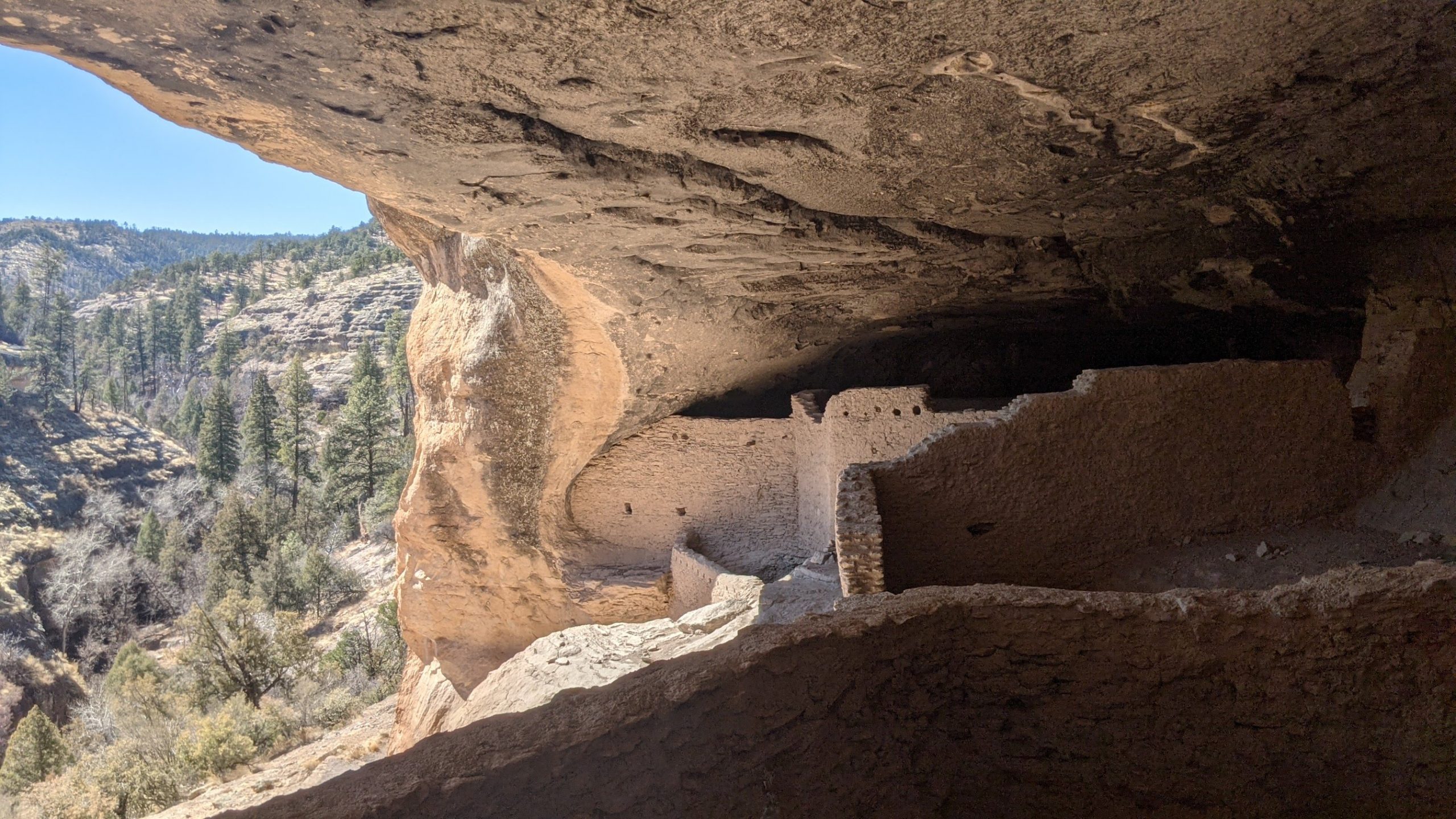
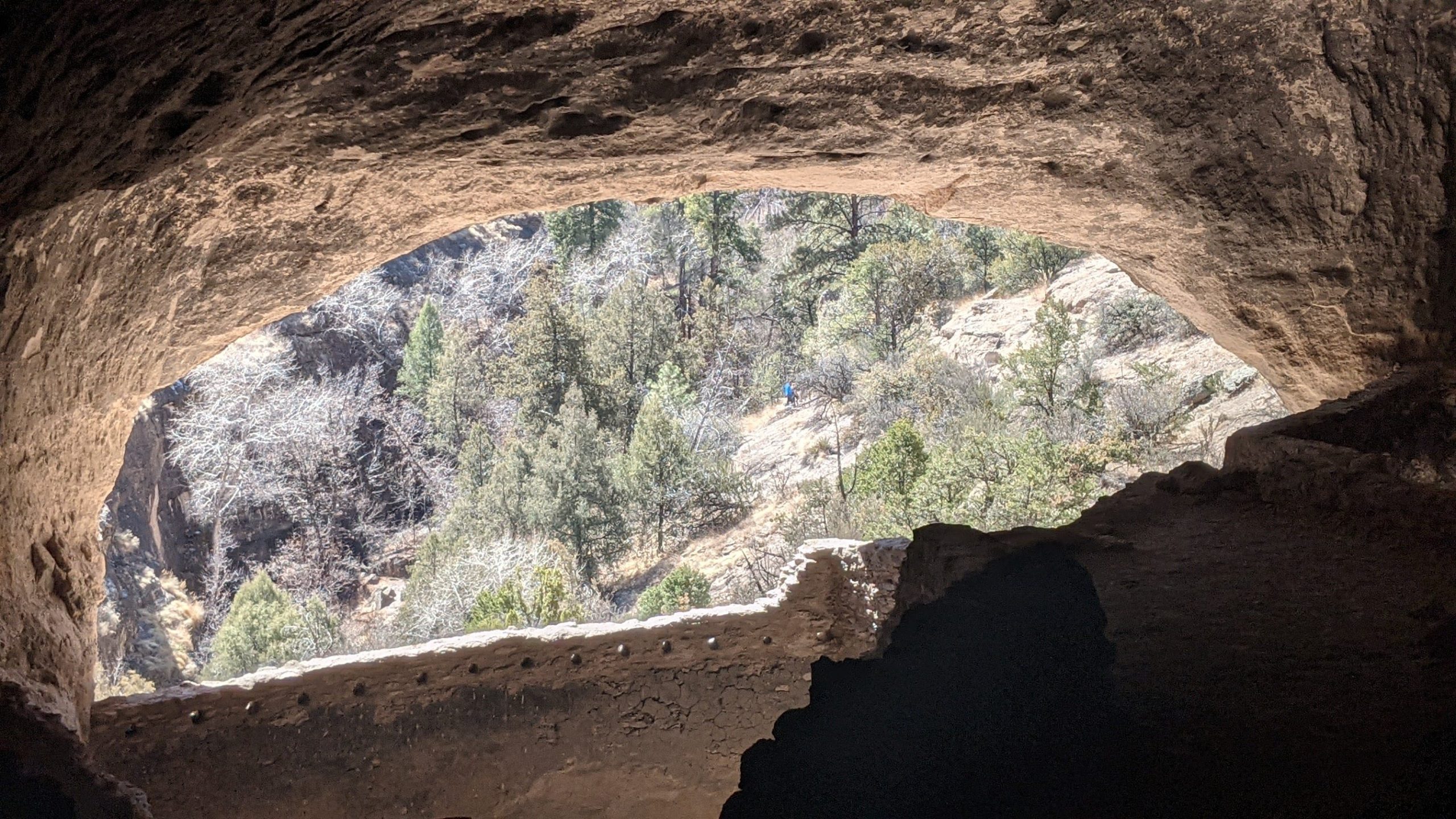
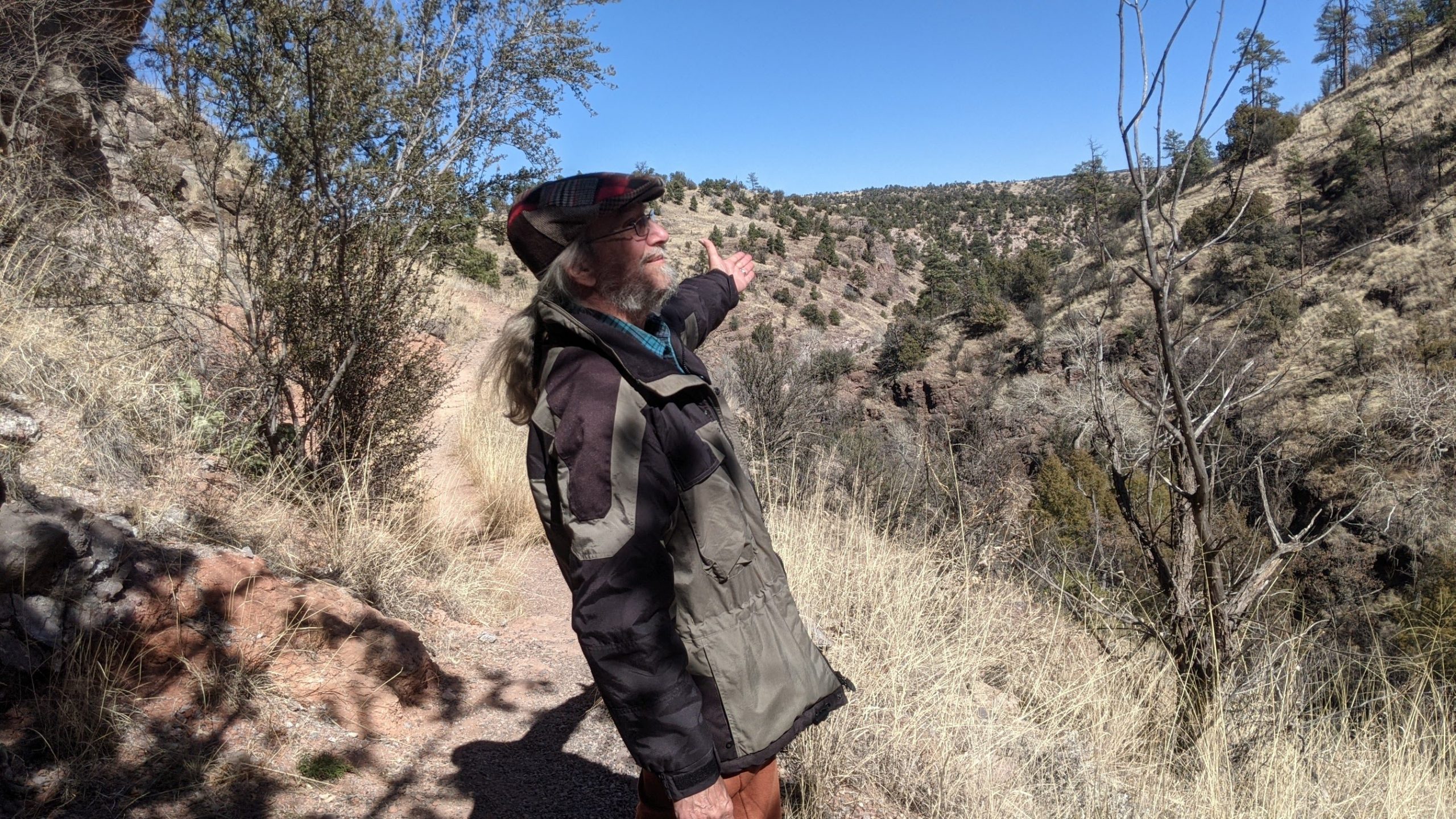

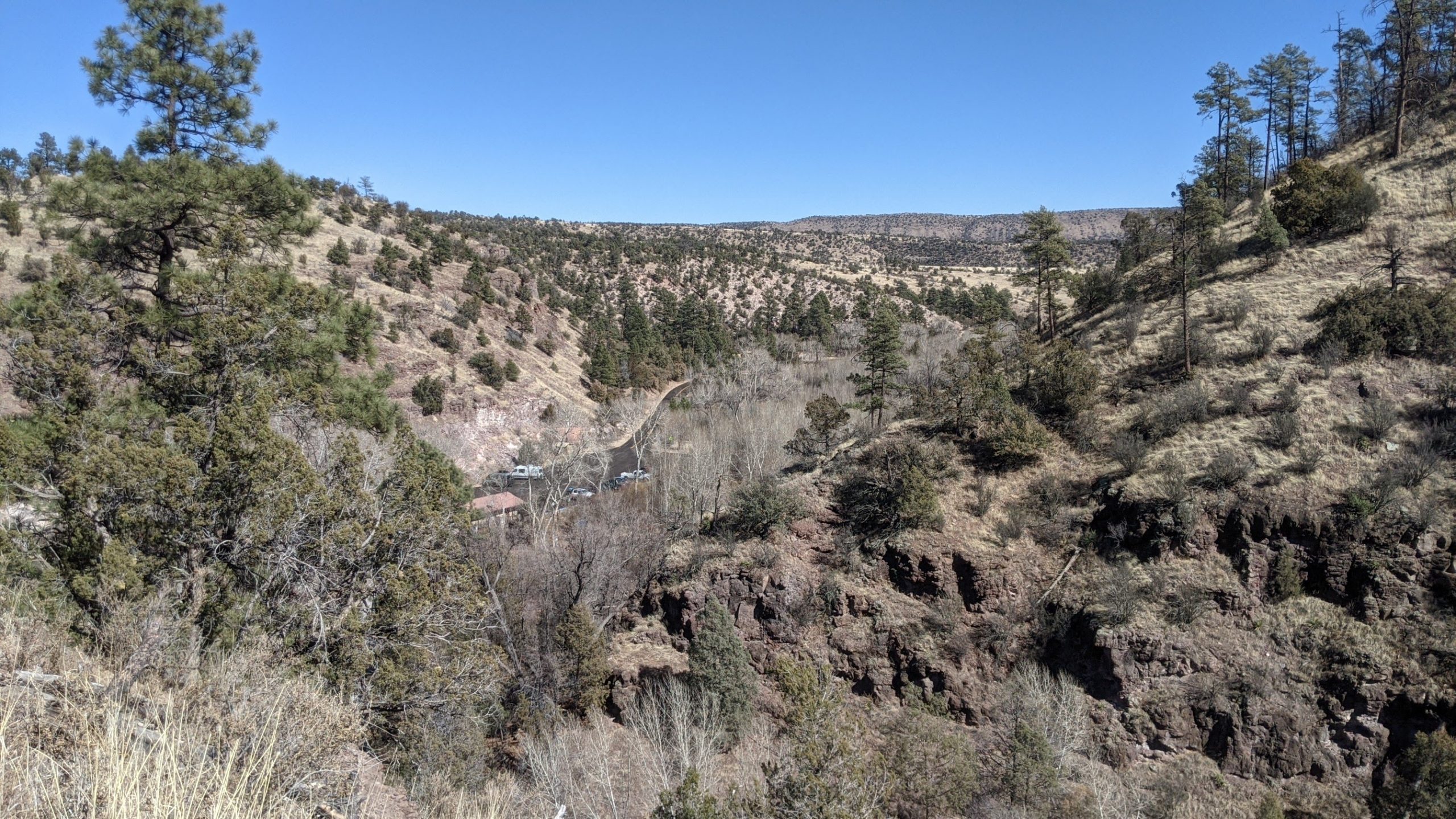
A different trail led us back. Along the way, we saw vestiges of snow on the enshadowed path. A National Park Service sign nicely summarized our newfound awareness:
The Journey Continues. For a variety of reasons, Mogollon families walked away from the cave dwellings in the early 1300s. Though the culture is gone, the story carries on through descendants who are still here. Modern Pueblo peoples trace their ancestry to the Mogollon through shared traditions, pottery designs, and beliefs.
Our ancestors are still alive. They did not go anywhere. They did not disappear. We’re still here. -Zuni Rain Priest Ronnie Cachini
At the vehicle as we munched our lunch, a magnificent raven requested nibbles, which we obliged.
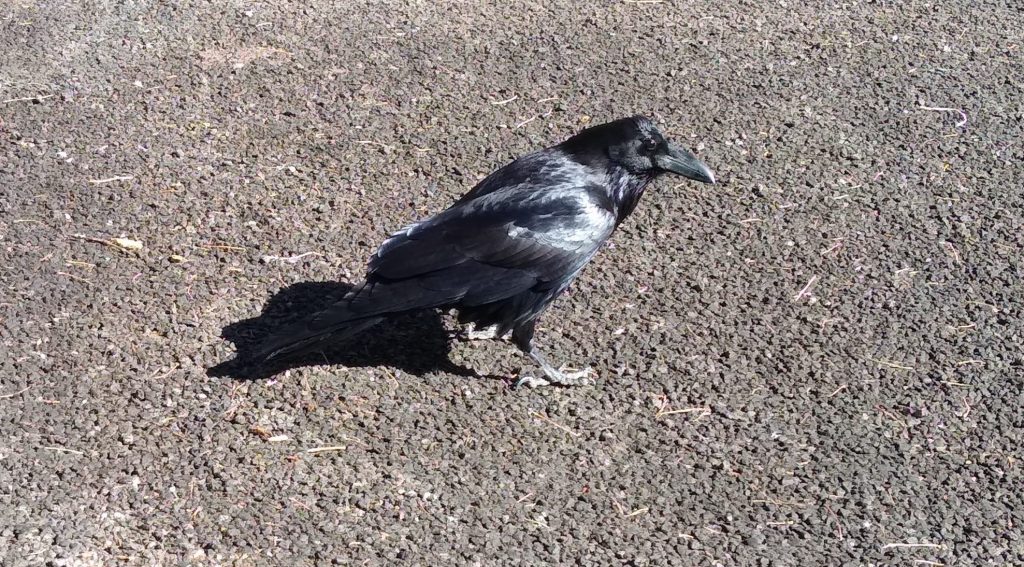
South again, we headed to Gila Hot Springs, an RV park and campground. Overlooking the Gila’s West Fork, we spent a good hour absorbing the steaming, soothing, healing waters in one of three soaking tubs. Proprietor Allen Campbell regaled us with tales of his family’s establishing this miniature resort and the best times to visit.
More harrowing turns and slow-going got us to the village of Piños Altos, the original seat of Grant County, established in 1860 around gold mining. I ducked into the Old West Buckhorn Saloon for a couple shots but missed the darkened Opera House next door.
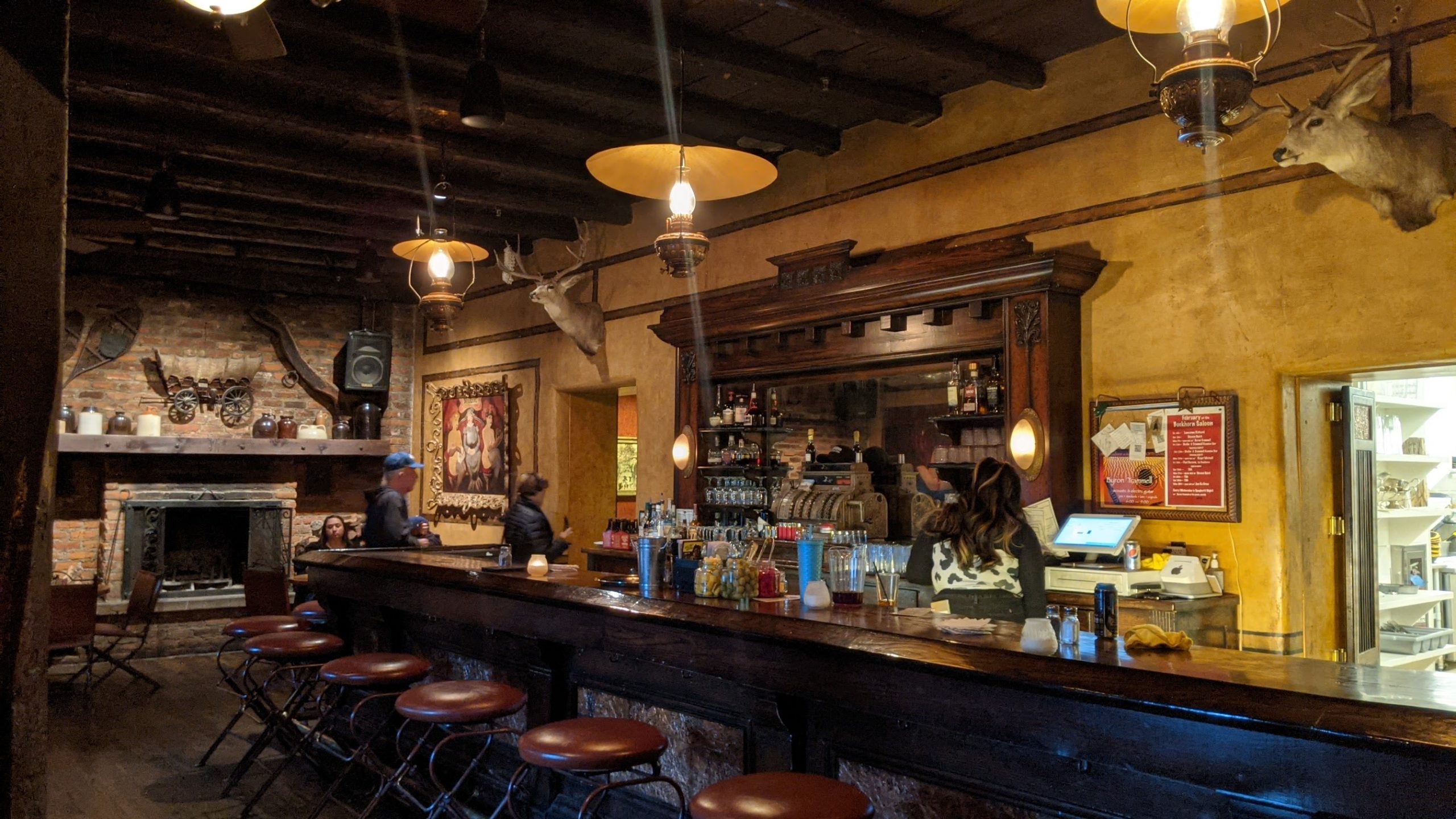
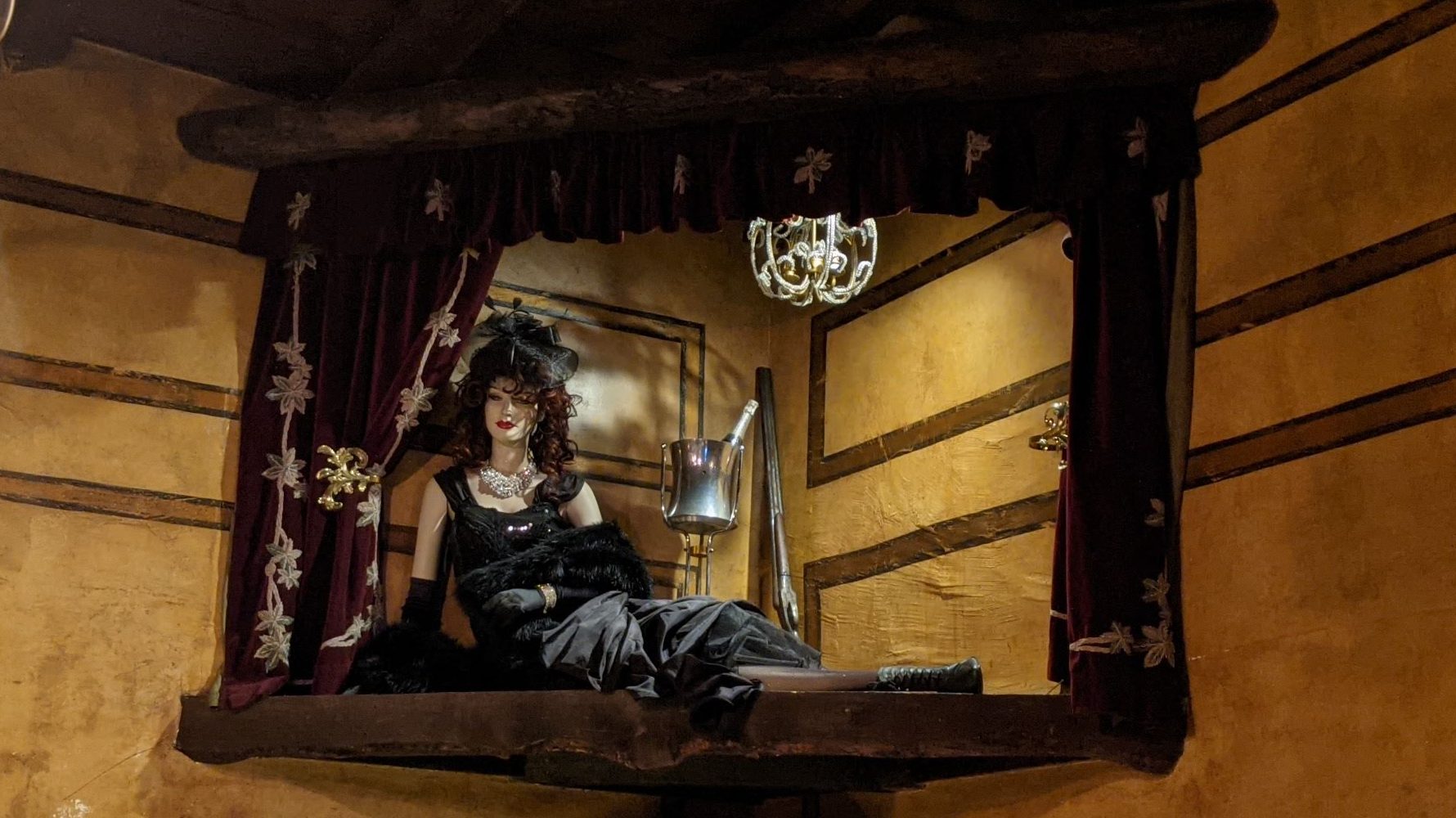
Here we crossed the Great Divide again, reentering the Mimbres River watershed. Within 15 travel minutes, Silver City’s local Market Basket sold us unknown brands of groceries and cans of Little Toad Creek Pendejo Porter. We settled in for the night, reflecting on all we’d experienced.
Vintage Familiars
Linda’s 70th birthday began on February 16 with above-freezing temps and a humorous happy card awaiting her delight on the breakfast table. Having made arrangements to meet Kerrville Folk Fest friends this morning, we hiked down to Javalina Coffee House, which is proud of its relaxed and quirky atmosphere. There came Maverick, who moved to Silco from Austin in 2015, and Merri Lu and Rick, who are still in their first year of residence in the town. We all reminisced about how the festival has enriched our lives and caught up on the events that brought us together in Southwest New Mexico that morning. I asked them, what’s the allure of this place? Harmony, Merri Lu answered, not unlike the atmosphere at the folk fest itself.
Clouds gathered quickly, and we returned to the cottage just in time to greet Patty H, hostess of our adventure last summer. She nested in the second bedroom and spoke of her drive to Silco from Interstate 25 over treacherous mountain roads. True to the weather forecast, snow fell at 4:00 on this, the day of the Full Snow Moon.
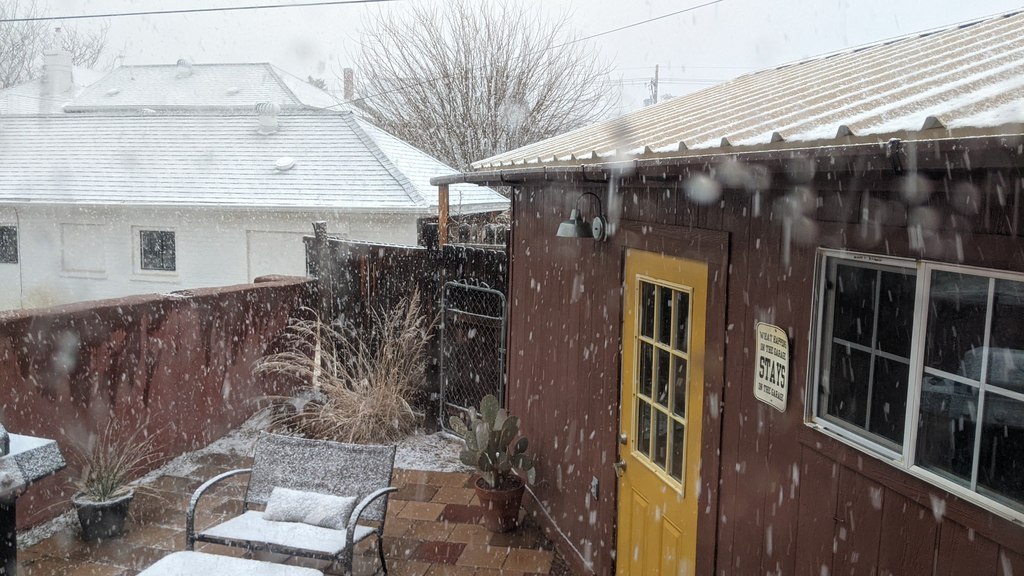
Linda got on a Zoom call with Chicago daughter Julia. After skies cleared, Patty and I slid to The Toad for green chile cheeseburgers and brews and conversations about her childhood migration from Michigan to New Mex when her father accepted a professorship at the school of mines in Socorro. Why, we wondered, wasn’t that university located in Silver City among all these holes in the ground?
Besides being an excellent potter, Patty also knows how to improvise in the kitchen. She concocted a most excellent birthday cake from supplies extant in the B&B plus items we brought: butter, apples, raisins, nuts. Linda made a wish and blew out a single candle. Huzzah! Gifts followed: a hand-thrown pot and ceramic green leaf. We read tarot, focusing on challenges, directions, motivations.
Aside: Silco’s demographics include some 90% EuroAmericans—kind of unusual for that state. The town is also losing population, down from 10,700 in 1990 to 9,100 today. Patty remarked that the rest of New Mex’s indigenous residents make that state way-cooler than Texas, which is easy, since almost the entire native community was expelled from the Lone Star State in the late 1800s. It occurred to me that Texas could well benefit spiritually by welcoming them back—and giving them land.
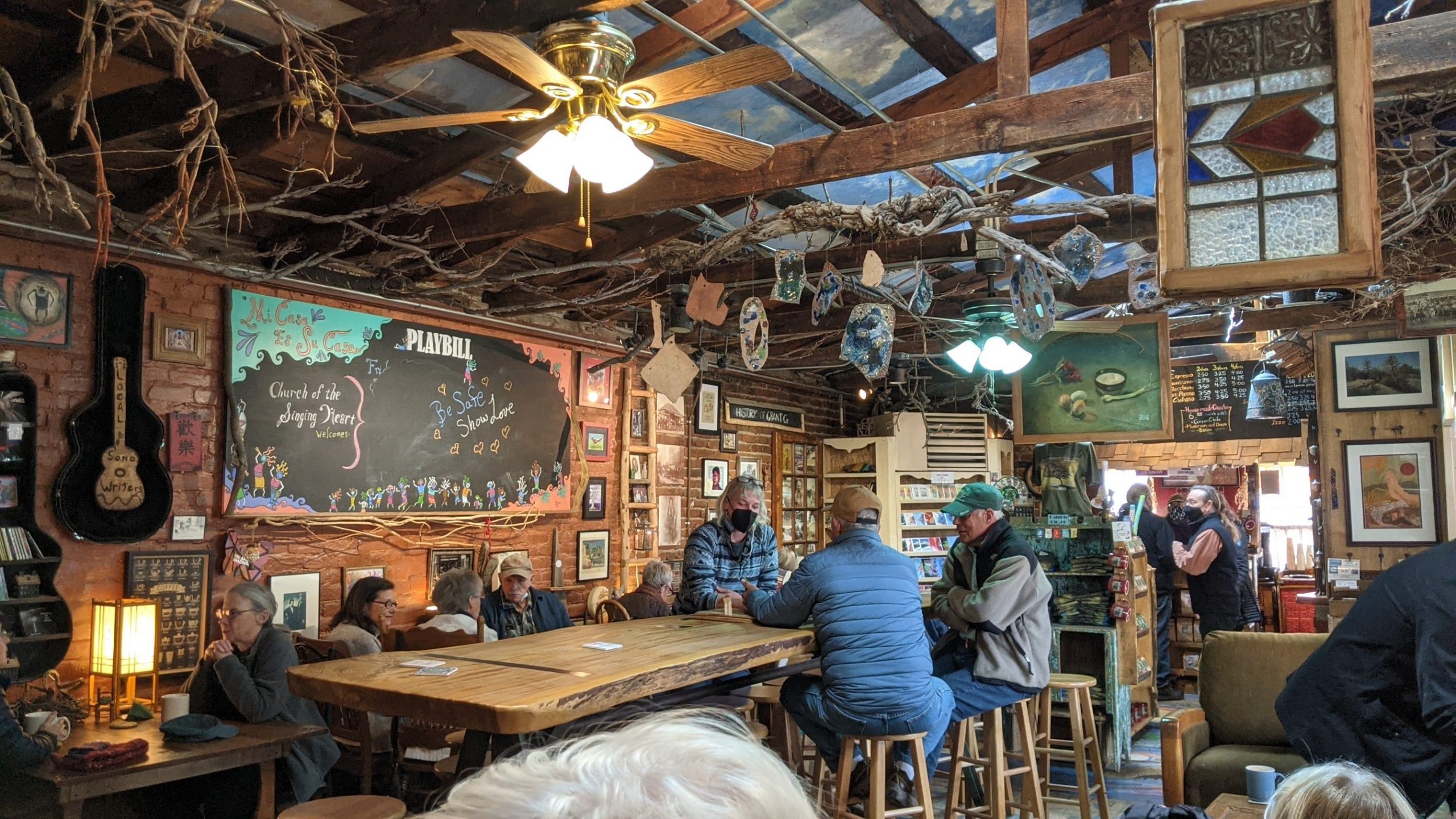
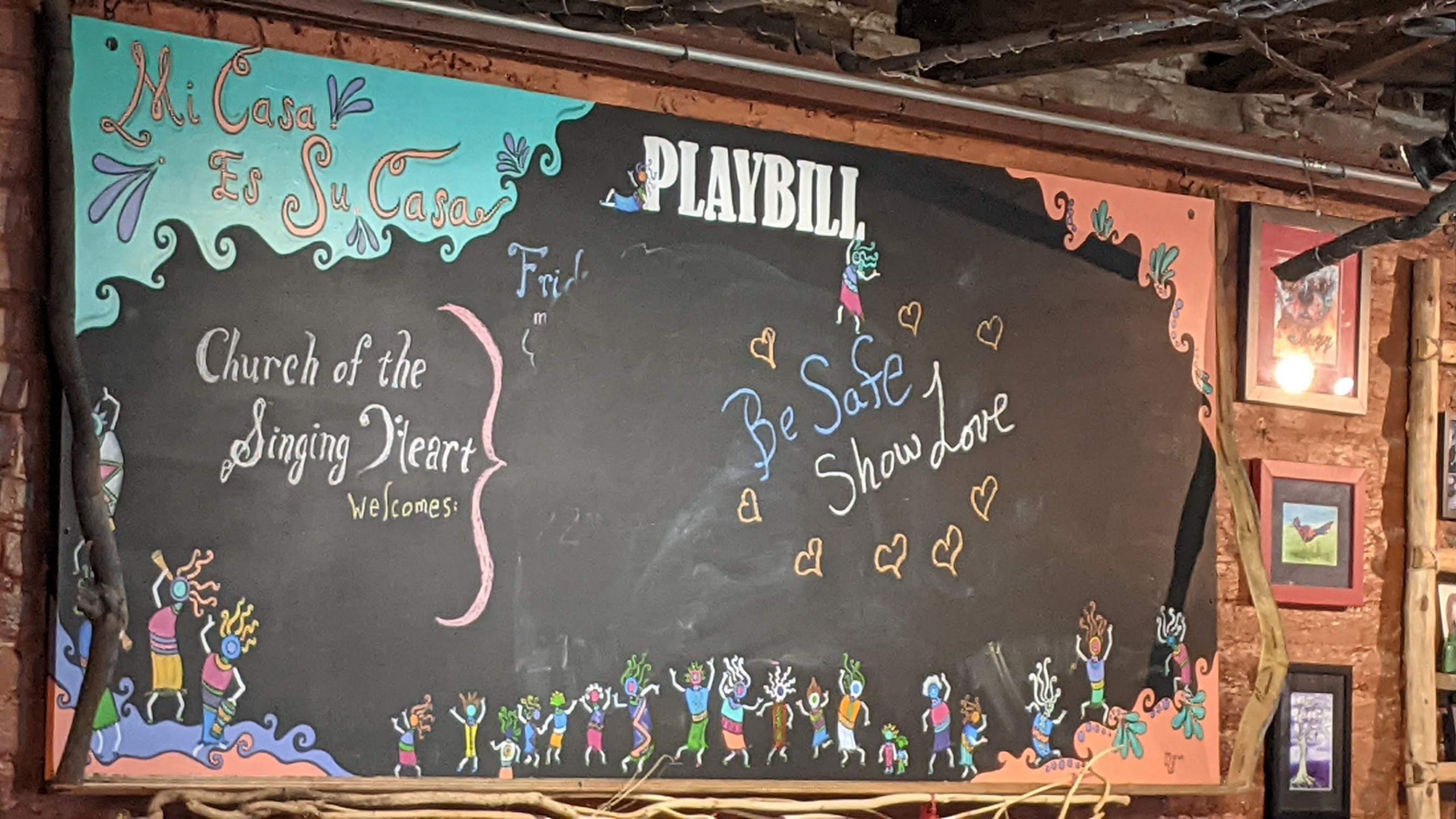

Ramble Round
Thurs the 17th was our day to explore the city in depth. Took Patty to The Buzz for java, muffins, and a green chile scone. We sat on the performance stage at one end of the interior space, surrounded by guitars, drums, and violins. It’s a thoroughly hippie-hip place.
On to the City Museum. Located in the former home of a prominent 19th century citizen, three floors exhibit photographs, artifacts, and documents regarding the town’s beginnings, booms, and busts. We learned that Silver City still operates under its original 1878 charter from the days of territorial New Mexico, which achieved statehood in 1912. Up steep and narrow steps, a tower room offered high-level views of nearby buildings and lanes. I encouraged the gift shop clerk to stock A Sand County Almanac.
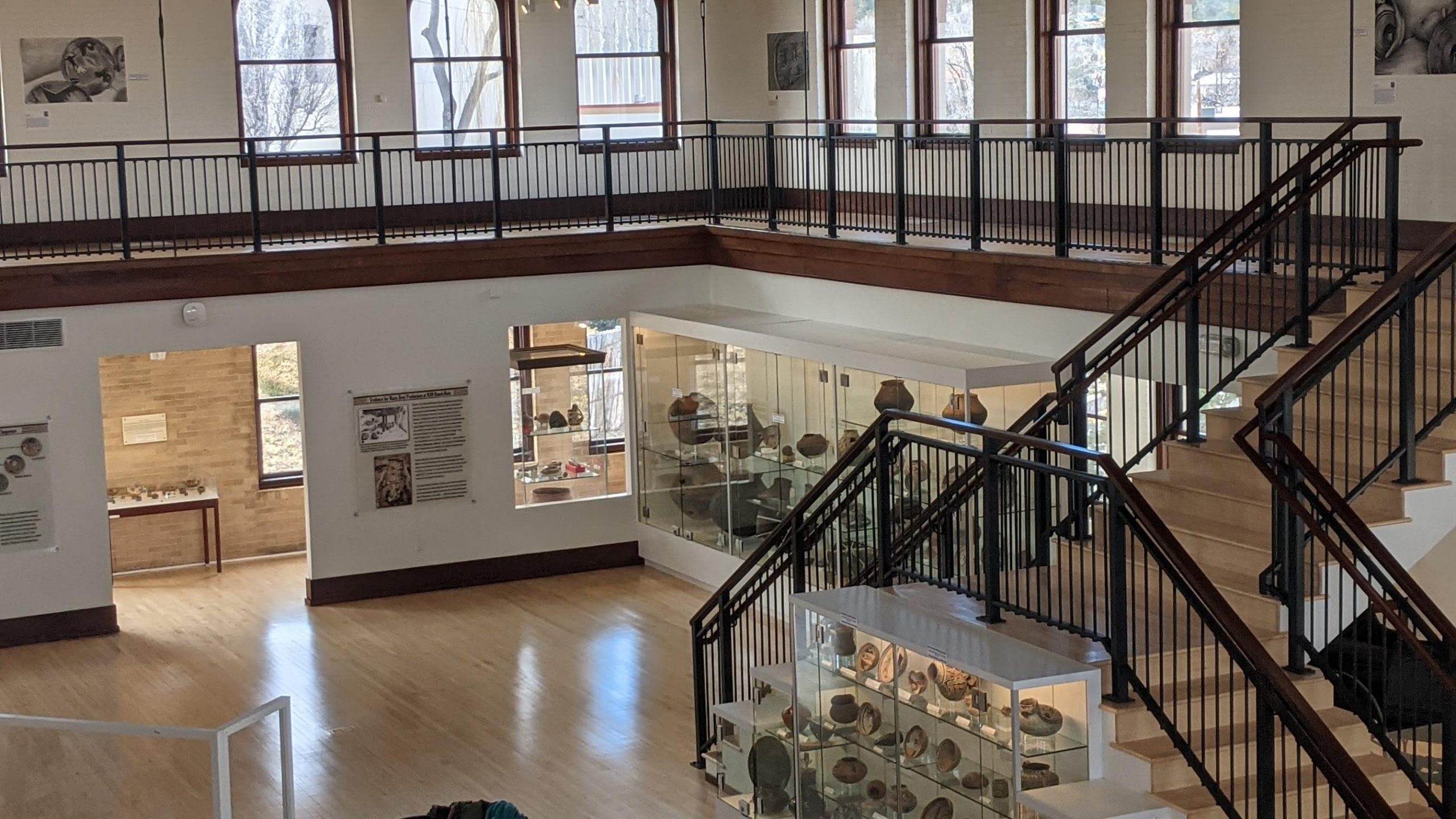


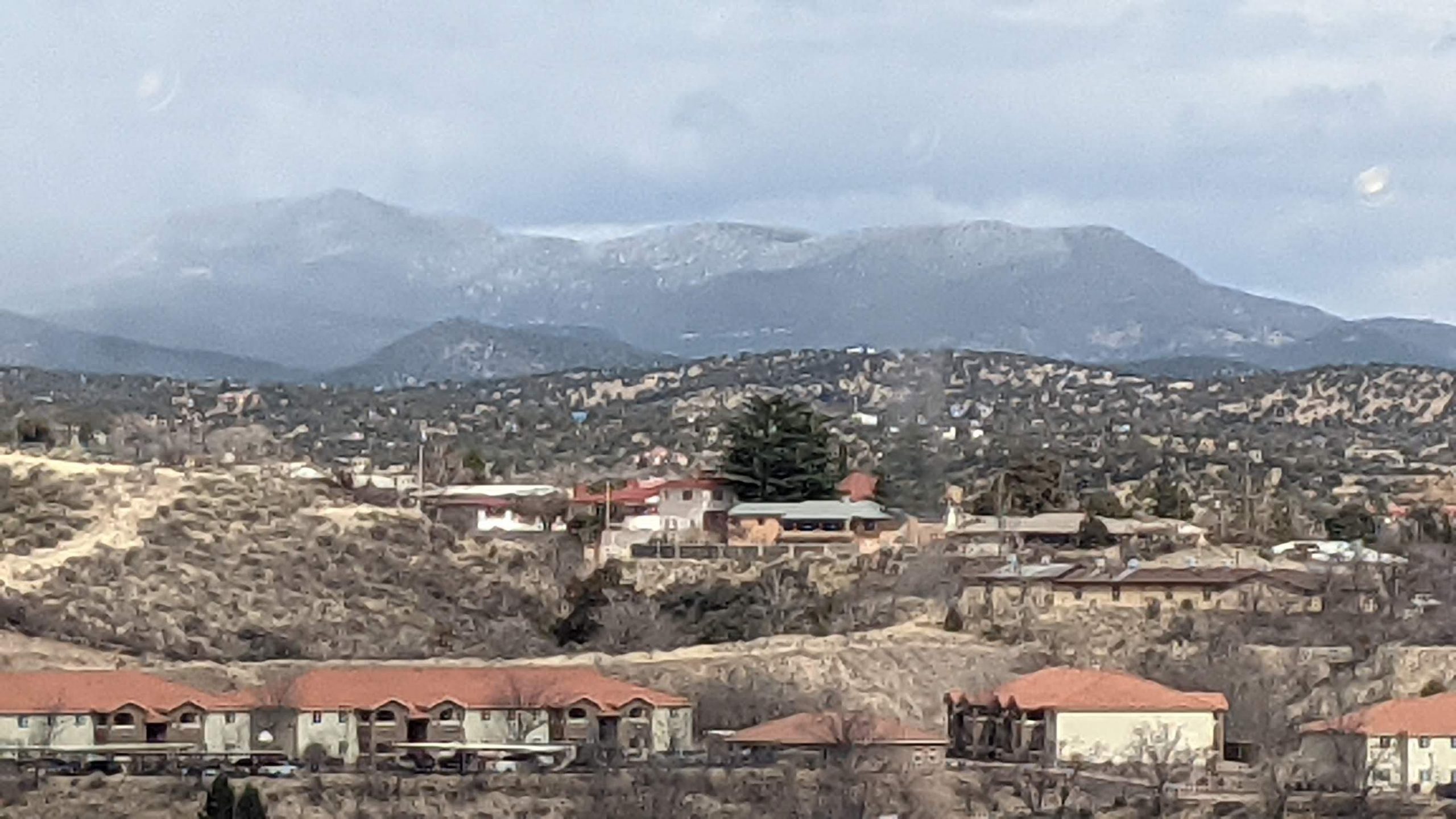
We continued walking and arrived at the Western New Mexico University campus. El Paso’s architectural firm of Trost and Trost, which designed our beloved Hotel El Capitan, also planned several structures here. One, Fleming Hall, the former gymnasium, is now a museum housing an extensive collection of prehistoric Mimbres pottery. The beer panel especially caused pause and made me thirsty. Many bowls have holes in their centers. Found in burial sites, a punctured bowl covered the the head or face of the deceased. The hole allowed the spirit to depart.
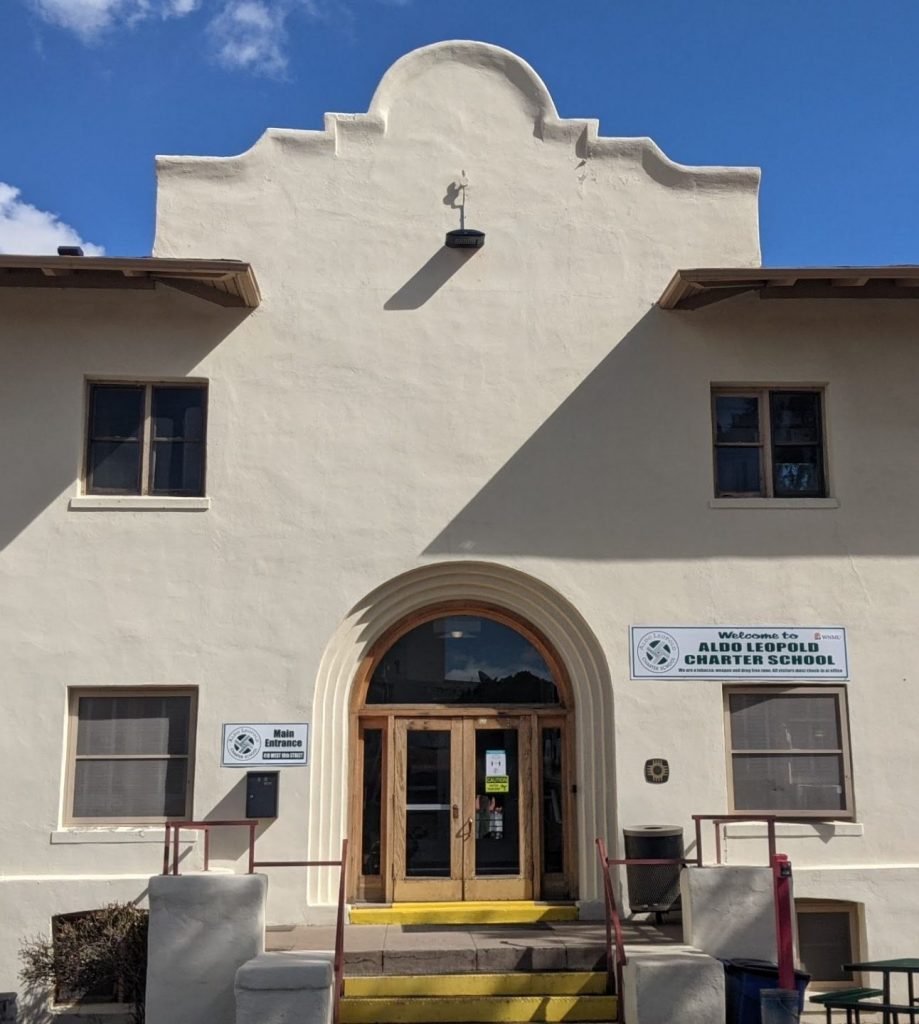
On the east edge of campus stands ALCC. Covering middle through high school grades, the institution strives to think outside the desk. Experiential learning for the whole child includes hiking, backpacking, and camping along with rigorous academics in a supportive community.
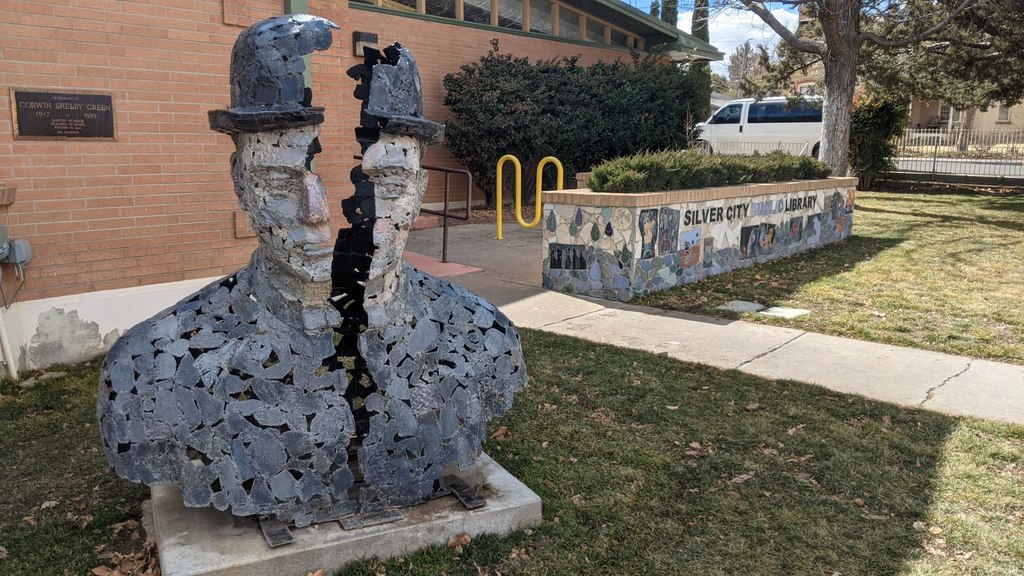
Strolled past the town library to yet another thrift store, Single Socks, where I procured an all-silk Hawaiian shirt from clerk Jeff, who discovered Silco on a cross-country bike trour and decided to stay. I asked him the city’s intent. Authenticity was his answer. Returned to Power and Light for more cards, gifts, and a book: Weed: The User’s Guide. Recreational cannabis is legal in New Mexico to possess, but none is for sale just yet. One can purchase art at downtown’s Grant County Art Guild Gallery, which offers classes and consignment sales, such as Wendi Oliveira’s photos, weavings, and leather-bound books.
Nancy’s opened at 3:30, and we were nearly first to be seated in this, Linda’s favorite café. Ever honoring the day’s color, I relished a green chile chicken burrito and green tea. While the gals finished up and wandered off, I crossed Bullard and met Nan Franzblau at station KURU, Gila Mimbres Community Radio. She showed me around the basic setup, reminiscent of Austin’s KOOP, and we shared stories of broadcasting. Her PhD husband teaches physics at ALCC, where their daughter also attends. Nan loves Silco’s intentionality and affinity.
Finished off the evening with leftover yummies, sips of Scotch, and a shower/shampoo in the spacious bathroom stall. Watched Fantastic Fungi, our second or third viewing to Patty’s first.
Bye to Bullard
Friday the 18th was our last morning in Silver City. Just when we were beginning to figure the place out, it was time to skedaddle and hit the highway. Patty also packed up and split. We spoke to our lodging hostess, Megan, as we loaded. Like so many others we’d met, she moved there by choice, then sought employment. A professional biologist, she works freelance on bird surveys and such. We made sure that Desert Cottage might be available to us again when we return in the summer.
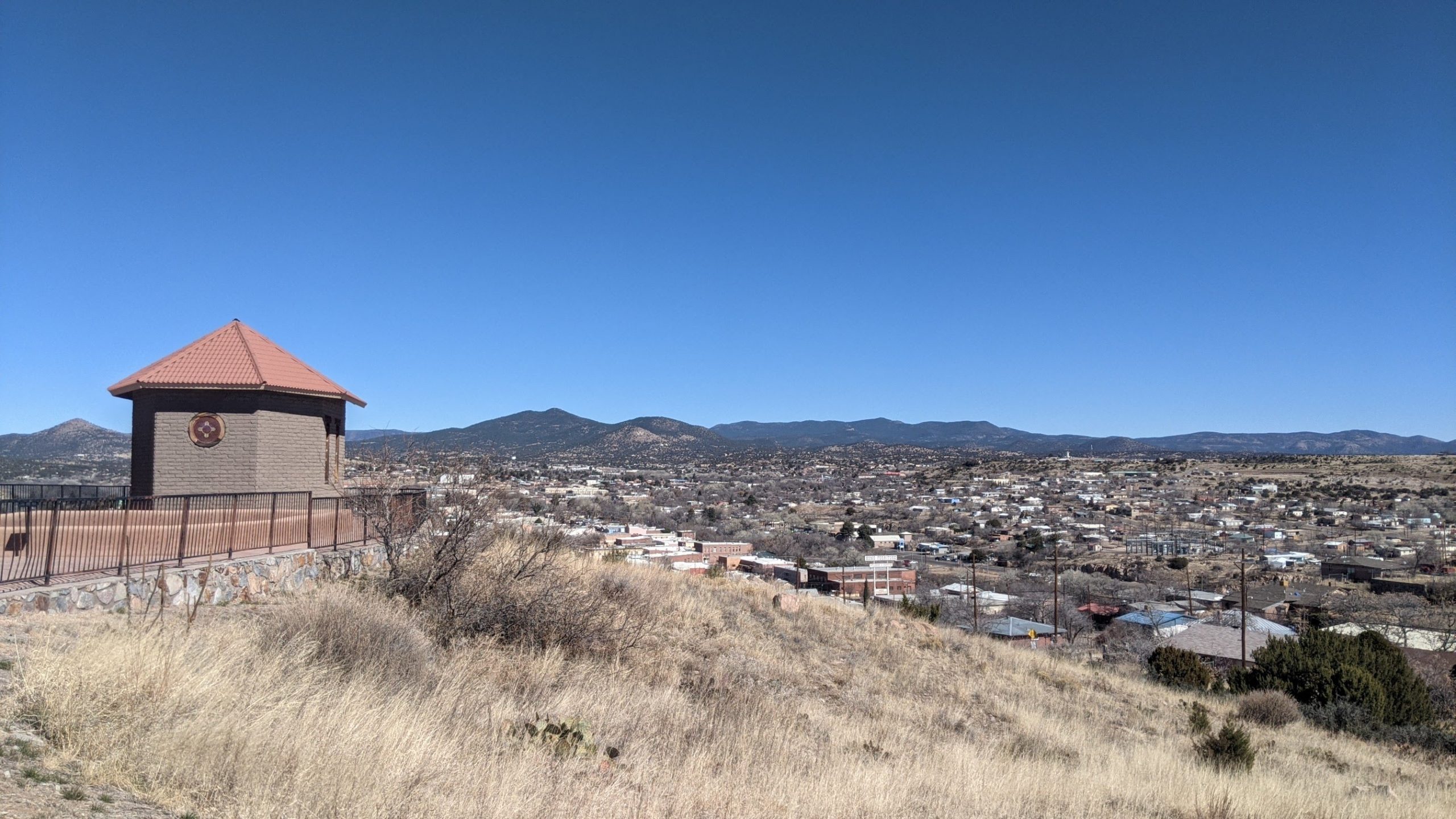
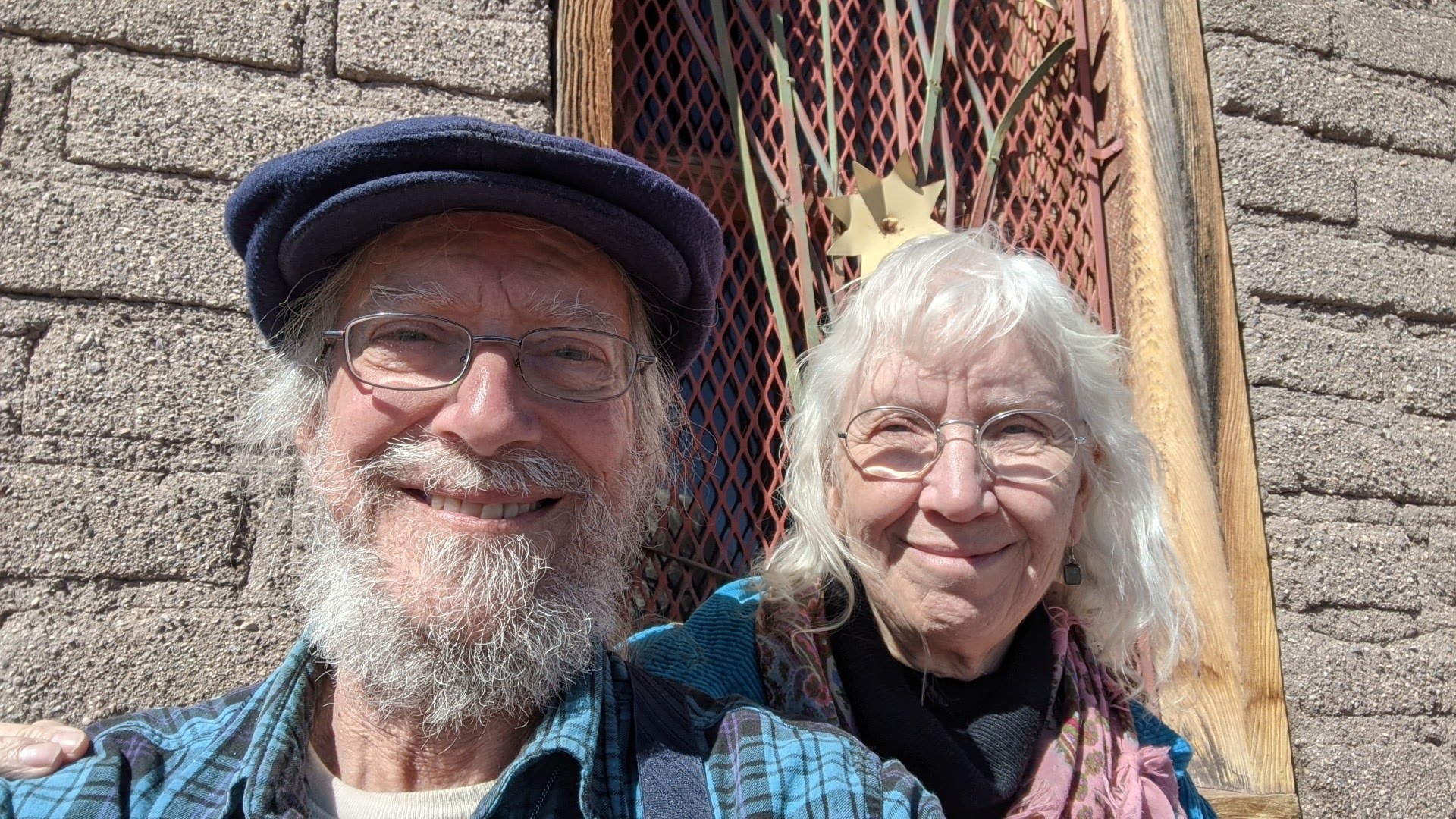
We took in one last panorama of the situation. La Capilla, a prominence south of downtown, features a replica hexagonal chapel in homage to an original from 1885. Local musicians jam up there at random times. Got a few snapshots downtown, as well, then filled the tank and stocked up on six packs of Little Toad ale for ourselves and our next hosts. Silco receded in the rear view mirror at almost exactly high noon with an even 34,000 miles on the odometer.
Valley of the Rio Grande
Tried to avoid the gaping maw of Santa Rita Copper Mine, but had to pass it again to head eastward. The road ahead, like the ones in the Gila Mountains, required slowness and caution while offering exquisite views of forest and crag. As we neared the summit, however, charcoal stumps and ashen ground revealed a sobering reality.

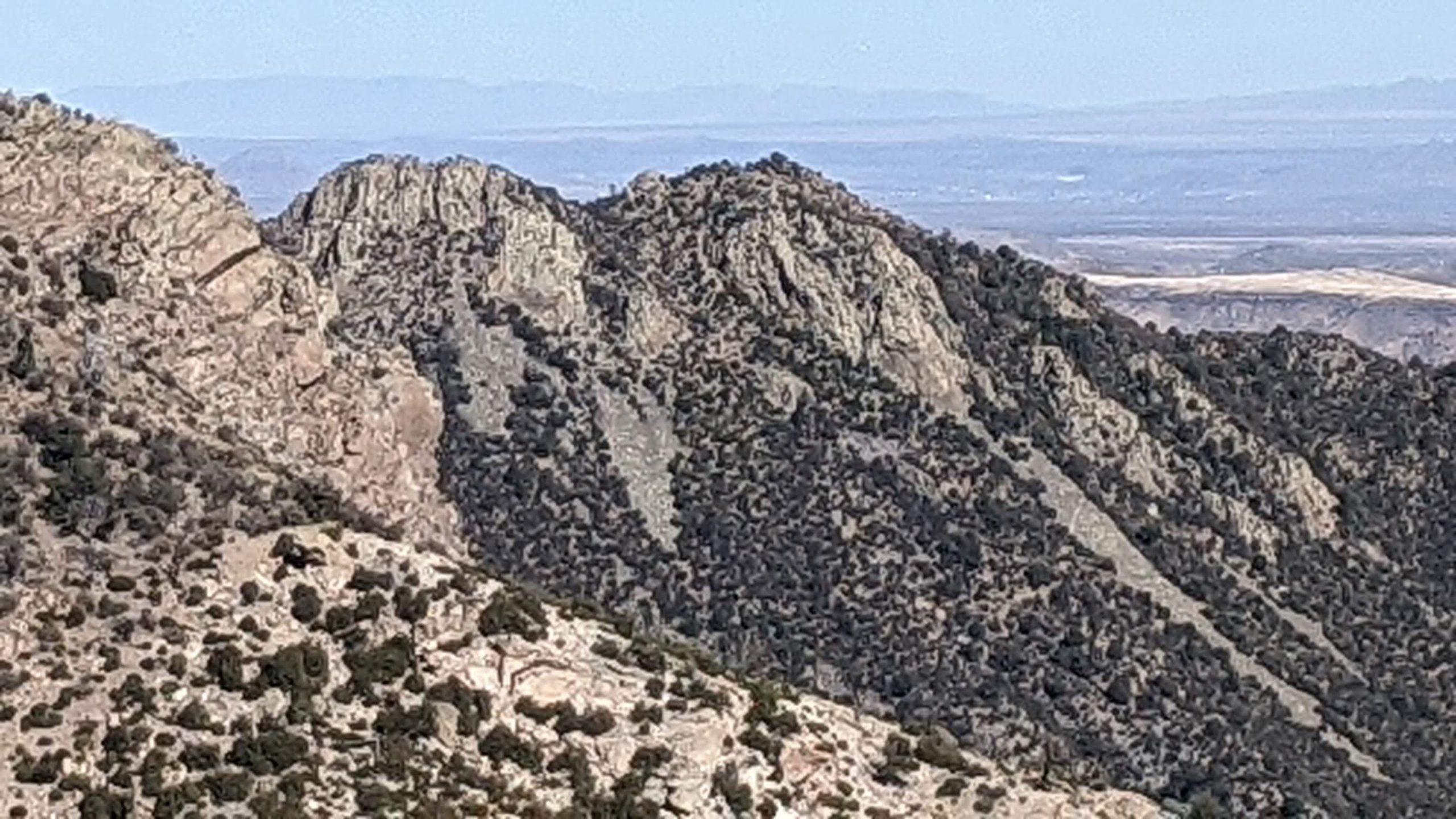
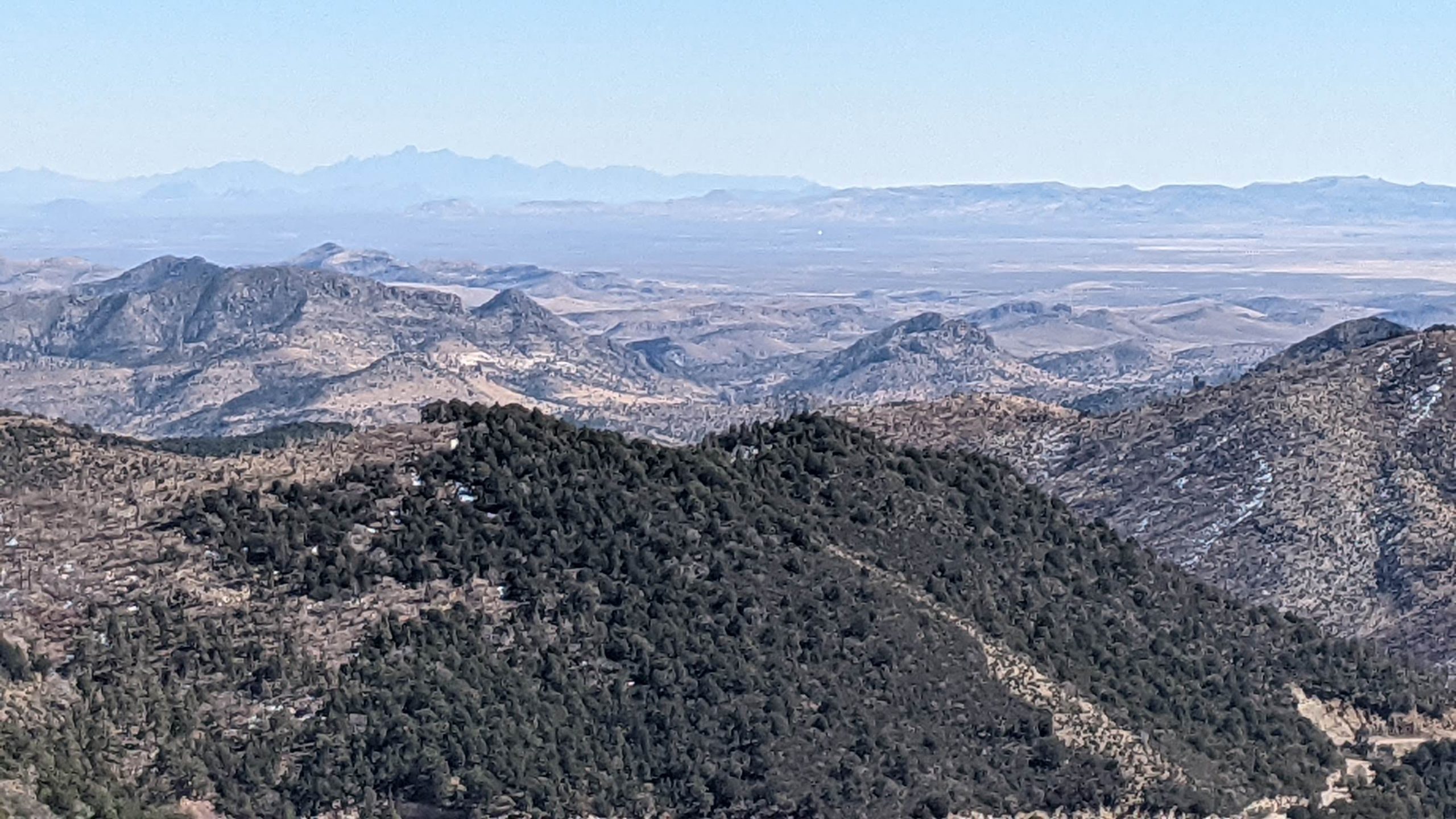
At 8,228Ꞌ, the pinnacle is called Emory Pass for U S Army Corps of Topographical Engineers Lieutenant William H. Emory, who traipsed the area in 1846. That’s the same fellow for whom Emory Peak in Big Bend is named. A forest fire in the summer of 2013 scorched more than 139,000 acres in this part of the Black Range. We stopped for lunch here and read signs about landmarks to the east, the Aldo Leopold Wilderness, and the Warm Springs Apaches who called it home. As we munched, two pairs of hikers took off in opposite directions on the Black Range Crest Trail. This would be the highest elevation we’d achieve on the trip.
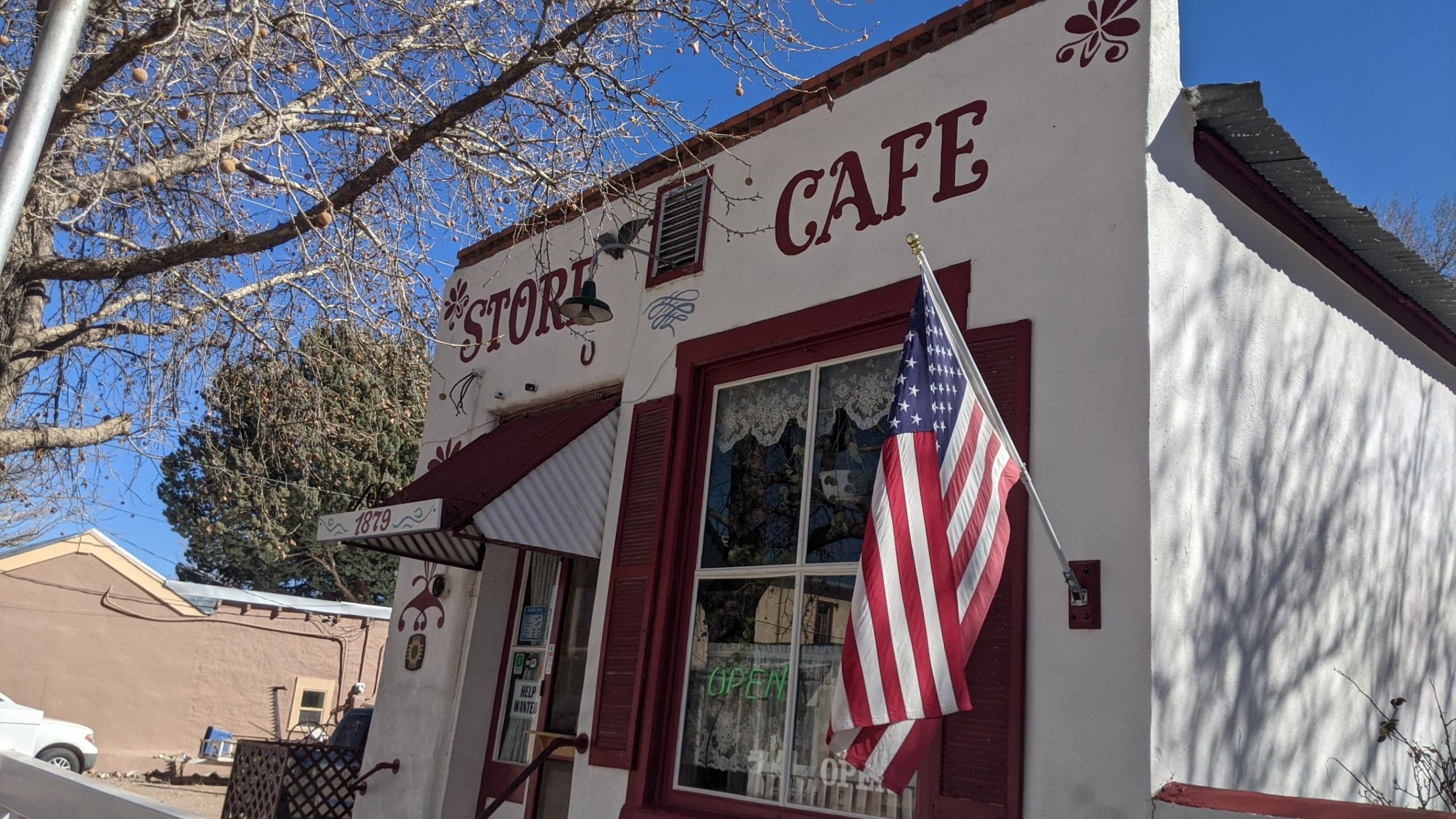
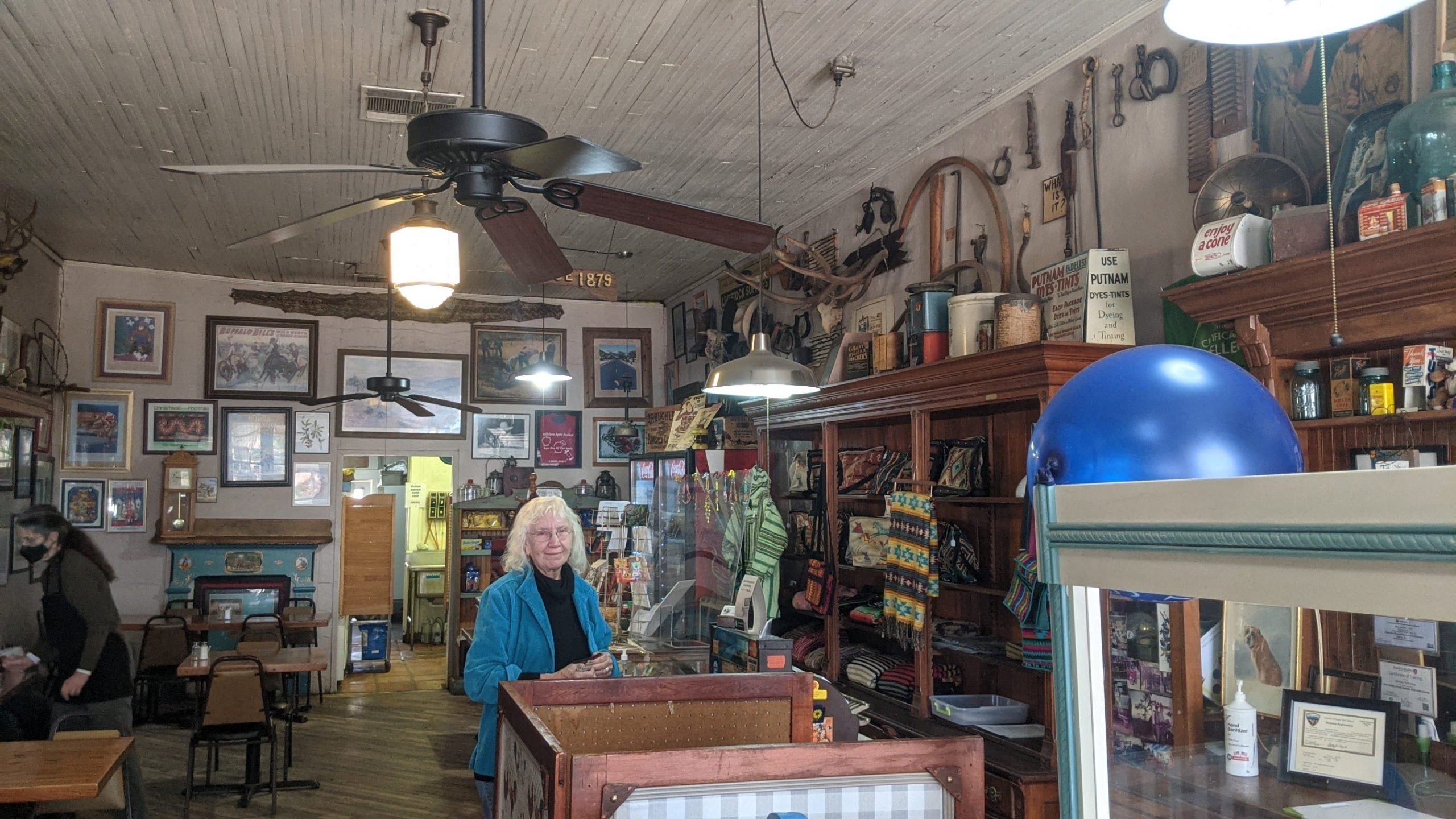
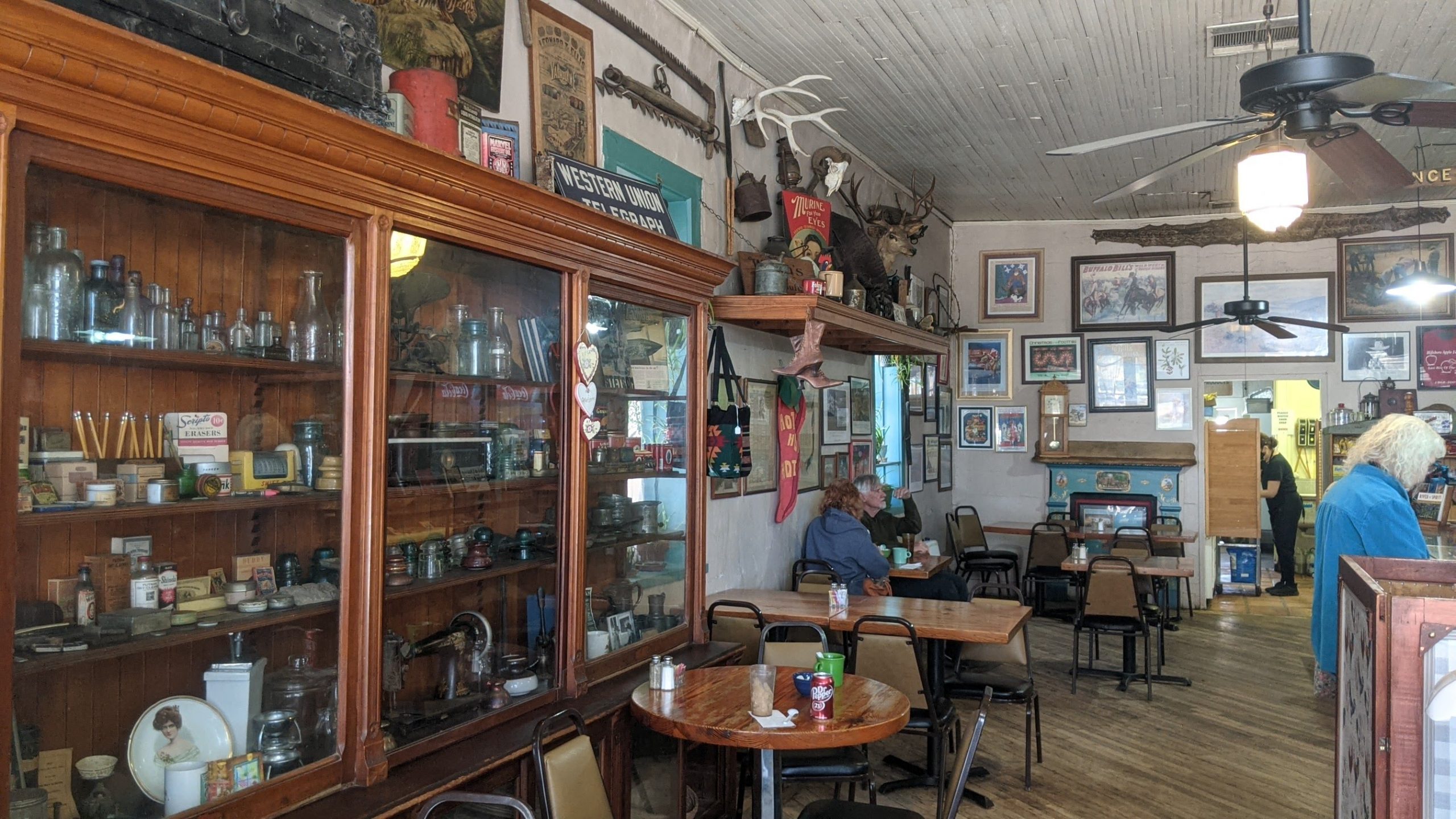
Descended through Kingston to Hillsboro, where we stopped for refreshments. The 1878 store and café inspired the notion to pour half-and-half into my Dr Pepper for a novel taste treat. We left the tall ponderosas behind and found a familiar Chihuahuan desert landscape ahead. Cruised along the Rio Grande, hoping in vain to see verdant agriculture.
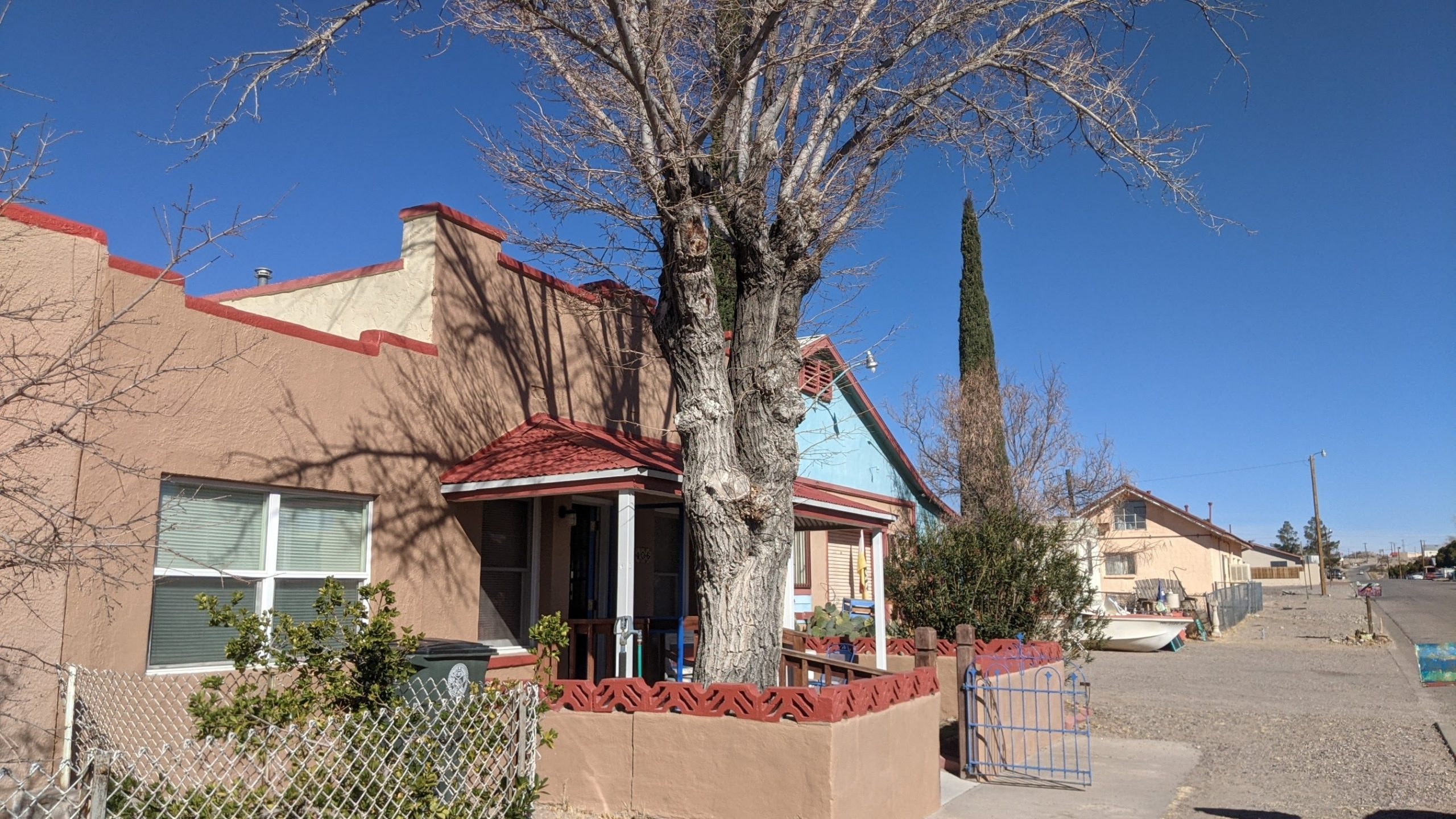
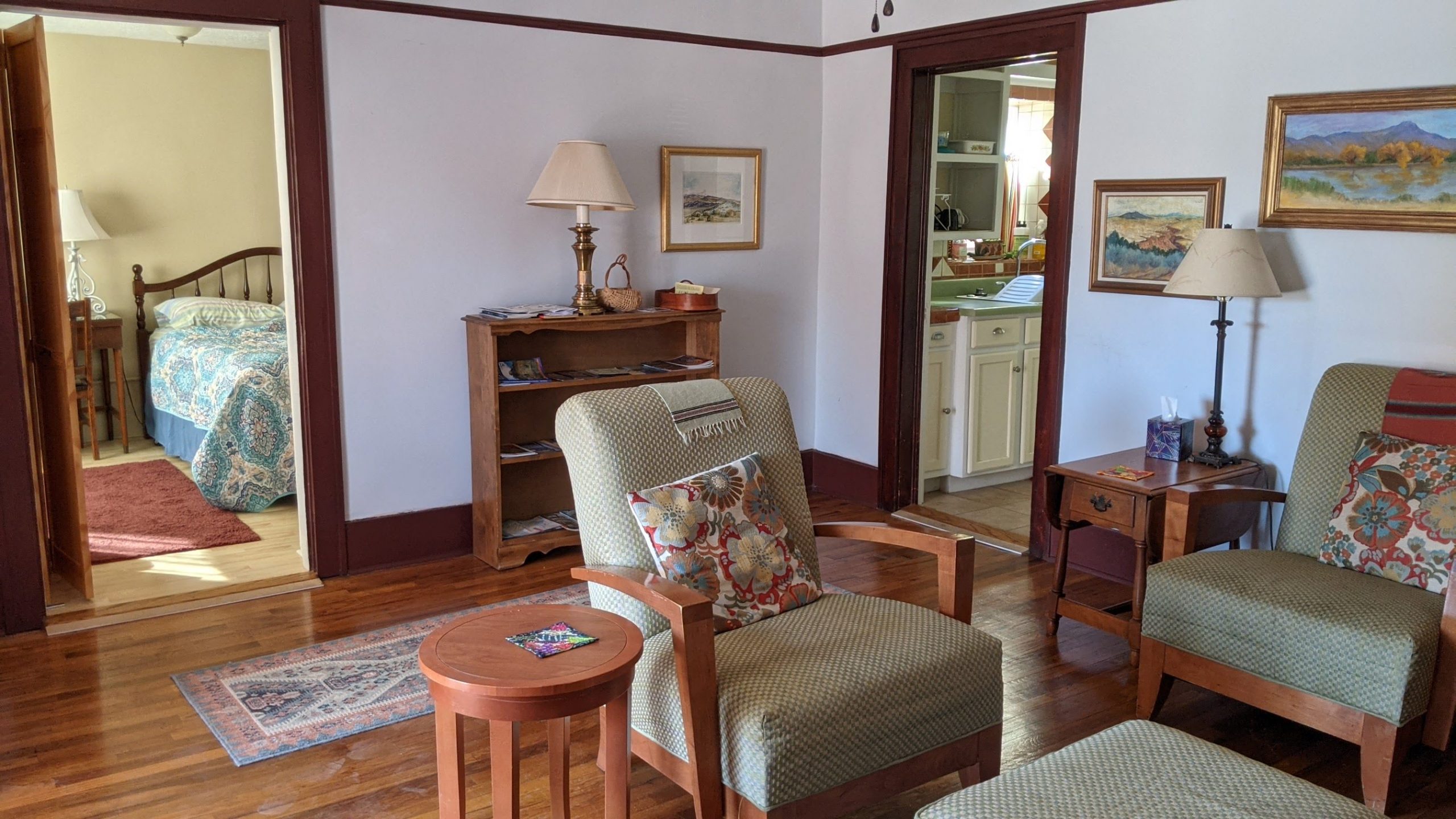
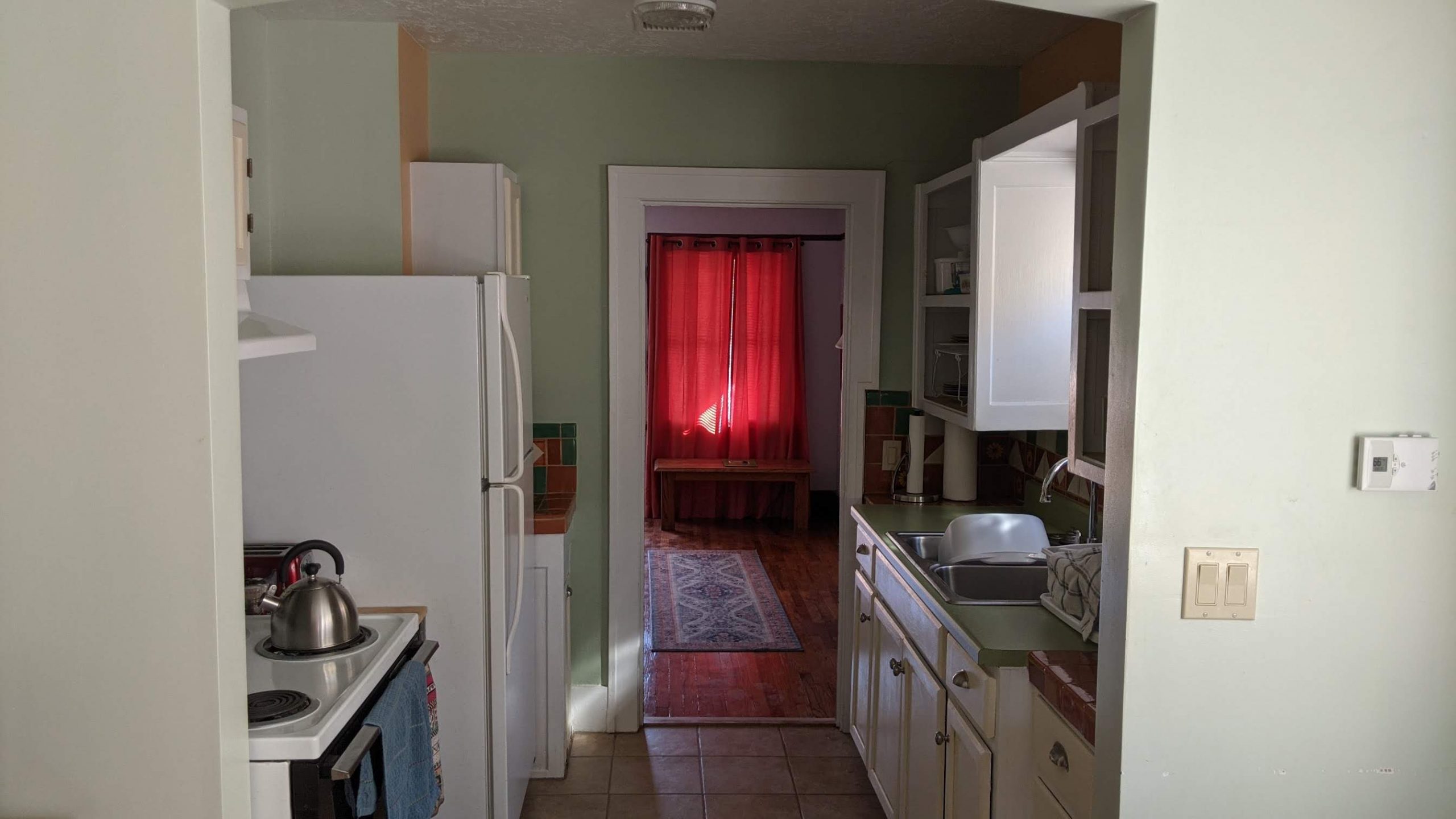
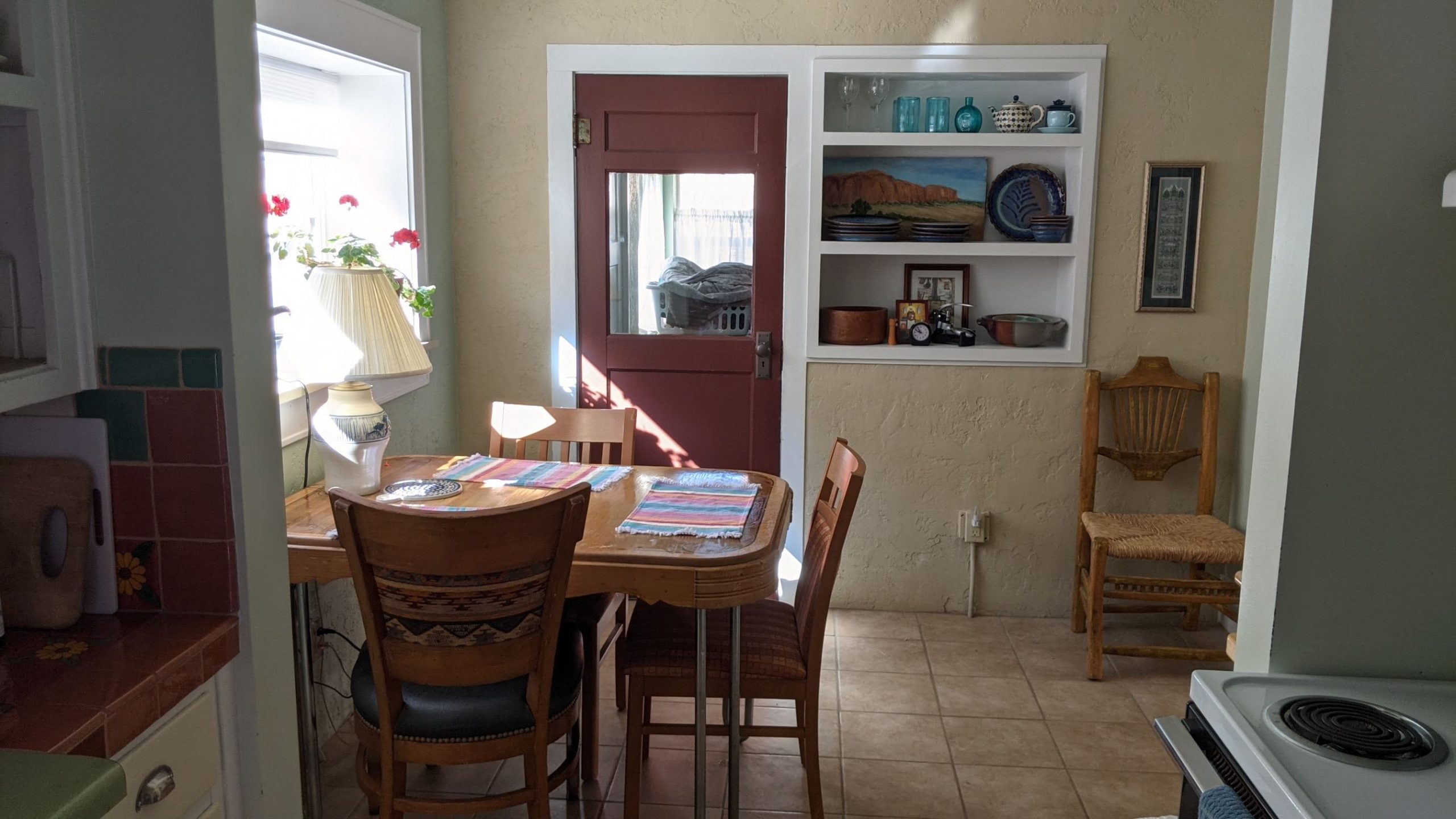
Entered Truth or Consequences (T or C, take your pick) from back roads and made our way past its mellowing business district store fronts to Cedar Street Casita B&B, where we’d spend two nights. Linda’s book-artist friend Priscilla rents the dwelling, which sits next to her studio and home on one side and her former husband’s antique shop, Don’s Den, on the other. We settled into the front bedroom and spread our electronics out on the dining table. Arriving almost simultaneously was another friend, Lysa from Santa Fe, with whom we’d stayed in July. The gals caught up on their various projects and commonalities.
Long about dark, Priscilla drove our beer offering while we hiked a few blocks to the spacious hand-made home of Ken, Priscilla’s main squeeze. He reconfigured an old four-plex into a 2,500-square-foot palace on a hill overlooking downtown. He’d raised nine kids there but was the sole occupant at present. Gardens, orchards, and garages surround. He and Priscilla conjured up a fitting feast of guacamole, chips, and rolled enchiladas. Beer and wine and merry banter flowed.
After sup, we vied Play Nine, a card game based on golf. Such an activity is unusual for L and myself: neither of us is ambitious or competitive. Instead of making a scene or pouting, I just went with the flow, striving to not be embarrassed and making jokes the whole way. It was fun. We walked back in the deepening night under a sparkling galaxy and bright moon, feeling safe.
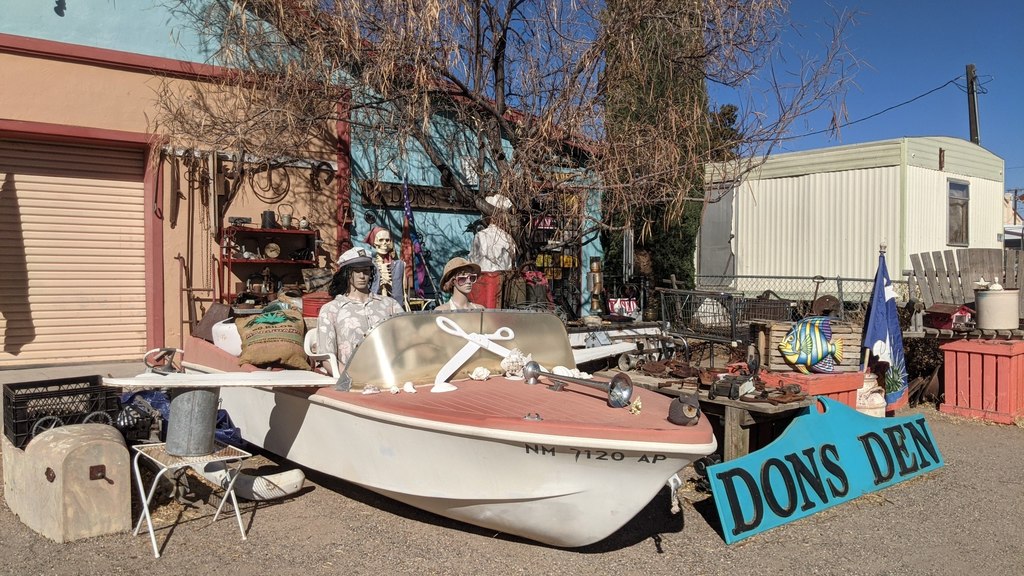
Funky Town
Saturday the 19th began with clear skies and 30°. How brightly shone the morning star! After breakfast and coffee, I sauntered next door to meet Don Hallock, another transplanted Austinite and brother to my neighbor Gary. The fellows resemble each other in the height department, but Don sports long hair and a beard. Outside sat Don’s wizened friend Roy, who rolled his own smokes and expressed sharp opinions about everything. I asked him what he liked about T or C. It’s easy to live here. The antique shop displays a dizzying collection of oddments, junk, and Don’s found-art assemblages. From him I bought a New Mexico license plate because I love the colors. The building holds lots of storage and includes Don’s apartment in the rear. There he parks his art-van every night, then moves it to the front when the place opens. He drives to work!
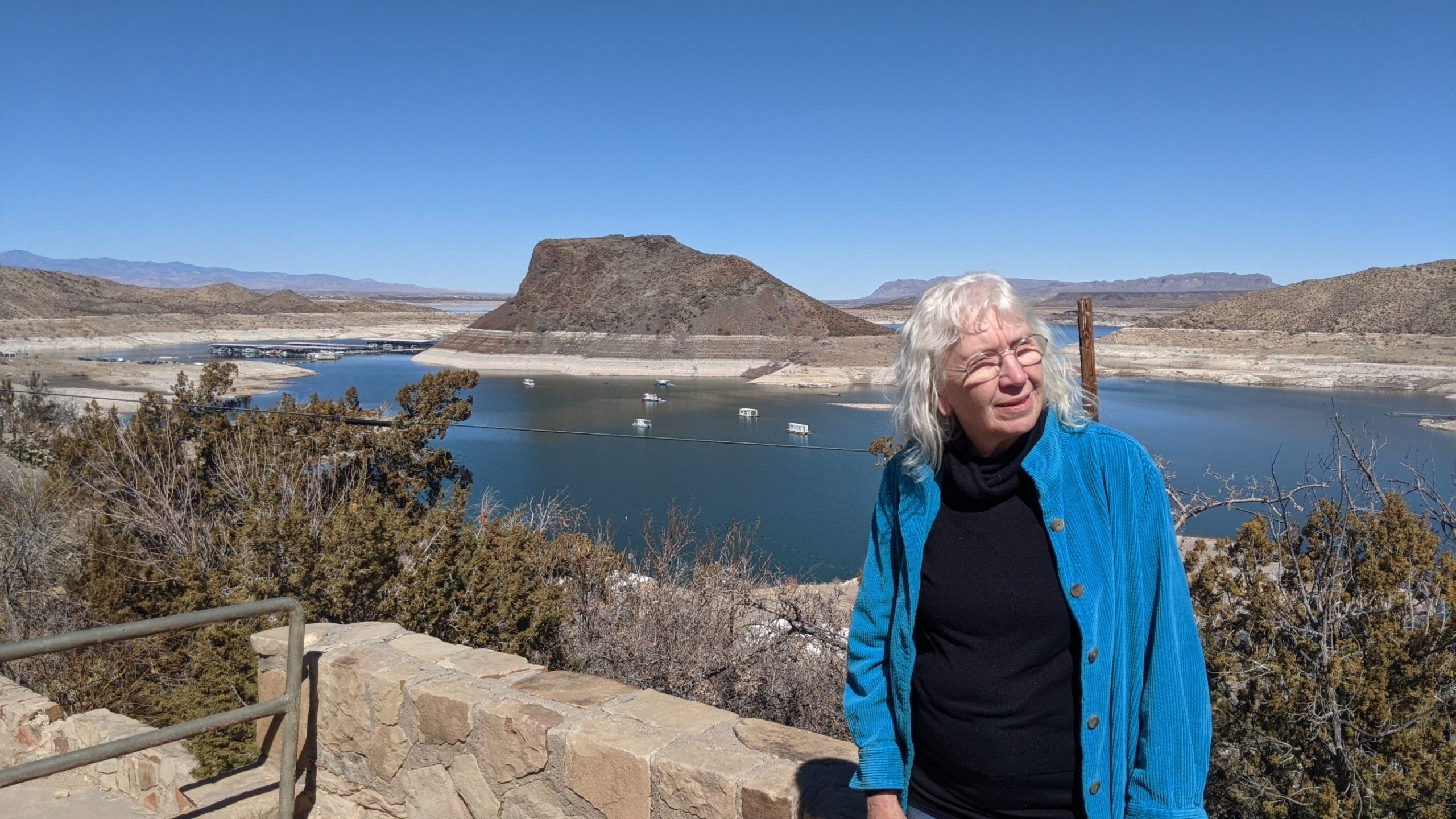
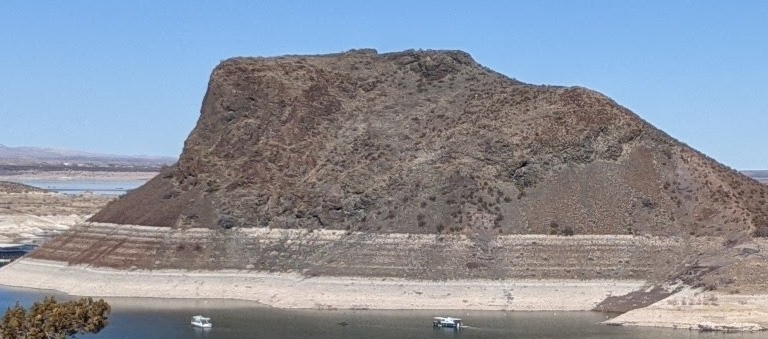
At mid-day, five of us piled into Lysa’s Subaru and rolled out to Elephant Butte Dam View Park for a picnic lunch. The great river looks poorly these days, no thanks to an ongoing drought. On offer were cold cuts, chips, tomatoes, Prosecco, IPA, tales, and funnies.

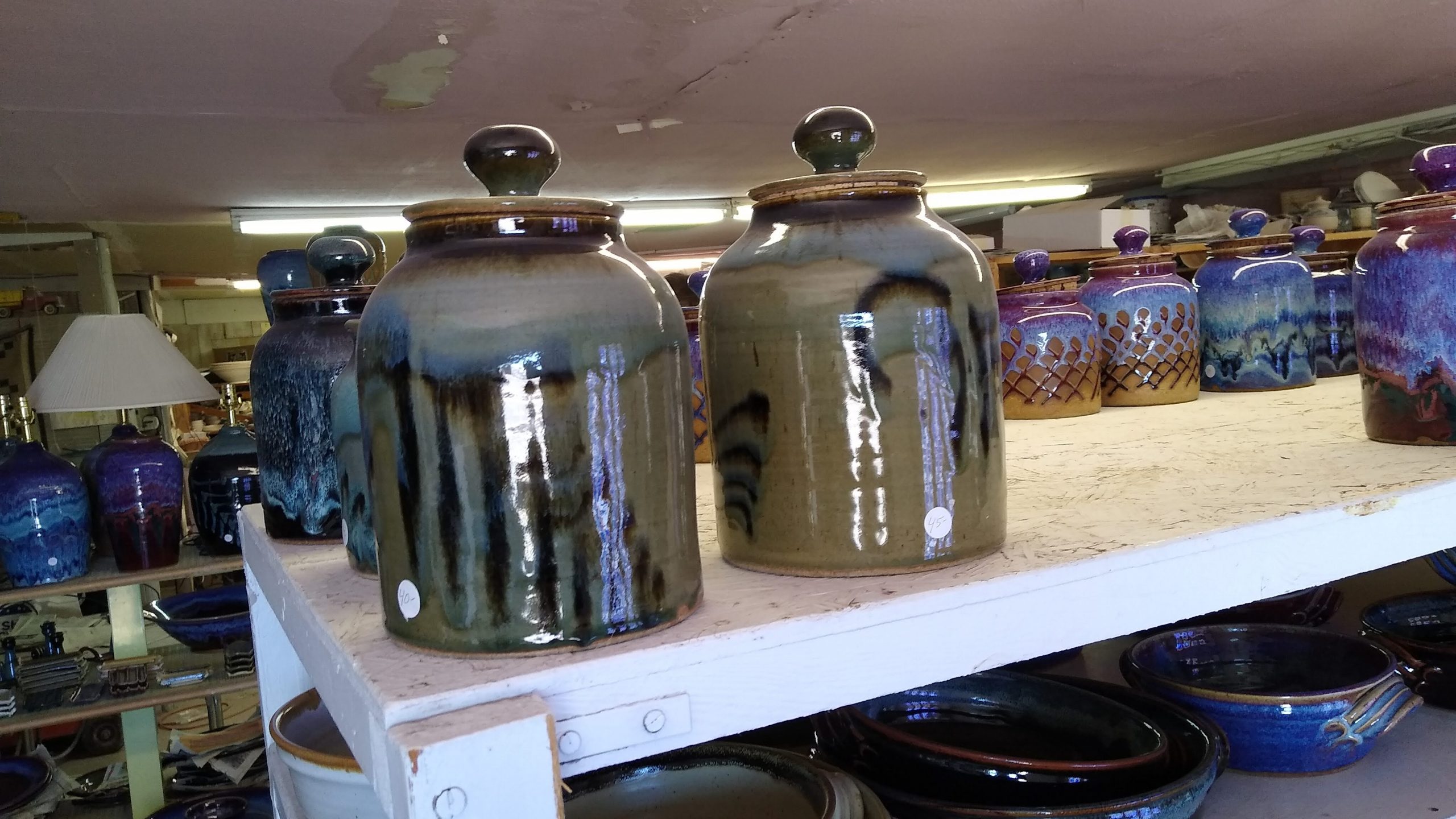
Again at the casita, we crossed the alley to Ken’s studio/gallery, where he makes all manner of glazed ceramics. It’s a remarkable production, but he’s having trouble finding good clay these days. He might need to retire. Linda procured a fine little lustrous decanter.
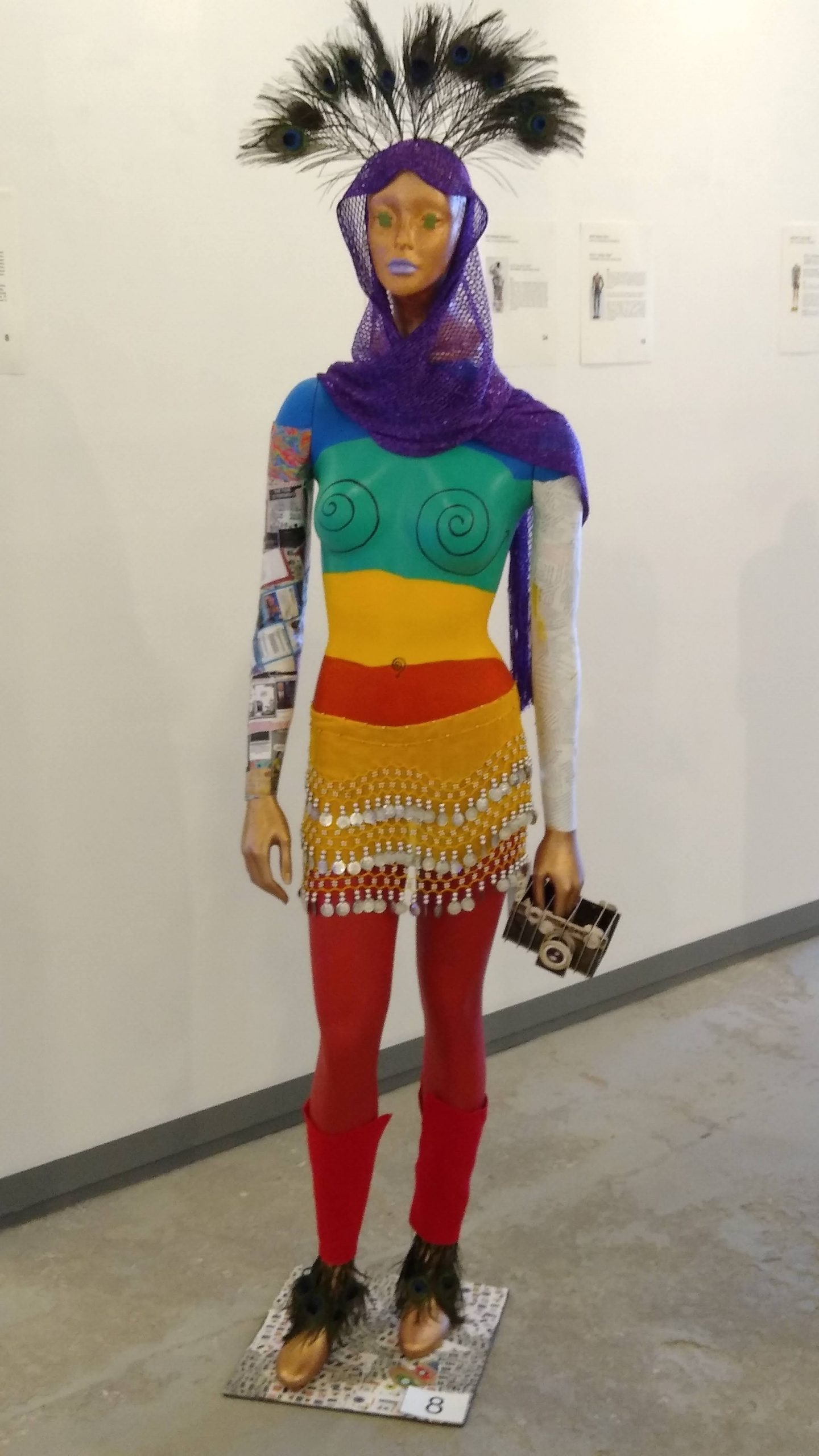
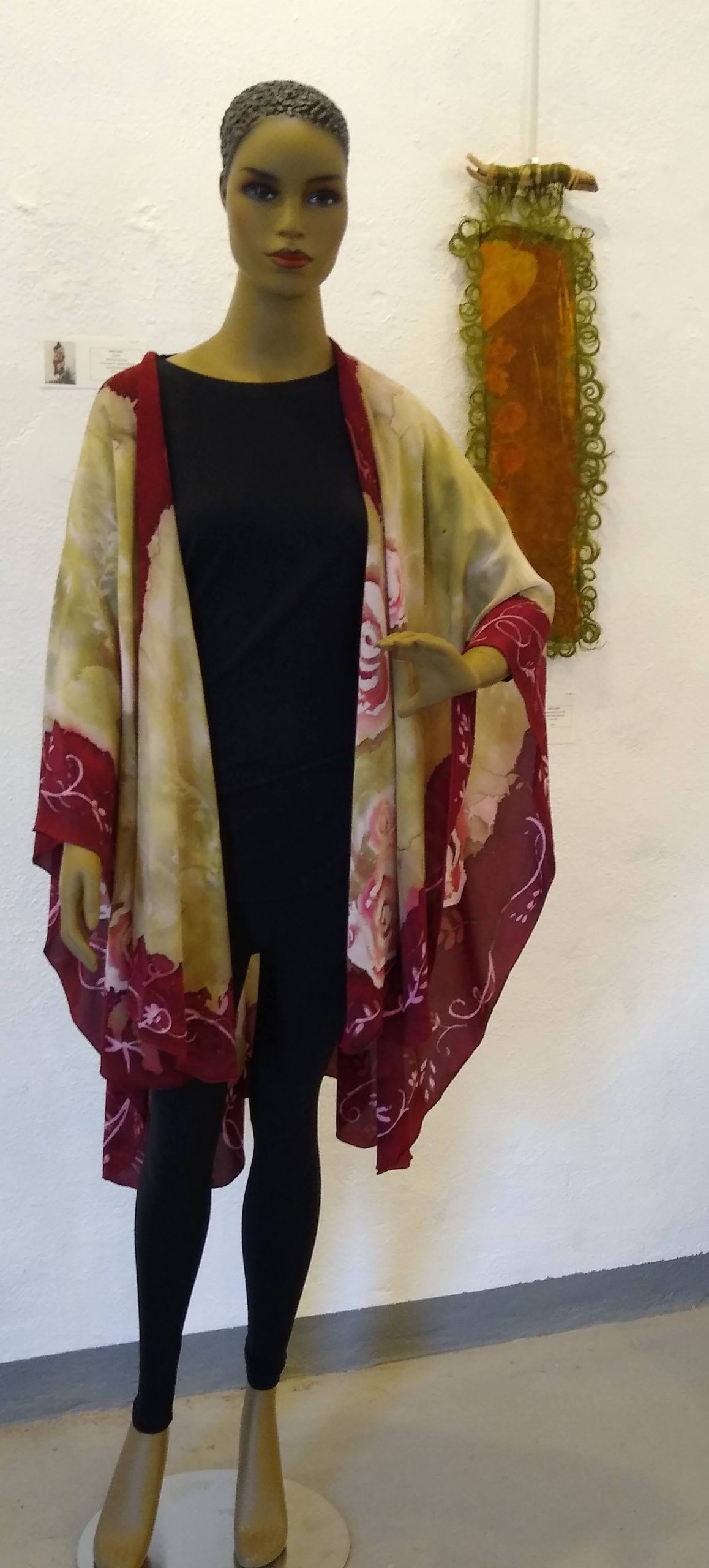
Les femmes went gallery-hopping in the city’s center, discovering a series of decorated mannequins not unlike Austin’s gaily painted street steers or San Marcos’s dolled-up mermaids.

In the quiet, I got a little shuteye, then visited Don again, who recommended the best local pub, T or C Brewing Co. There I partook a pleasant pint of Palomas Porter. Met a bevy of characters there, including Nick and Lindsay, operators of Outlaw Casita and originators of Sideshow Opera, which combines classical music with foot-thrown daggers and burlesque. They were excited to revive the annual T or C Fiesta (parade, rodeo, carnival), which the Big Germ had nixed for the past two years.

Discovered a shorter walk back to the dwelling compound to meet up with the others and again stuff the Subaru for a tour past the famed bathhouses by the river. Generations of natives and travelers have enjoyed the curative, invigorating thermal waters. Originally known as Hot Springs, the town changed its moniker in 1950 after winning a contest put on by a popular game show of the same name.
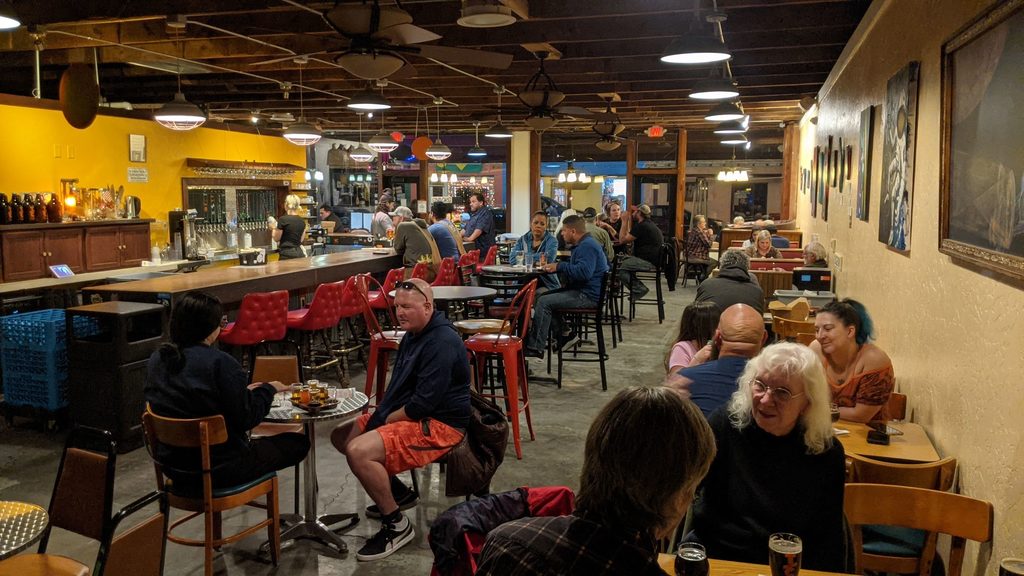
Parked behind the brewery and strolled past the outdoor fire pits and interior beer vats to take a seat near the empty stage (no music that night). Ordered pizzas, picked them up, and brought them back. This time, Ken supplied a British game, Shut the Box, which required tossing dice and flipping numbered tiles. We felt merry-old English.

Sunday the 20th meant that we’d all be leaving. Lysa returned to Santa Fe. I got loaded (the vehicle) while Linda and Priscilla went over finer points of bookbinding and paper craft. With fond farewells, we set our sites south on I-25, following the Rio Grande through Hatch and Las Cruces almost to El Paso. Instead of enduring that metropolis’s congestion again, we bypassed it via the Transmountain Loop across the Franklins.
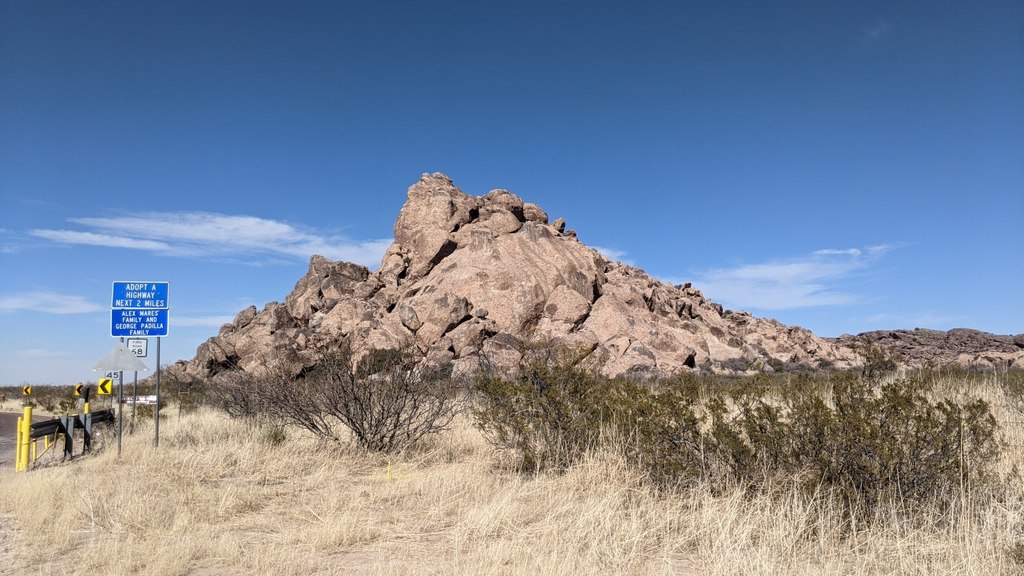
On the opposite side of the city, we headed east on US 62/180. Goal was Hueco Tanks State Park, but we hadn’t counted on needing a reservation for a day-hike. On a weekend, the place was full with a two-hour wait. We pressed on.
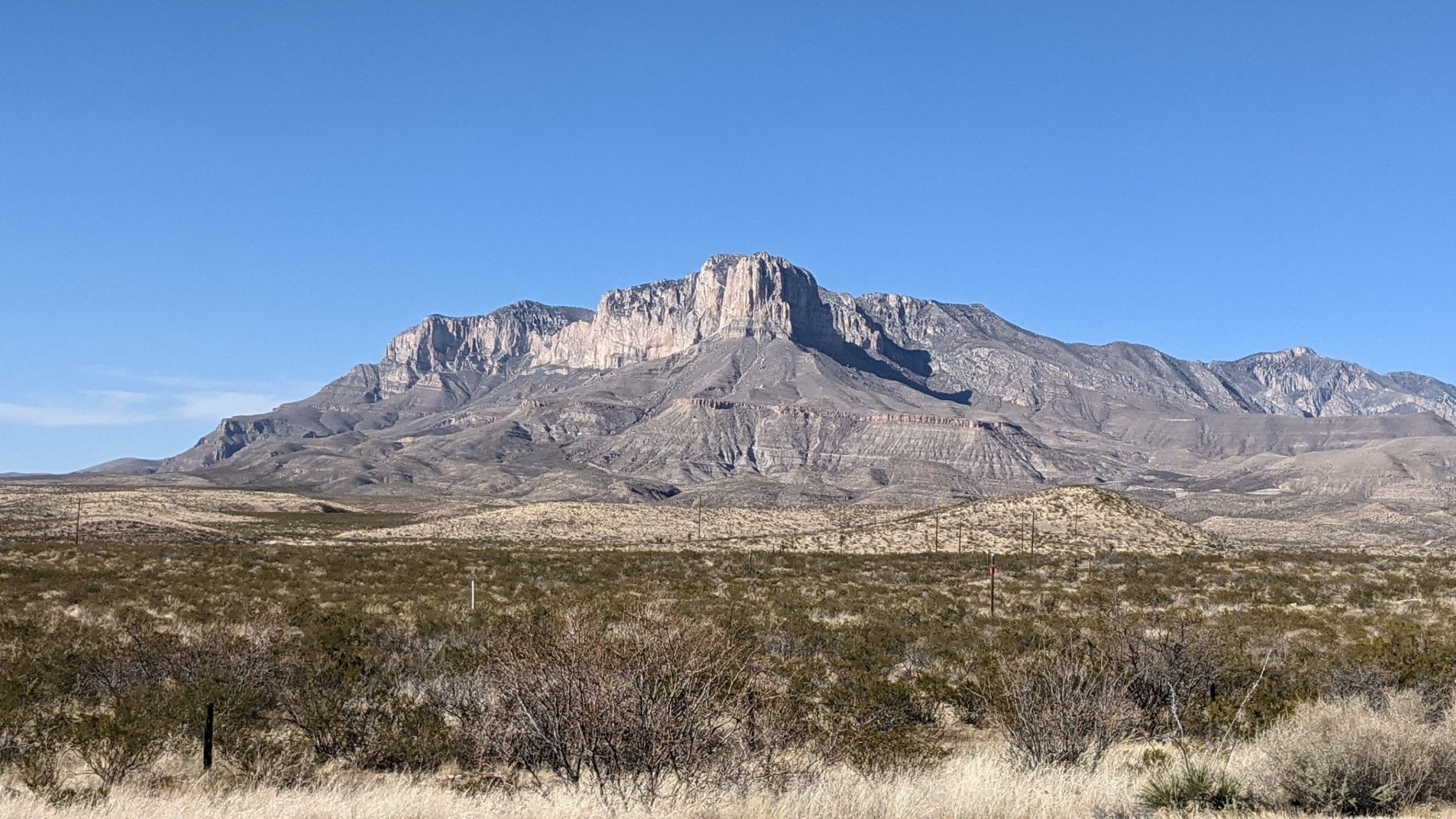
A catch basin on the western edge of the Guadalupe Mountains has collected mineral salt from time immemorial. Before Texas claimed the area, all manner of folks traveled to these salt flats to gather the important commodity. When one particular individual claimed ownership, opposition became an armed struggle known as the Salt War. We’d heard about this incident in San Elizario and found historical markers about it here as well. Texas’s highest point, Guadalupe Peak, stands 8,749Ꞌ above sea level, just behind the proud El Capitan. There we turned south, enjoying the vast shadows and bluffs of the Sierra Diablo, home to the now-rare desert bighorn sheep. By 5:30, we were again checking into our favorite Van Horn hotel.

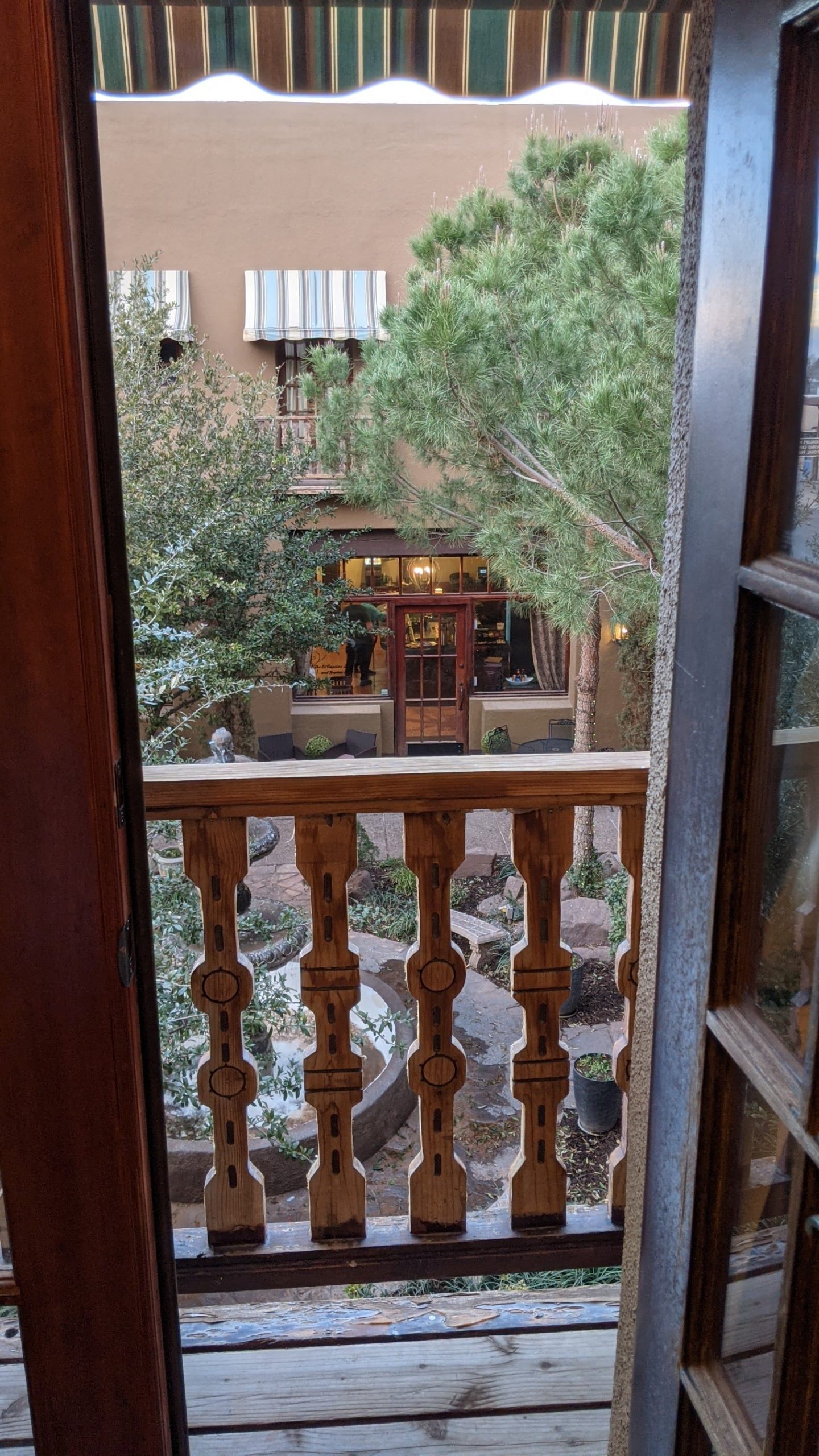
This time, we got a room with a balcony overlooking the iconic courtyard. Feasted at Chuy’s, West Texas’s version, then sipped tequila and margarita by the fountain and fireside. Great to be back in the Lone Star State!

Over and Under
February 21 would have been my dad’s 99th birthday. The hotel sits close to the railroad, and trains kept a-rollin’ all night long. The courtyard fountain sounded like rain. After a breakfast nearly identical to the time before, we checked out and continued east. A bank of clouds shielded the morning sun from our faces for a while.
Gomez Peak (6,276Ꞌ) be the northernmost prominence of the Davis Mountains. I-10 bends around it, and I-20 intersects there. Trees grow at the higher elevations, and maps show many springs. I made a mental note to return someday.
There are roadside parks, and there are fancy ones such as the Pecos County Safety Rest Area. In addition to the expected air-conditioned bathrooms, this 2018 installation features art, museum exhibits, storm shelter, playground, and walking trail. Rooflines and building shapes mirror nearby peaks and mesas. Large windows offer framed views of the Barilla Mountains. A similar facility serves westbound travelers.
Past Ozona, we steered south on RR 1989 to the Caverns of Sonora, a half-way respite I’ve long touted to migrants riding I-10. It was my second to Linda’s first visit. In time for the 1:00 tour, we shared lunch with a resplendent peacock.
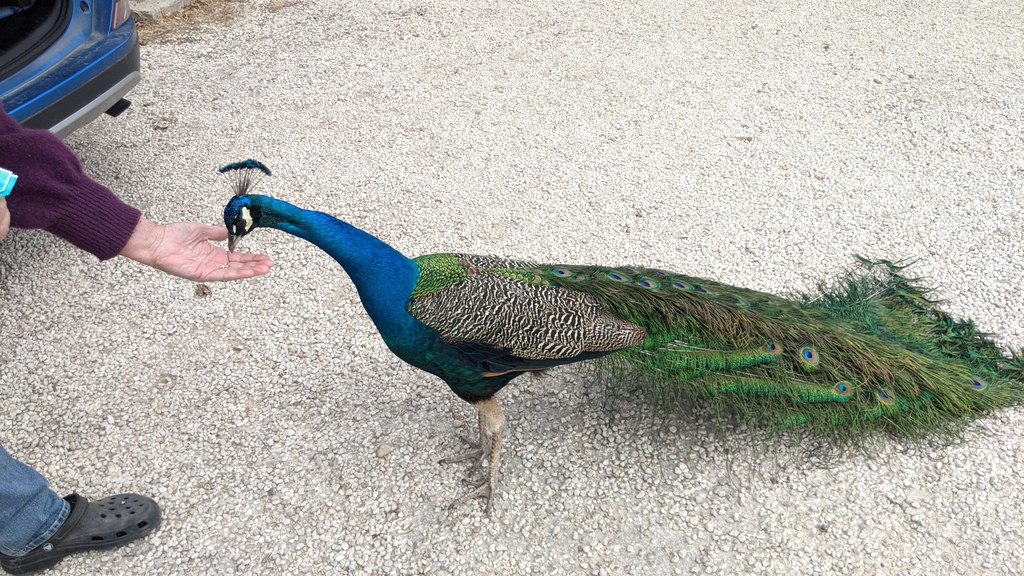
Mike, our guide, was a rover who recently settled into the job on this remote, family-owned working ranch. He and I exchanged plenty of banter and hole-in-the-ground jokes. These caverns are classified as a maze cave. Its subterranean path twists and turns up and down and every which way in between. First half is merely interesting, but the second simply bedazzles. Formations show intricacy and often defy gravity. Crystals deride description, as do the varieties of patterns.

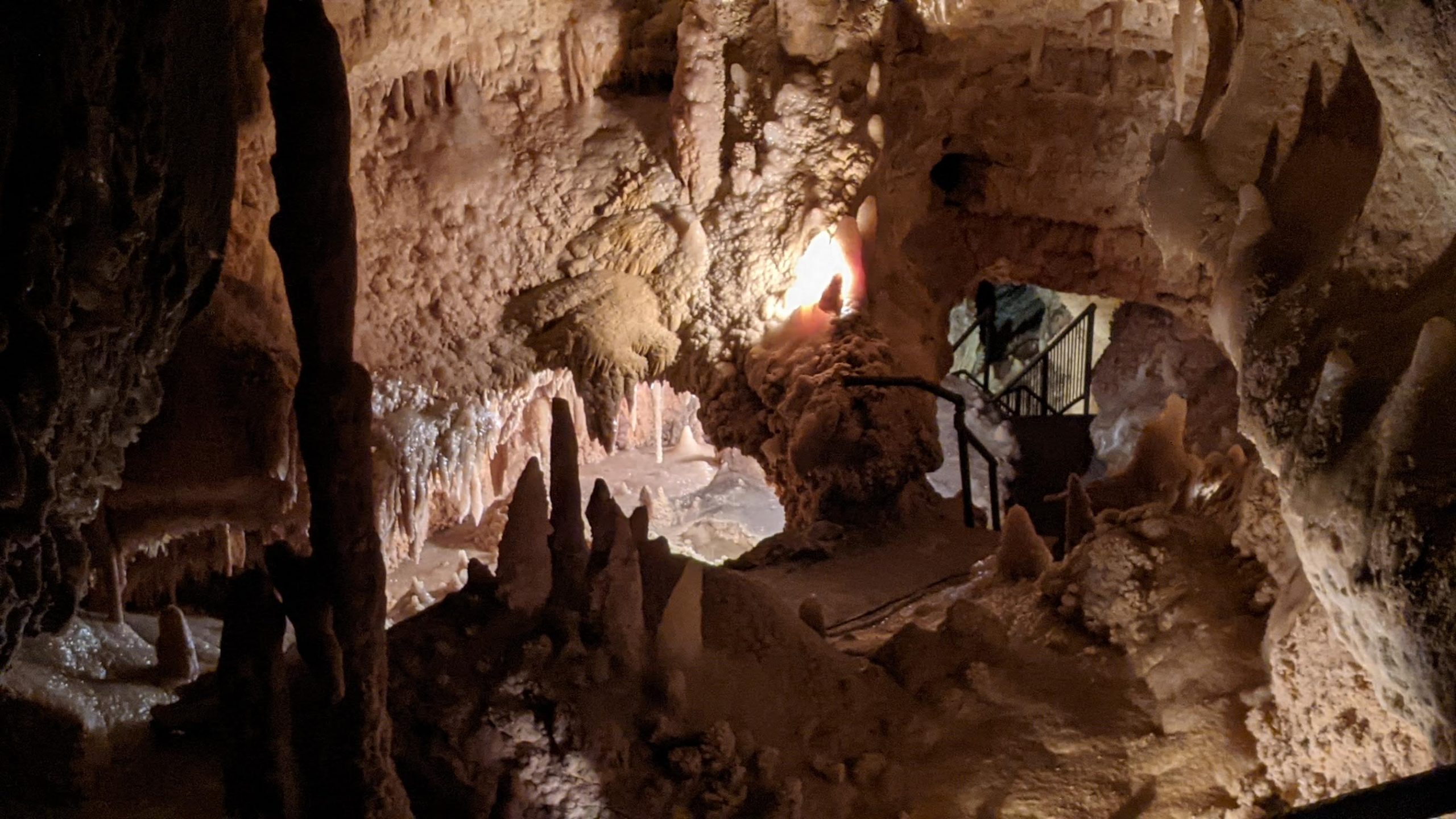
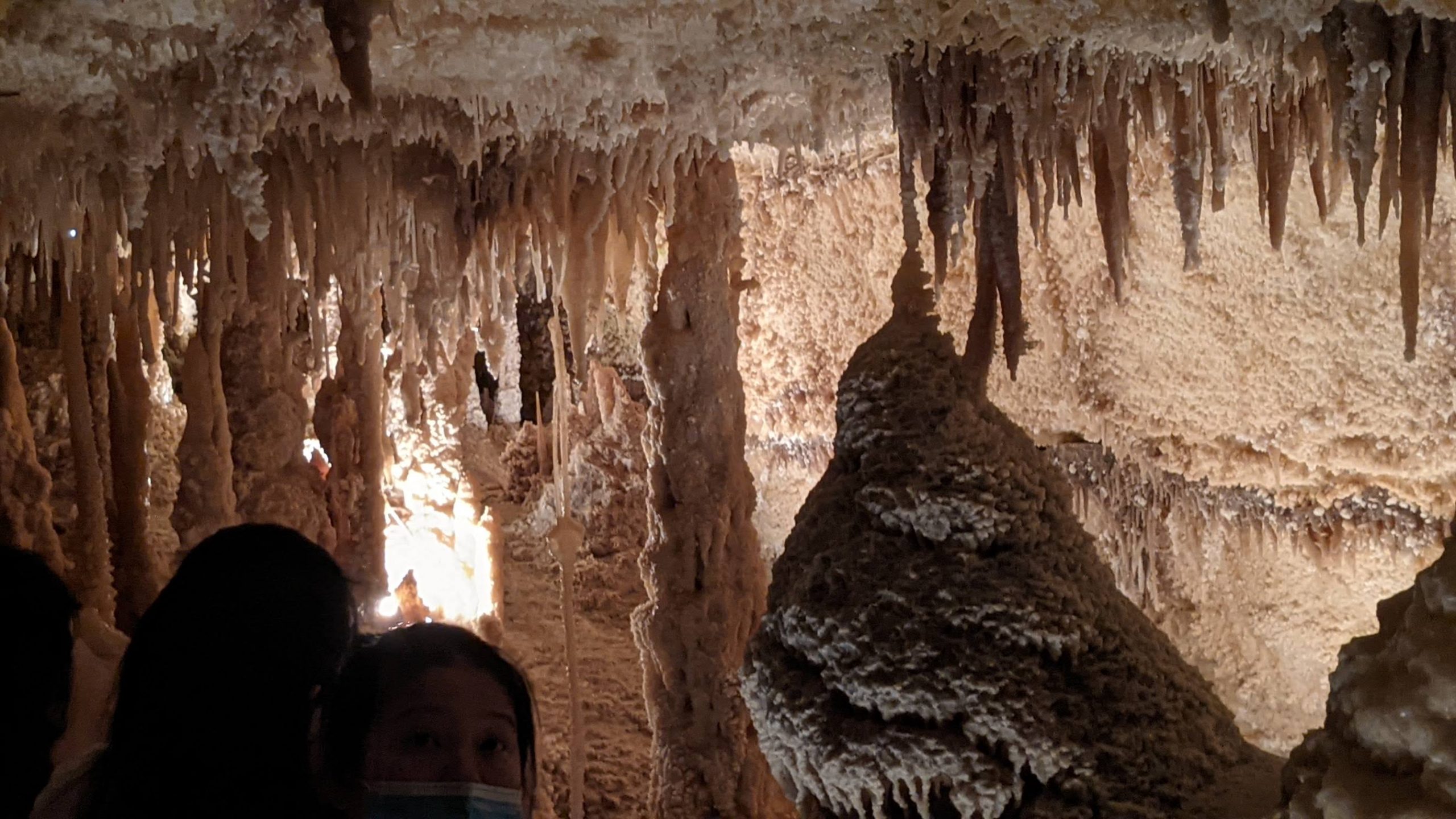
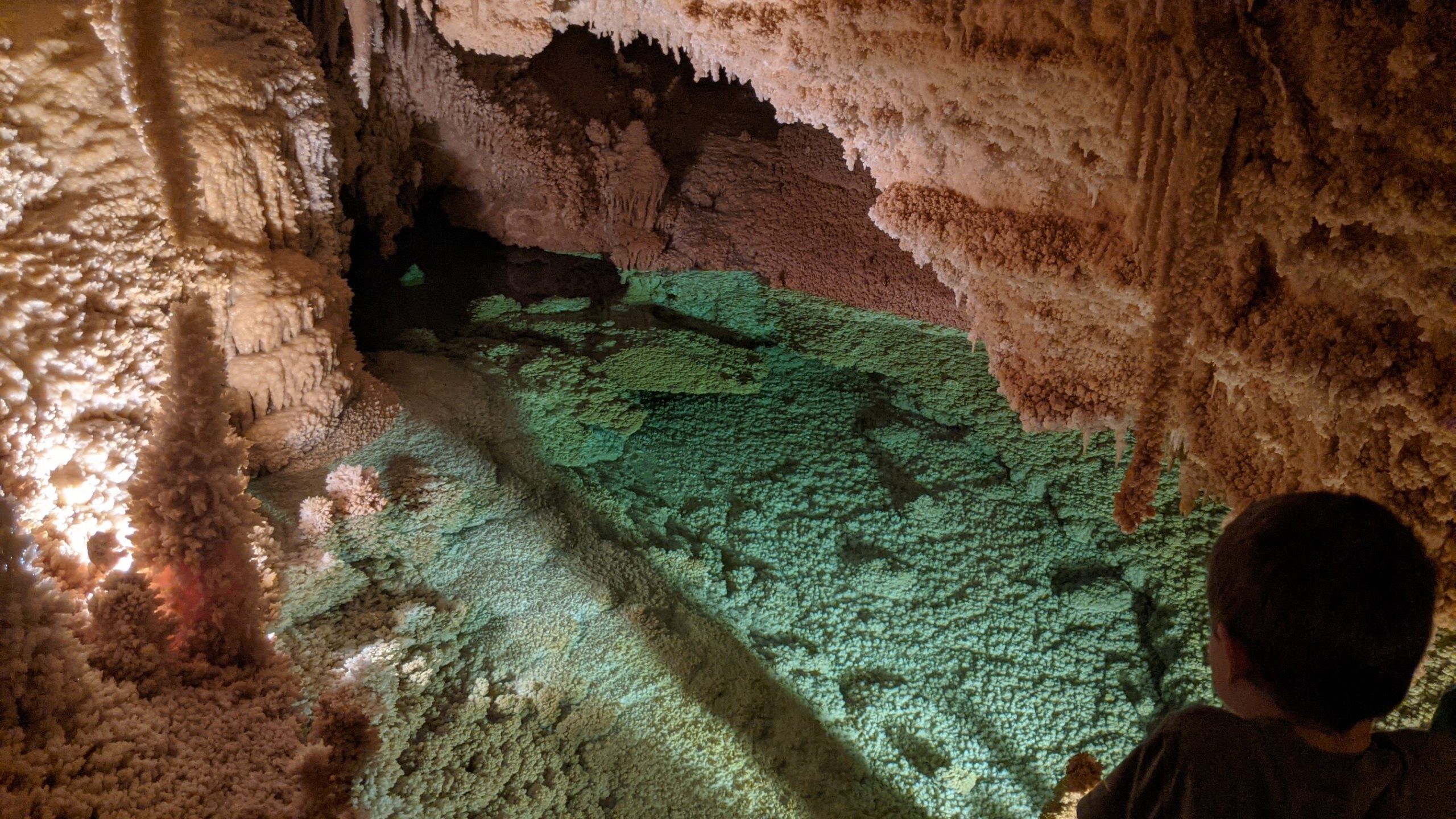
In addition to the foreseeable gift shop and snack bar, amenities include overnight camping for tents or RVs. Legs well stretched, we continued.
Tired of eating out of the ice box, we paused at Burger Burger in Fredericksburg for beef, sausage, onion rings, salad, pickles, and iced tea. Yours truly piloted ourselves through the deepening dusk to pull into the little place we call home at 7:30pm.
Ten days gone, 1,724 miles traveled. Farthest north: Gila Cliff Dwellings; farthest west: Boston Hill or Gila Cliff Dwellings. We’re already planning to get back.
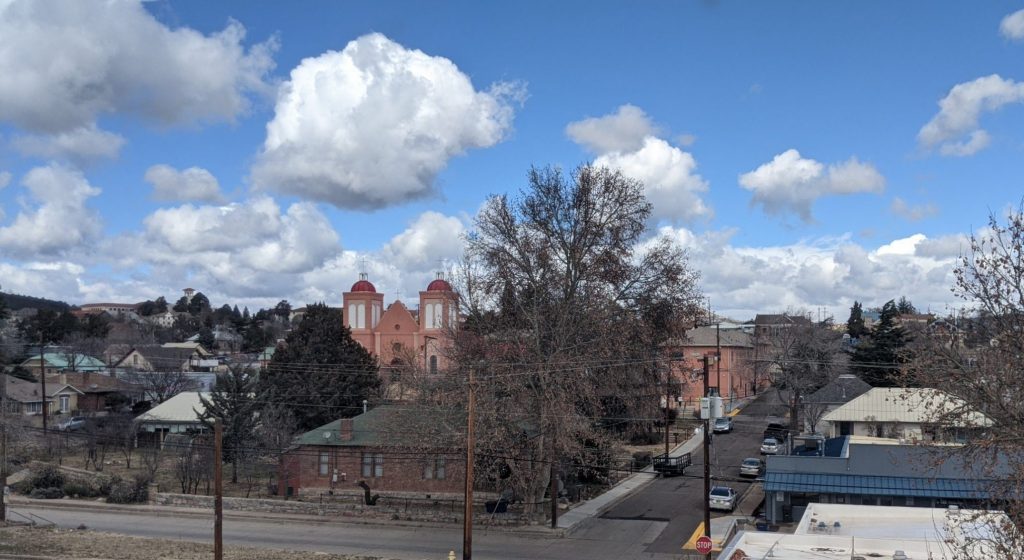

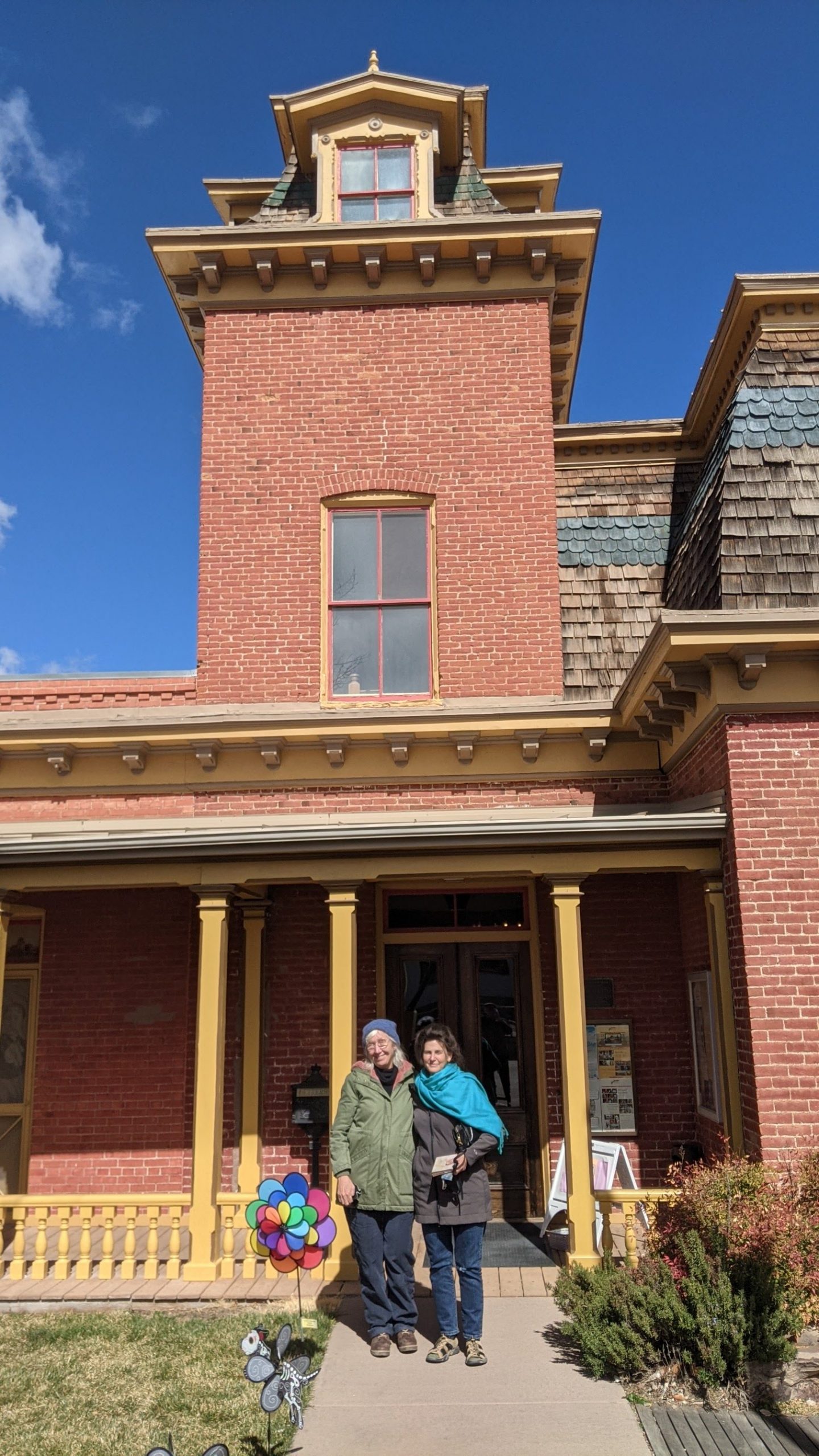
Comments
Great trip! Enjoyed reading about it. Nice photos too!
Finally got around to reading this. You all really know how to have fun and adventure. Great stories and great photos.